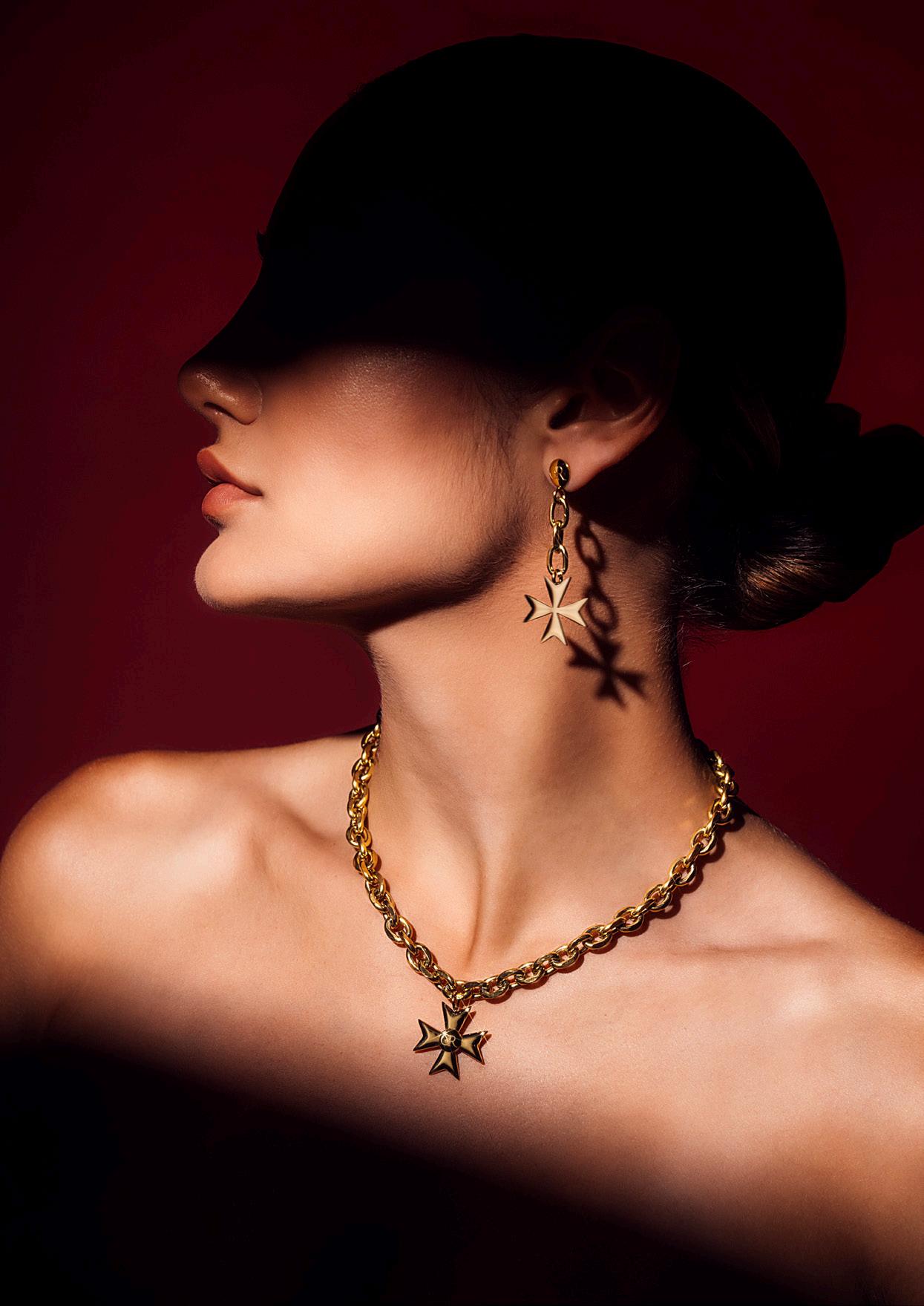
44
76 Vibing in elegant five-star settings Unique designer capsule collection celebrates culture through fashion


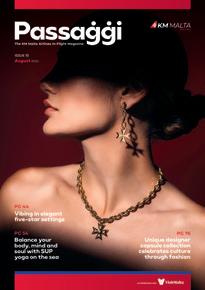
ON THE COVER
Exclusive Charles & Ron luxury accessories


44
76 Vibing in elegant five-star settings Unique designer capsule collection celebrates culture through fashion



Exclusive Charles & Ron luxury accessories
DESIGN
TBWA\ANG
EDITOR
Fiona Galea Debono
SALES AND BUSINESS DEVELOPMENT
TBWA\ANG
CONTRIBUTORS
Adriana Bishop
Anna Marie Galea
Coryse Borg
David Carabott
Dean Muscat
Inkontru.app
Lea Hogg
Leanne Ellul
WOULD YOU LIKE TO BE FEATURED IN PASSAĠĠ I?
For advertising opportunities, get in touch with TBWA\ANG on passaggi@tbwa-ang.com or (+356) 2131 0608
Abigail: abigail@tbwa-ang.com or (+356) 9929 0518
Ramona Depares
Vanessa Macdonald
COVER PHOTOGRAPHY
Daryl Cauchi
PHOTOGRAPHERS
Daryl Cauchi
David Carabott
Jeff Fabri
Joel Gueller
Jonathan Borg
Kenneth Scicluna
Kris Micallef
Kumitat Festa Esterna – Dingli
Kurt Paris
Pink magazine
Ramon Portelli
I /pasˈsadʒi/
Here’s the breakdown: • /p/ as in pass • /a/ as in art • /sˈ/ as in sun (with stress on the following syllable) • /dʒ/ as the sound of the j in 'judge' (geminated or doubled sound) /i/ as in eat
The word passaġġi means 'passages' in English.
The publisher, authors and contributors reserve their rights with regards to copyright. No part of this magazine may be reproduced or copied by any means without the written consent of the publisher. Editorial features and opinions expressed in Passaġġi do not necessarily reflect the views of KM Malta Airlines, the publisher, or the editorial team. Both KM Malta Airlines and the publisher do not accept responsibility for commercial and advertising content. Although the authors and publisher have made every effort to ensure that the information in this magazine was correct before going to print, the author and publisher do not assume and hereby disclaim any liability to any party for any loss, damage, or disruption caused by errors or omissions, whether such errors or omissions result from negligence, accident, or any other cause. Special thanks to KM Malta Airlines and VisitMalta for the provision of photographic material. Printed in Malta by Gutenberg Press. All magazine rights are reserved by KM Malta Airlines.
TBWA\ANG, 3rd Floor, Professional Building, Sliema Road, Gżira GZR 1633 Malta \ (+356) 2131 0608 \ tbwa-ang.com

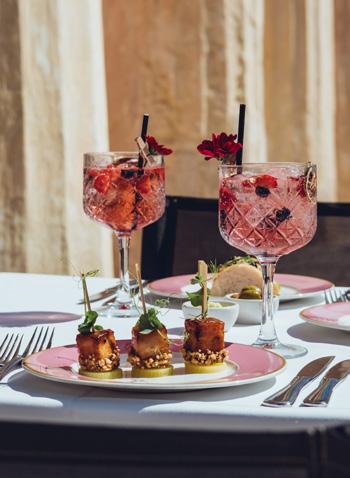

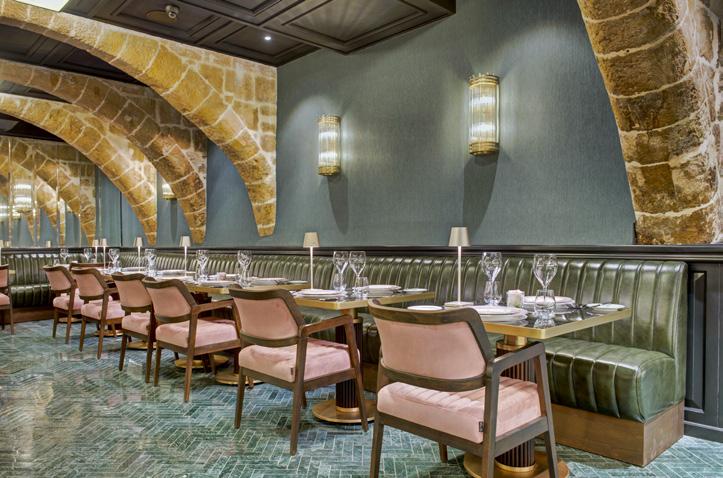




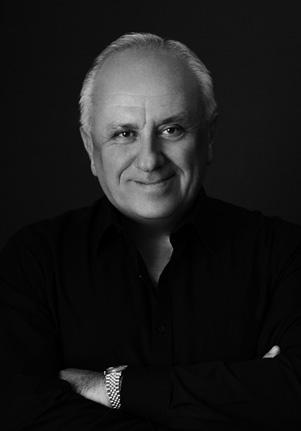
David Curmi
Executive Chairman KM Malta Airlines
August marks the peak of summer, and we are delighted to welcome so many travellers on board during what is traditionally the busiest month of the year for inbound tourism to Malta. With a vibrant calendar of cultural events, festas and an endless sunsoaked coastline to explore, this is the perfect time to experience all that our islands have to offer.
We are proud to share that KM Malta Airlines has been ranked the 4th Best Regional Airline in Europe at the 2024 Skytrax World Airline Awards. This prestigious recognition reflects the passion and dedication of our entire team, as well as the quality of our services. We remain committed to delivering a warm, reliable and distinctly Maltese experience to every guest.
As part of our continued commitment to our national identity, our website is now available in the Maltese language, giving customers the option to browse and book in their native tongue. We are also working on adding more language options in the coming months to make the KM Malta Airlines experience even more accessible to all.
This month also marks the launch of a special collaboration with Malta’s leading fashion house, Charles & Ron. Together, we’ve created an exclusive collection of luxury accessories, including two silk scarves, two silk ties and a curated jewellery set. These items are available exclusively from our Sales Office at Malta International Airport’s Departures area – perfect as elegant souvenirs or meaningful gifts that cannot be found anywhere else. Find out more on PG 76.
Also available at the Sales Office are our newly released KM Malta Airlines aircraft models – ideal keepsakes or collector’s items for aviation enthusiasts of all ages.
We continue to enhance our customer experience both in the air and online. Our chatbot and live agent support at help.kmmaltairlines.com provide fast, convenient assistance whenever you need it.
If you haven’t already, we invite you to sign up for KM Rewards, our loyalty programme that lets you earn SkyBux and Status Points every time you fly with us. Points can be redeemed for flights, upgrades and a variety of other benefits – helping you get more from every journey.
Looking ahead, our Winter 2024/25 schedule is now live on our website. With popular destinations and convenient flight times, now is the perfect moment to plan your autumn and winter getaways.
Thank you for flying with KM Malta Airlines. Whether you're returning home, discovering Malta for the first time, or setting off on a summer adventure, we are proud to be part of your journey. Wishing you a relaxing and enjoyable flight.


Fiona Galea Debono Editor
Merħba! Welcome to the August edition of Passaġġi, your in-flight companion into the heart and soul of the Maltese Islands.
The heat is on, and August in Malta is not for the faint-hearted – it’s high summer, when the days are long, the sun is blazing, and the islands pulse with life. But beyond the postcard-perfect beaches and the vibrant nightlife, there’s an authentic Mediterranean rhythm that’s uniquely Maltese, and this month, we’re diving right into it.
Yes, we’re a party island – our clubs and open-air festivals are legendary – but there’s another side to the nightlife here. In this issue, we explore serene evenings spent in elegant palazzo gardens and five -star properties, where soft jazz and masterful cocktails meet under even more stars. It’s glamour of a quieter kind, but no less unforgettable.
Culture is also in full bloom. From the Malta Mediterranean Literature Festival, where words transcend borders, to indie and alt rock concerts held for noble causes, August proves that even in the heat, Malta never stops creating, celebrating and sharing.
15th August marks Santa Marija, one of the country’s most beloved feasts – celebrated with a powerful blend of faith, pageantry and community. We visit one of the towns at the heart of the festivities and reflect on the historical significance of this date during WWII’s Operation Pedestal and the story of the Santa Marija Convoy, when Malta’s spirit of resilience shone at its brightest.
For those seeking balance, we discover how stand-up paddleboard yoga redefines wellness on the water.
Hungry? There’s nothing quite like local cuisine to tell a story. From the humble Froġa tat-Tarja to a buzzing new generation of restaurants, Malta’s food scene is having a moment. And when it’s time for something sweet, we’ve found the ice cream truck that serves more than gelato – it scoops up heritage, memory and family love.
Style soars too. We unveil the new Charles & Ron exclusive accessory line for KM Malta Airlines – Mediterranean elegance available only from Malta International Airport for that perfect gift – and catch up with First Officer and content creator power duo, Sarah and David Vella Zerafa, who embody fashion, flair and love in full flight.
For a touch of furry fun, Roy the toy poodle gives us his Gozo travel tips for pets on the go – because even jet-setters come on four legs.
And if you want to blend in like a local, we’ve even prepared a mini Maltese language guide. A simple grazzi or merħba goes a long way in making connections and warming hearts.
So, whether you’re here for the sea, the culture, the cocktails, or just the joy of discovery, this August, we invite you to live it all – the Malta way.
Enjoy the ride!

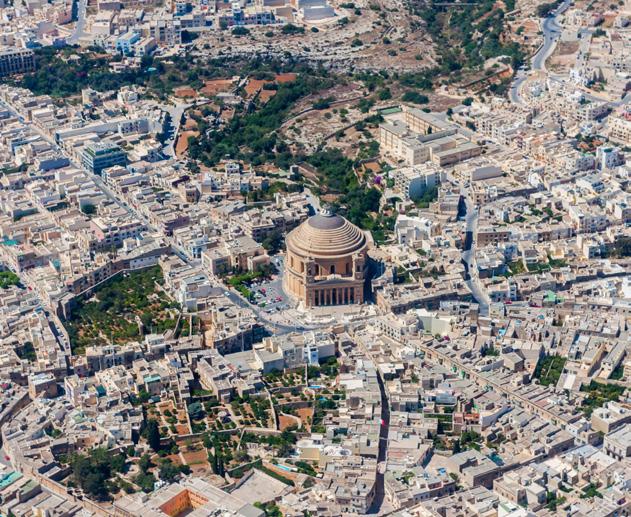
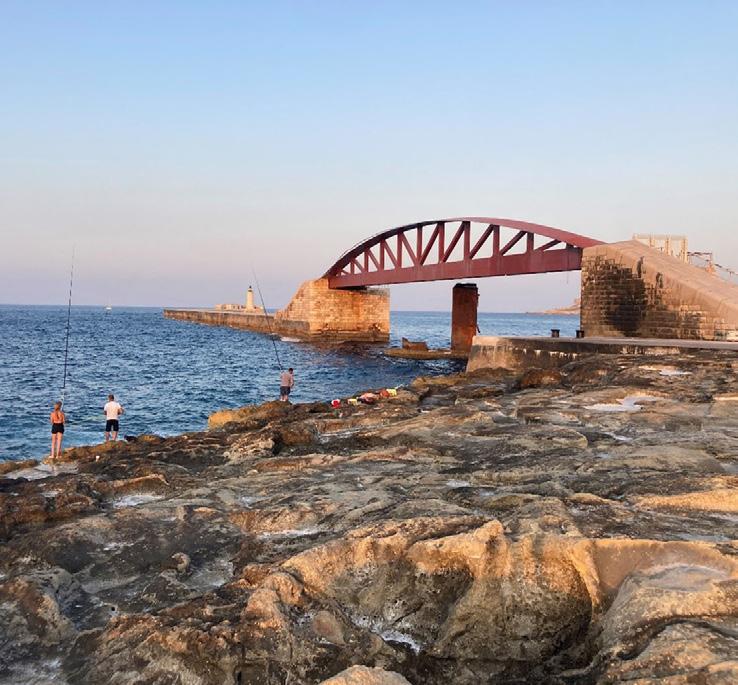
ISLANDS
10
Mosta – beyond the iconic Rotunda
Where everyday life hums with history
TRAVEL
18
Milan – where style is queen
Italy’s powerhouse metropolis
22
Tokyo translated For an incredibly hip tourist destination
HISTORY 27 A voyage that shaped Malta
The story of the Santa Marija Convoy BOOKS
31
It’s a kind of literary magic
Malta’s book scene and literature festival
CULTURE
34
This month’s must-see events
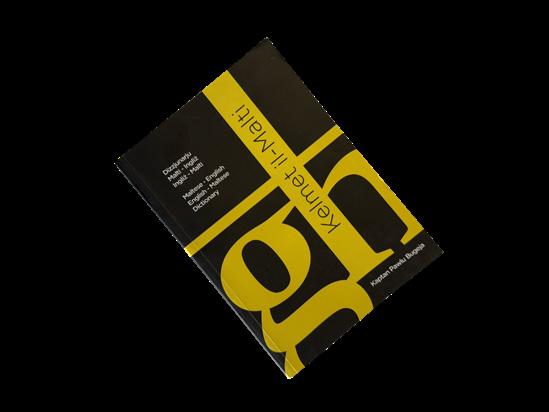
Soak up every drop of Mediterranean summer to Malta!
Your essential Maltese language
Enjoy the vibe of a Maltese summer
Elegant and authentic evening escapes
ACTION
54
Great for mind, body… and soul
SUP yoga is the seaside way to rebalance
MUSIC
63
Three decades loud: rocking for Richmond
Indie band Beangrowers rewinding the tape
PEOPLE
66
High-flyers
When romance takes off and goes viral
PETS
72
Tails on tour: Gozo edition
Your four-legged guide for a pawfect day out
FASHION
76
Flying in style
Designer-airline collaboration launches exclusive accessory collection
FOOD
80
Milkshakes, memories… and a Maltese soul
Telling stories through food
87
L-ikla t-tajba!
Innovative, welcoming and buzzing restaurant scene
AIRLINE NEWS
92
Flight, company and destination information
All you need to know about flying with KM Malta Airlines



Words by Lea Hogg
Lea is a Malta-based journalist and writer, known for her TV programme on current affairs, cultural news and in-depth interviews about politics and global issues.
The dome and the drama of feast days aside, Mosta offers a quieter magic – a town where everyday life hums with history, local flavour and the kind of charm that doesn’t try too hard. This is Mosta lived, rather than just visited.

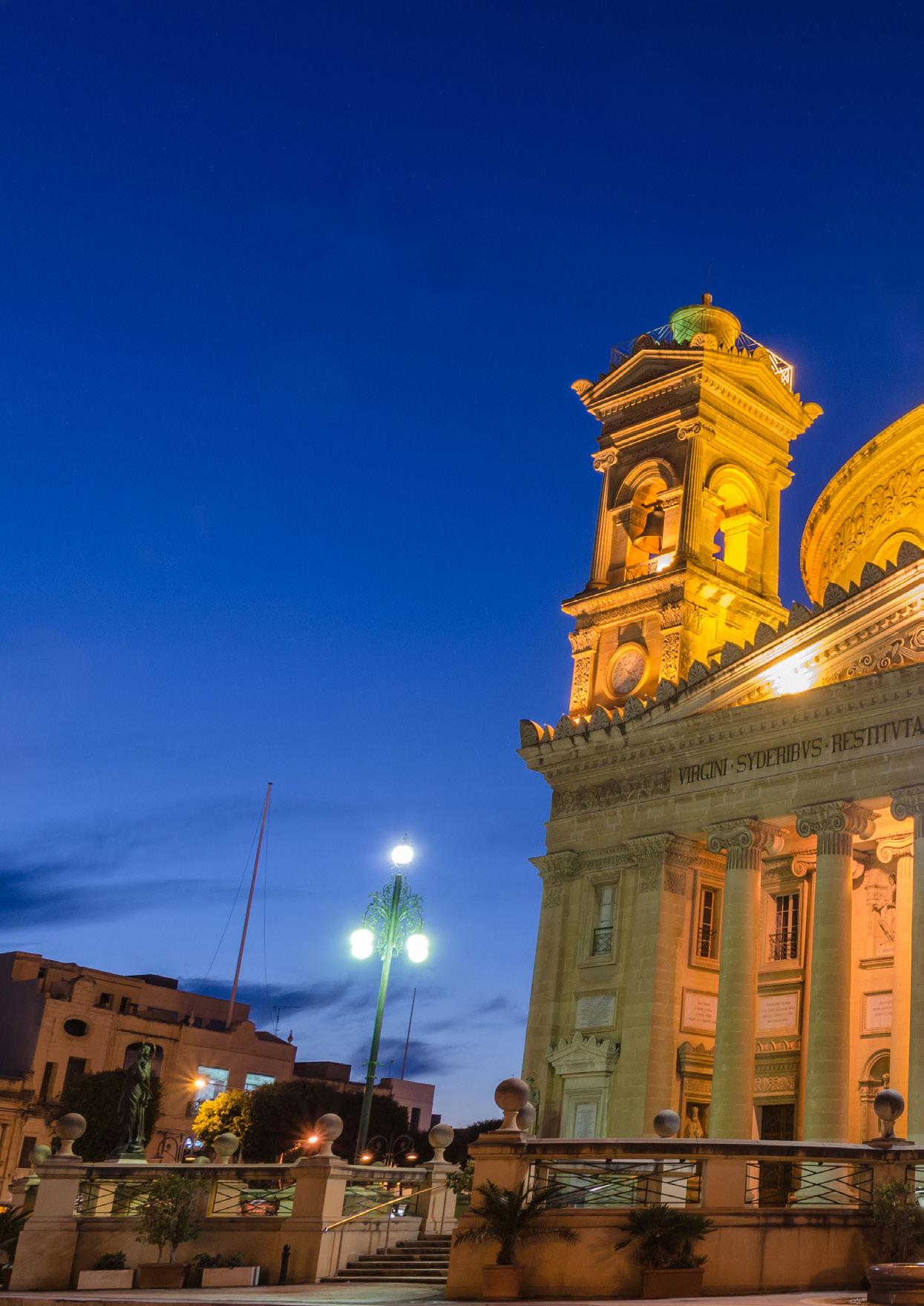

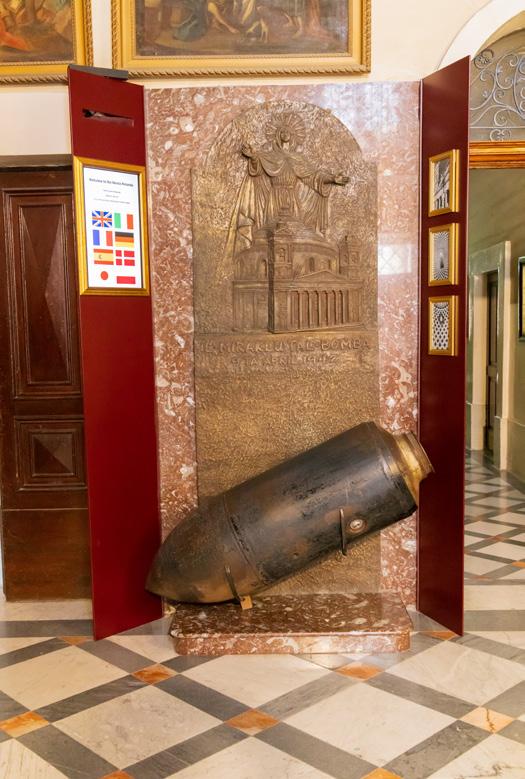
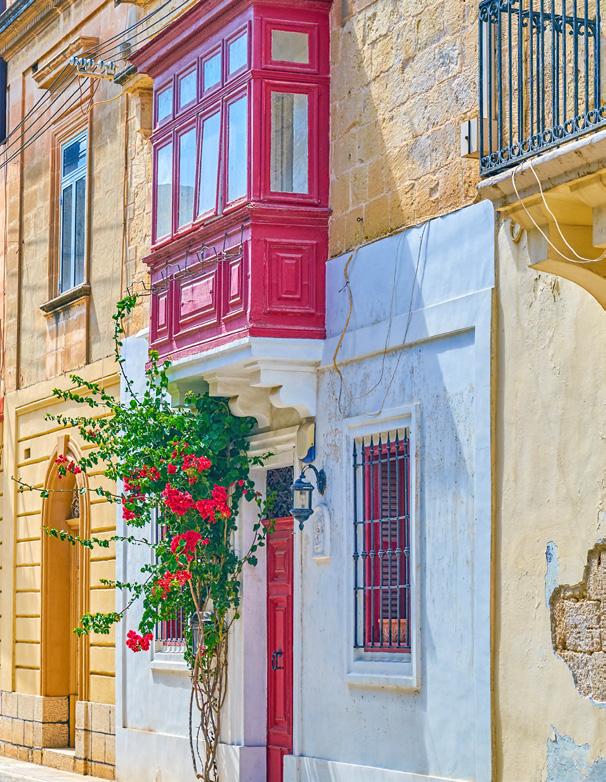
I moved to Mosta one August a few years ago, right in the thick of the feast season. For two weeks leading up to the 15th, the town transforms for the grand celebration of Santa Marija. Streets light up with dazzling displays and festoons, while the town bands rehearse in the open, their music spilling through the neighbourhood and coaxing people out of shops and onto balconies.
On the feast day itself, the procession carrying the statue of the Assunta through Mosta’s lively streets is a spectacle that never fails to draw locals and tourists alike into a shared moment of community, faith and pure Maltese spirit.
Mosta is neither a bustling town nor a sleepy village but sits somewhere in-between. It is large enough to boast a surprising array of shops, from quirky independent boutiques to familiar chains where you can pop in for whatever you may need. Yet it hasn’t lost the charm that makes Maltese towns feel like home.
What’s especially clever about Mosta is its position, just a short drive from the coast of St Paul’s Bay and the northern tip of the island, meaning the beach is never far away when
the mood strikes. You get the best of both worlds: inland convenience and easy access to the sea breeze.
Limestone façades frame narrow streets, dotted with colourful doors, retro furniture shops and balconies bursting with character. When you live in Mosta, you feel history as you walk through it. Yes, there’s a lively buzz in the main square, but wander just a few blocks away and you’ll find a different rhythm – quieter, more intimate.
I used to love taking my daily walk over the Wied il-Għasel bridge. It was part workout, part postcard view. Knowing it was built by the British military adds a touch of history to every step. In spring, it's like a natural filter with no edits needed. It’s a place where the past quietly thrives in the present.
Mosta’s roots go back to prehistoric settlements, with Bronze Age remains and even Roman villas unearthed in the area. But it’s the Rotunda that truly anchors the town’s identity. Completed in 1860 after 27 years of construction, the church was built by local stonemasons without formal architectural training, inspired by Rome’s Pantheon.
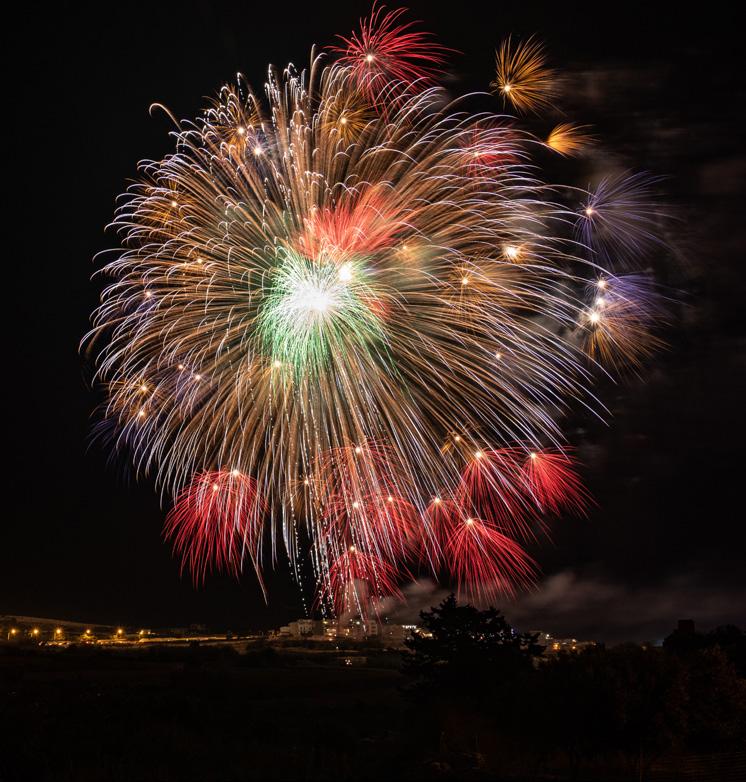
suggests
History in Mosta is also baked into the crust of a well-loved pie, a dish that’s as unpretentious as it is

The pumpkin and rice pie, torta tal-qargħa ħamra u r-ross, is honest food, born from the earth and sea, brought together by generations who knew how to make every bite count.
And then there’s the wartime miracle of April 1942, when a German bomb pierced the dome during Mass but didn’t detonate. A replica of that bomb is now displayed inside the sacristy.
Despite its size and modern conveniences, Mosta has retained a traditional Maltese heart. It is refreshingly free of high-rise towers and American-style apartment blocks that can blot the landscape. Instead, you find narrow streets and balconies draped in drying clothes and blooming plants, just as they’ve been for generations.
For all the charm and history of Mosta, what truly makes it feel like home is the handful of places I still return to week after week, even though I no longer live there. These are the local gems that quietly outperform flashier outlets elsewhere, run by people who know their craft, and know your name too.
Here, the rhythm of life still beats to a distinctly Maltese drum, a mixture of neighbourly chatter, church bells, and the steady hum of everyday life that’s anything but rushed. You can still feel Malta in Mosta, not just see it. It is a place where the old and new sit comfortably side by side; where tradition hasn’t been sacrificed for convenience; and where every corner invites you to slow down, breathe and soak it all in. Mosta leaves a lasting impression on anyone who takes the time to look beneath the surface.
The filling starts with onions and garlic sweating gently, pumpkin and rice simmered to soft perfection, then punched up with a salty hint of anchovies, tuna, capers, olives, even a touch of sweetness from sultanas.
It’s a flavour profile that sneaks up on you, wrapped tight in a flaky, sesamespeckled crust, golden and crisp from the oven. I was introduced to it by Antida Vella, the matriarch of a Mosta farming family, as part of Mosta’s history you can taste.
Words by Heritage Malta
The national agency for museums, conservation practice and cultural heritage, it is the guardian of over 8,000 years of history.
If this is your first visit to the Maltese Islands, you cannot leave without ticking these sites off your list.
Imagine… a bright new morning with just the right wind; a miller letting the locals know by blowing through a triton shell; the villagers bringing their cereals to be ground into flour. Ta’ Kola Windmill is a unique relic of breadmaking in Gozo, transporting you back to such a morning. This 300-year-old building is a living testimony to our forefathers’ way of life, marked with hardships and daily struggles, at a time when bread was the most indispensable food item. The exhibits inside the windmill belonged to the last miller residing there and were used to operate and maintain the building and milling mechanism.
Leave the sights and sounds of modern life behind you as you step down into another world – a burial ground from Punic, Roman and Byzantine times, representing the earliest and largest archaeological evidence of Christianity in Malta. The catacombs form a typical complex of interconnected underground Roman cemeteries that were in use up to the 7th and possibly the 8th century AD. Part of the catacombs was re-utilised during the re-Christianisation of the island, around the 13th century, when an open space was re-cut and used as a Christian shrine decorated with murals.
Have the honour and the privilege of stepping inside a UNESCO World Heritage Site! Discovered in 1913 by farmer Lorenzo Despott, the Ħal Tarxien Prehistoric Complex consists of four megalithic structures built in the late Neolithic and then re-adapted for use during the Early Bronze Age. The site was excavated between 1915 and 1919 by Sir Themistocles Zammit, Director of Museums at the time. This year marks the 110th anniversary since the first sketches of the site were made by Zammit himself during the initial excavations.
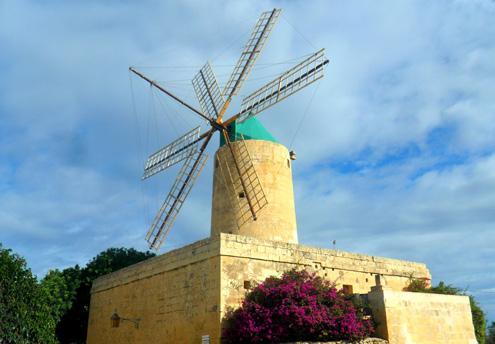

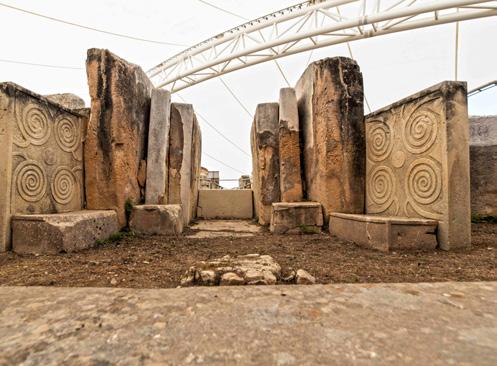
If you head down to the fascinating prehistoric site of Għar Dalam, don’t miss the opportunity to visit Borġ in-Nadur, located just 500m away. Excavated in the 1920s by eminent archaeologist Margaret Murray, Borġ in-Nadur yielded crucial information that helped our understanding of facets of Maltese prehistory, which had until then remained problematic, such as the differences between the Neolithic Period and the Bronze Age. Excavations conducted by David Trump in the 1950s uncovered Bronze Age huts, further enhancing the significance of this site.
No other fortress has been engaged with the same intensity in the shaping of Malta’s destiny as Fort St Angelo! Known as Castrum Maris in medieval times, this stronghold was christened as Fort St Angelo by the Knights of the Order of St John, who turned it into their headquarters. They remodelled the building extensively with the construction of a series of artillery platforms that marked the introduction of the bastioned system of defence on these islands. During the British period, the fort served as a shore establishment of the Royal Navy in Malta until the last detachment of foreign forces marched out of its walls in March 1979.
This year is very special for these two sites, as the National War Museum celebrates the 50th anniversary since its inception and Fort St Elmo commemorates the 10th anniversary since it opened its doors to the public. The splendid, unobstructed views of Grand Harbour, enjoyed today from Fort St Elmo, originally served the purpose for which the star-shaped fort was built – to face and hold back the wrath of the Ottoman armada. Indeed, the fort received the brunt of the Ottoman forces during the Great Siege of 1565, resisting for a month against all odds until finally surrendering on 23rd June. The National War Museum, located within the fort, covers 7,000 years of Maltese military history from the Bronze Age until Malta’s accession to the EU. Notable artefacts include military armour of the Order of St John and the Ottoman Turks, and Malta’s award for gallantry during World War II – the George Cross.
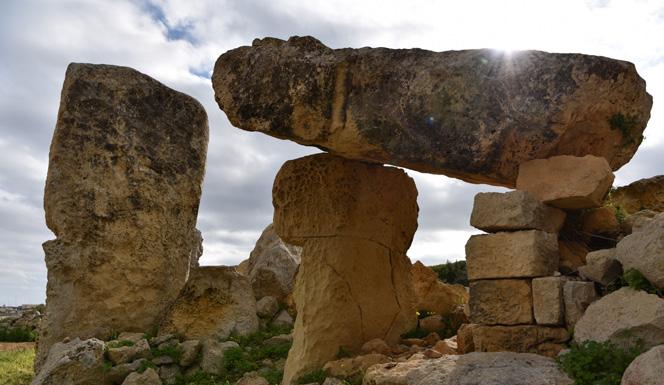
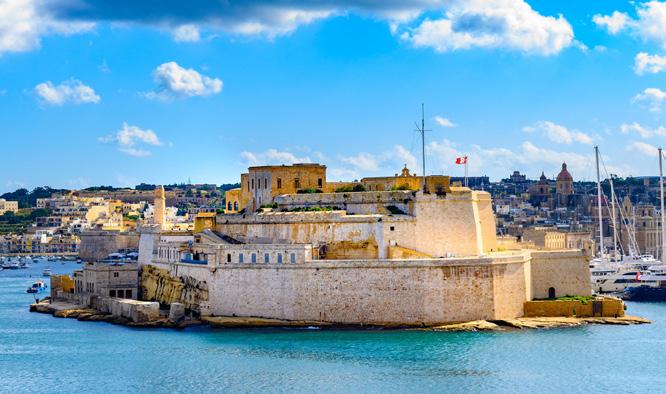









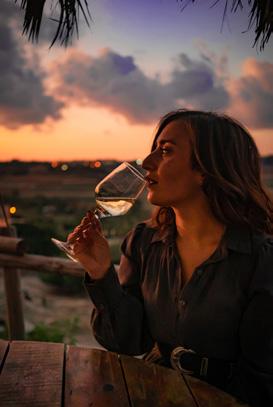

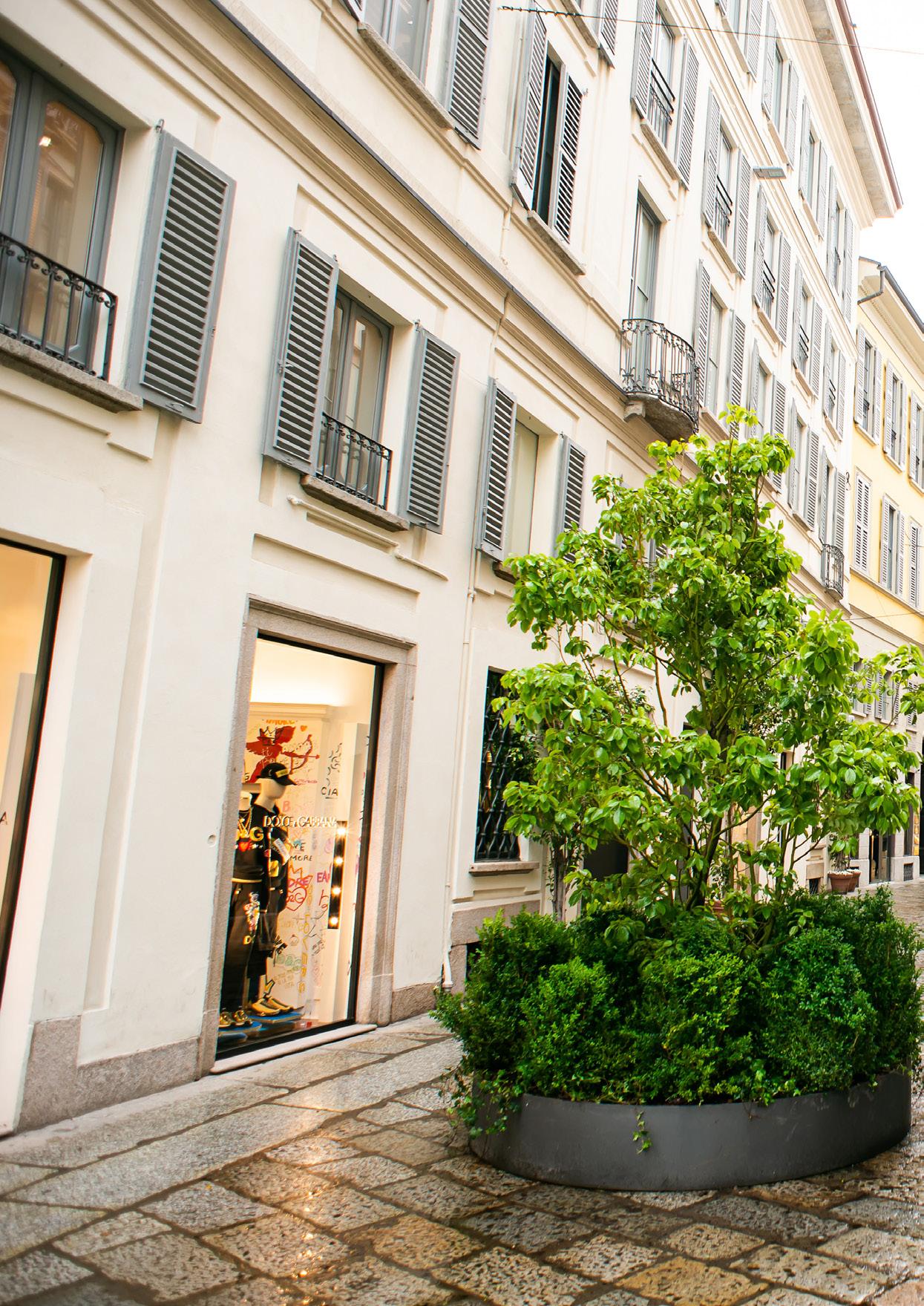

Words by Adriana Bishop
Adriana is a former news journalist and travel PR executive, now a freelance writer based in Switzerland, with her heart and eyes always set on her forever home Malta.
The ultimate city break for fashionistas and culture buffs, Italy’s powerhouse metropolis is also the gateway to the rest of the continent, with excellent train connections. But first, there is this handbag in the window…
…and I have been drooling at it for the past five minutes. It is exquisite. Stylishly sophisticated. Effortlessly elegant. An ode to craftsmanship and design. Butter soft leather with gold detailing. And would match with everything. And it’s eye-wateringly expensive. Or, to put it differently, it’s the equivalent of two months’ salary, or possibly three.
I sigh longingly and move on. Welcome to Milan. The capital of fashion and design, where money struts around on designer stilettos, and if you need to ask the price, then you probably can’t afford it.
Milan does not need to introduce itself. It makes its own statement in just one word: Milano. The economic powerhouse of Italy, it hasn’t just taken a seat at the table of global cities – it has designed its own chair. Milan has been on the frow of European political, economic and cultural history since the ancient Romans established it as the capital of the Western Roman Empire.
Today, it is Italy’s wealthiest city, second only to Rome in terms of population and as a tourist destination. It presents itself with the chutzpah of a grande dame who has lived a long and colourful life, with no apologies, and is ready to continue setting standards for everyone else to follow. My taxi driver tells me “they are trying to transform it into a little London” and bemoans the rising cost of living, but he confesses he is “still in love with her”.
While it is the undisputed queen of design, Milan is more than just the Quadrilatero della Moda, that block of uber-expensive and uber-gorgeous designer shops along the city’s four most famous streets: Via della Spiga, Via Montenapoleone, Corso Venezia and Via Manzoni.
I have been a regular visitor to the city for several years as I am lucky enough to have a direct train from Zurich, which brings me to the Italian city (and a much longed for MiTo in the sun, the iconic cocktail made from Vermouth Rosso and Campari) in just over three hours.
On one of my earliest trips, I joined three other friends, all new mothers like me, giddy with delight at being let off mum duties for 48 hours. We snuck a bottle of prosecco on board our early morning train and giggled like schoolgirls all the way across the Alps as we wrote down an extensive list of all the shops we wanted to visit.
recommends
LUNCH Biancolatte: a short walk away from the centre, ideal for brunch or a perfect coffee any time.
Maio – La Rinascente: the more upmarket offering on the top floor of the famous department store.
Obicà Mozzarella Bar – La Rinascente: the more relaxed eatery on the top floor of the department store, where mozzarella features in almost all the dishes.
Max Mariola: the genial YouTube chef now runs a restaurant and a bistro in Milan. Order his famous Carbonara and he’ll cook it for you at your table.
DINNER
Ristorante Casa Lucia, Via Carlo Ravizza, 2 – authentic and relaxed.
Paper Moon Giardino, Via Bagutta, 12 – chic restaurant in an idyllic garden.
Our annual girls’ trip to Milan is now a fixture on the calendar, and I must confess that I probably know a lot more about the retail side of the city than any of its cultural attributes (insert embarrassed emoji here). I suspect I am not the only one. With the exception of the throngs of tourists who queue patiently under a baking hot sun to visit the Duomo and book tickets several months in advance to view Leonardo da Vinci’s Last Supper, I am certain the majority of Milan’s visitors have only one thing on their itinerary: shopping.
Which is a pity, because the city is home to some of Italy’s, if not Europe’s, most important museums and cultural sites, dominated by that breathtaking confection of gothic marble that is the Duomo, with its forest of spires and blindingly white façade, which shines as bright as the moon on a summer evening.
Now, I am not a complete heathen, and on occasion I have dragged myself away from those credit-card-draining shops to feast my eyes and feed my soul on some of Europe’s finest art and culture. The Pinacoteca di Brera art museum is a veritable balm for the senses.
In recent years, I have taken to wandering around this immensely walkable city, following my curiosity rather than Google Maps, to discover hidden gems behind monumental palazzo doors, not to mention quirky little bars that only the locals know about, like the Renault showroom that serves excellent drinks.
It was on one such walk that I came across the Museo Bagatti Valsecchi, the 19th-century former house of two wealthy brothers, the barons Fausto and Giuseppe Bagatti Valsecchi, who stuffed their home (read: mansion) between Via Gesù and Via Santo with a collection of artwork and treasures that is still the envy of billionaires today. There was only one other person viewing the house that afternoon, and for those precious moments, we could pretend we were the owners, floating through jaw-dropping riches in perfect silence, away from the madding crowd outside.
In fact, one of the joys of visiting museums in Milan is purely the opportunity to escape the masses and indulge in true cultural R&R.
One sweltering August afternoon, an Italian friend suggested we should visit the local cemetery. Before I could protest, she had bundled me into a taxi for a quick whizz across town to the Cimitero Monumentale, one of the two largest cemeteries in Italy. I would have never considered adding this to my holiday must-see sites until I learnt that it is a true testament to Milan-ness, an intrinsic part of the city’s history as the final resting place of all Milan’s great and good from the world of arts and culture, including Alessandro Manzoni, Dario Fo, Giorgio Gaber, and the celebrated prima ballerina Carla Fracci, to name but a few. They are all hosted at the Famedio, better known as the Temple of Fame.
After a contemplative hour tiptoeing past ornate marble gravestones, I was ready to go back to a more contemporary, living shrine to Milan-ness, and hopped into another taxi towards Fondazione Prada, housed in a converted distillery, with its iconic solid gold façade (hence the heavy security presence outside) and its whimsical Bar Luce designed by Californian director Wes Anderson.
All this sightseeing and shopping (it’s a sport, you know) has made me hungry, and Milan does food on the same scale it does fashion – with inimitable style. I had already spotted a queue outside Louis Vuitton’s Da Vittorio Café, nestled in the former courtyard of Palazzo Taverna on Via Montenapoleone.

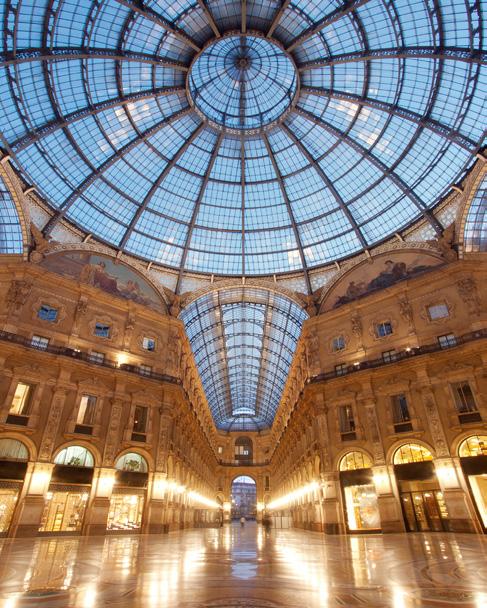
But that’s too nouveau riche for me (or, put simply, my writer’s fee does not stretch that far). I prefer to stick to the classics and head to Cova, a 200-year-old institution, for a cup of coffee and a slice of tradition, before crossing the road to Marchesi to stock up on my favourite pastel-coloured sugared almonds. I keep a bag in my desk drawer to see me through long newsroom shifts.
Aperitivo time is elevated to aperi-cena here, my favourite hour of the day, where cocktails are served with free plates of delectable pieces of focaccia, olives, cold cuts and whatever the bar fancies. It’s free, so I never complain.
This evening, I am meeting a group of friends from London at Casa Lucia in the De Angeli area for a taste of authentic Italian deliciousness, served with a side of flair. We’re a rowdy bunch, excited to see each other after long months away, but it is the next table that apologises to us because their baby is crying. We burst out laughing as we are all parents ourselves and we are definitely louder than this little newborn. We soon find out they are a family celebrating the baby’s baptism and, of course, they are doing it in style, especially the ladies who look like they’ve just stepped off a catwalk. The proud grandpa welcomes us cheerily and heartily to Italy and we’re all firm friends now.
No Saturday night is complete without a stroll along the Navigli canals to soak up the movida nightlife, which can sometimes get a little bit too exciting. But it seems that, these days, the movida travels across the city on board disco trams. One of them pumps and rattles along the street, packed with party people bobbing along to a funky DJ. Hey, wait for me!
We retire to a quiet, unassuming roadside vineria for that one last drink (or three); a little hole in the wall with tables crafted out of oversized wine barrels. Good company, good wine, good cheer – at that precise moment, there was nothing else I needed in life.
Perhaps the cherry on the cake of a visit to Milan is a ticket to La Scala, the most famous opera house in the world. So revered is this theatre in Italy that the season opener on 7th December, the feast day of St Ambrose, Milan’s patron saint, is broadcast live on the national TV station Rai and is attended by both the President and the Prime Minister alongside a full cast of celebrities and illustri
For me, nothing is more magical than a night at La Scala, and I was recently treated to a most memorable evening watching the London Symphony Orchestra under the baton of Maestro Antonio Pappano. I think I shall frame the ticket.
I like to end every visit to Milan with lunch on one of the rooftop restaurants above La Rinascente, always hoping for a coveted table along the edge with the best view of the Duomo. But first, I earn my risotto Milanese with a final walk, negotiating my way through the crowds inside the opulent Galleria Vittorio Emanuele, trying not to stop too long to admire the first edition art books at Libreria Bocca, the oldest bookstore in Italy.
I step out onto the expansive Piazza Duomo, take the obligatory selfie, and head towards the medieval Sforza Castle. I could spend all day in here, wandering through its eight museums. But, as always, I am tight for time and I am kicking myself that my vanity had clouded my judgement when I failed to pack more sensible shoes instead of my flimsy (but stylish – hey, it’s Milan after all) sandals.
A weekend in Milan is never enough –although my credit card would claim otherwise. But I know it will always be there, even if only for a quick lunch stop on my way to visit Torino, Como, my beloved Bologna, Florence or even Venice.
suggests
kmmaltairlines.com
And with one last Campari Spritz, I bid arrivederci to a city that will never go out of style.
Palazzo Reale, the former seat of government, is now the centre of all things cultural in the city. Next exhibitions: the art of surrealist artist Leonora Carrington and a tribute to experimental pioneering artist Man Ray.
Basilica of Santa Maria delle Grazie, which houses Leonardo da Vinci’s The Last Supper in its refectory. While there, pop into Leonardo’s vineyard in the courtyard of the nearby Casa degli Atellani.
Basilica of Sant’Ambrogio, founded in the 4th century and one of the oldest churches in Milan.
Leonardo3 – the World of Leonardo, an interactive museum dedicated to Leonardo da Vinci’s incredible inventions. A treat for kids of all ages.
It’s Fashion Week every day on the streets of Milan so any season is good, although if you really want to see the supermodels in action aim for February/ March or September/ October. Summer does get somewhat sultry, but that means al fresco dining is guaranteed. And I found Christmastime delightfully charming.

Words by Ramona Depares
Ramona is an author and journalist with an interest in culture-related topics. She runs her own food and culture website at ramonadepares.com
The
city has become an incredibly hip tourist destination, and unless you plan your
must-dos and book your tickets two months ahead, you’ll miss out on many things you wanted to experience. Follow this guide to make sure you don’t!
Planning my stay in Tokyo almost turned out to be so overwhelming that I was on the point of just winging it. Happily, I didn’t. The city has become an incredibly hip tourist destination and, unless you plan your must-dos and book your tickets two months ahead, chances are you’ll miss out on many of the things you wished to experience.
The biggest danger when planning a holiday in Tokyo is trying to fit in every single tourist trap and TikTok reel into your itinerary. Don’t. Choose what you enjoy most, turn those activities into a daily highlight, and fit in a maximum of two other things a day around them. Some spots like Shibuya Crossing, the 3D cat, a Donki store and the Metropolitan Government Building light show are obvious must-dos. You’ll find plenty about them on any travel site, so I won’t bore you with those here.
FOR THE SHRINES AND TEMPLES
This is one of the few cases where I would definitely opt for the most famous ones. They’re famous for good reason. Start with Senso-ji in Asakusa and take your sweet time meandering around Nakamise, the shopping street that leads up to the actual temple. I picked up some beautiful souvenir cakes baked in the shape of various cartoon characters like Doraemon.
Meiji Jingu should also be on your itinerary as it’s Tokyo’s most iconic Shinto shrine. If you’re lucky, you’ll chance upon a traditional wedding taking place there. Usually, couples are happy to be photographed, but always be respectful.
My third suggestion is the Nezu Shrine, famous for its vermillion torii gates that rival those of Kyoto’s Fushimi Inari. The gardens and ponds are gorgeous, and if you visit in May, there are thousands of azaleas (very IG-reel worthy).
FOR THE QUIRKY SHOPS
Harajuku is the place to start, but make sure you go beyond Takeshita Dori. The latter is a place of wonder, with all sorts of weird sweets, clothes and accessories to gawk at. Start from the entrance opposite Harajuku Station and, when you’ve had enough of the chaos, walk towards the Meiji Dori end and turn towards Omotesando. This route takes you to Cat Street, where you’ll find the real street-style trendsetters like
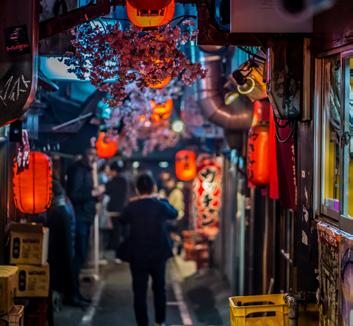
Many decide to stay in Shinjuku or Shibuya, which are considered the very epicentre of nightlife. Don’t bother – these only work if you’re determined to drink your way through all the izakaya (bars) on Golden Gai or Nonbei Yokocho.
My advice is to find a hotel on the Oedo Line that’s a maximum of two direct stops away from Shinjuku. This places you five minutes away from the main transfer hub without having to navigate the nightmare that is Shinjuku Station every single day when you don’t need to.
I picked the Mitsui Garden Hotel Jingu-Gaien because Station 25, which is two stops away from Shinjuku on the Oedo Line, is literally next door. The hotel itself offers larger rooms than usual, has a solid breakfast with both Asian and Western options, and – crucially – two twin beds. A regular double at a Japanese hotel won’t be large enough to fit two average-sized European adults, so factor this in when making your reservation. suggests
Flamingo and Kinji. Take in all the curated looks and try not to max out your credit card.
However, I found even better treasures at Koenji and Shimokitazawa. Plan a half day for each location; they’re both very easy to get to, and besides Tokyo street style, you will also find a lot of second-hand designer shops. We’re not talking cheap bargains here, but a Comme des Garçons black mesh top in flawless condition for €200 remains a steal.
If it’s high-street malls you’re after, head straight to Tokyo Midtown (high-end and designer brands), Diver City (regular high street with a Japanese flair, and the added bonus of the life-size Gundam Statue) or Roppongi Hills (ultra high-end and artsy).
Azabudai Hills is your go-to, starting with teamLab Borderless inside the Mori Building Digital Art Museum. This is a digital art experience like no other, with several spaces interweaving into each other. The walls breathe, floors move and reality shifts around you, so be ready to have your mind blown. Tickets are available online two months ahead, and tend to be snapped up fast.
Don’t rush off afterwards. The Mori Building houses some wonderful rotating exhibitions. During my time there, I caught the gorgeous First Last collection by Tomokazu Matsuyama in collaboration with Issey Miyake, and another exhibition detailing the evolution of Mazinger Z illustrations.
Ghibli film buff? Book your Studio Ghibli Museum tickets through a third-party app like Klook/Viator, otherwise there’s no way you’re getting in. It’s worth paying the inflated prices, as the museum experience is literally like stepping inside a Ghibli movie. You also get to enjoy an exclusive short that isn’t released for public viewing; this changes every day and features some of the most popular characters from the movies.
Make a day of it and stop at Kichijoji Station – meander around the tiny alleys filled with street food and souvenirs, then walk towards the gorgeous Inokashira Park to take a few snaps of the pond and the lush trees. It’s a gorgeous 20-minute walk to the museum, but make sure you don’t miss the time slot on your ticket or you won’t be allowed in.
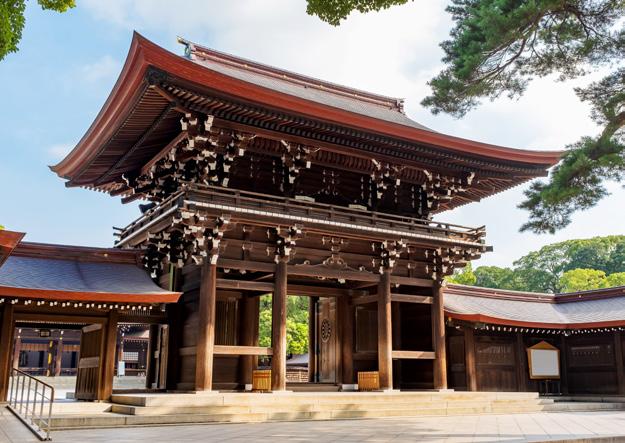

You can reach Tokyo with KM Malta Airlines via Brussels, Istanbul, London Heathrow, Munich, Paris Charles de Gaulle, and Vienna with All Nippon Airways (ANA), via Istanbul with Turkish Airlines, via Paris Charles de Gaulle with Air France, via Rome Fiumicino with ITA Airways, via London Heathrow with British Airways, via Amsterdam with KLM, via Munich with Lufthansa, via Zurich with SWISS and via Vienna with Austrian Airlines.
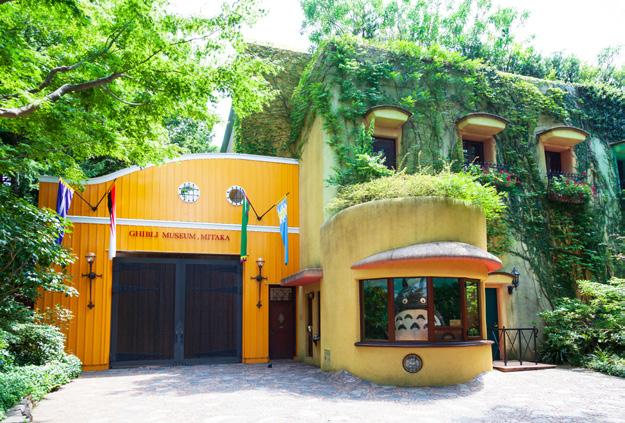

Those of you who have specific nutrition requirements will need to plan ahead and make reservations. Otherwise, just wander around and hit the first place that looks interesting. Food standards are very high, so you’re unlikely to hit a dud.
If you love western sushi, carry out some research before dropping thousands of Yen at an omakase sushi place as they’re not for everyone. Conveyor belt franchises like Genki and Sushiro offer more familiar sushi rolls; they serve extremely good-quality fish at a fraction of the price in Malta.
Ramen is excellent everywhere and is cheap and nutritious. Many places will ask you to order on an ATM-like machine before taking a seat; the system is convenient and easy to use.
If your hotel doesn’t do breakfast, just drop in to one of the Seven-Elevens or Lawsons dotted around the city for a konbinistyle breakfast. Convenience store food in Japan is amazing, and very cheap, so if you’re low on budget, you can also cover lunch or dinner. Just don’t walk and eat outside – it’s a massive faux pas and you’ll receive plenty of stares that let you know it.
READY FOR SOME TOKYO
This is one of those holidays that should be planned well in advance, unless you really don’t mind missing out on specific attractions. Although it’s the busiest time of the year, I advise going during sakura season (end of March till third week of April), when Tokyo is a whole vibe. Just make sure you avoid Golden Week, which is when the Japanese are also holidaying and the crowds get ridiculous.
It does mean you’ll need to book your hotel a good three months ahead, if you’re fussy like me. And you’ll be paying a bit more. But picnicking in Ueno Park under the cherry blossoms will make you forget that pretty fast. Just don’t forget to kanpai (cheers) when you’re raising your can of Asahi to the sunset.
Many will tell you that it’s too complicated. Rubbish. Subway lines are coloured, all stations are numbered, and there are monitors indicating the upcoming stations inside the trains themselves. All platforms are likewise well-equipped with English-language monitors.
The station numbers move progressively, so as long as you’re aware of the colour and number of your departure and arrival stations, you’ll be fine. As an example, to get to Shinjuku (E27) from my hotel (E25), I simply needed to ensure that the platform monitor identified the next station as E26, rather than E24.
Keep your Google Maps open and you’ll find full instructions, down to the colour, platform number, station number and real-time updates. You will even be shown the way to the right platform of your connecting train. During my 10-day stay, I never once took the wrong train – and this is someone with zero sense of direction.
What is complicated, on the other hand, is finding the right station exit out of the 200+ at Shinjuku. Make peace with the fact that you will get it wrong and factor in an extra 30 minutes to your journey. I found it a lot easier to walk straight overground and navigate from there, despite the longer distance.
For taxis, download the GO taxi app. However, be aware that taxis are in short supply – and if you use Uber, you’ll need to wait longer and pay more. However, hailing a taxi the old-fashioned way is also a thing if you’re in a busy area.









Gozo
Gozo
Gran


Words by David Carabott
David is a teacher, specialised in mentoring students of different abilities. As a traveller, his target is to visit all the countries in the world. When he is not in Malta or travelling elsewhere, you can find him somewhere in Rome.
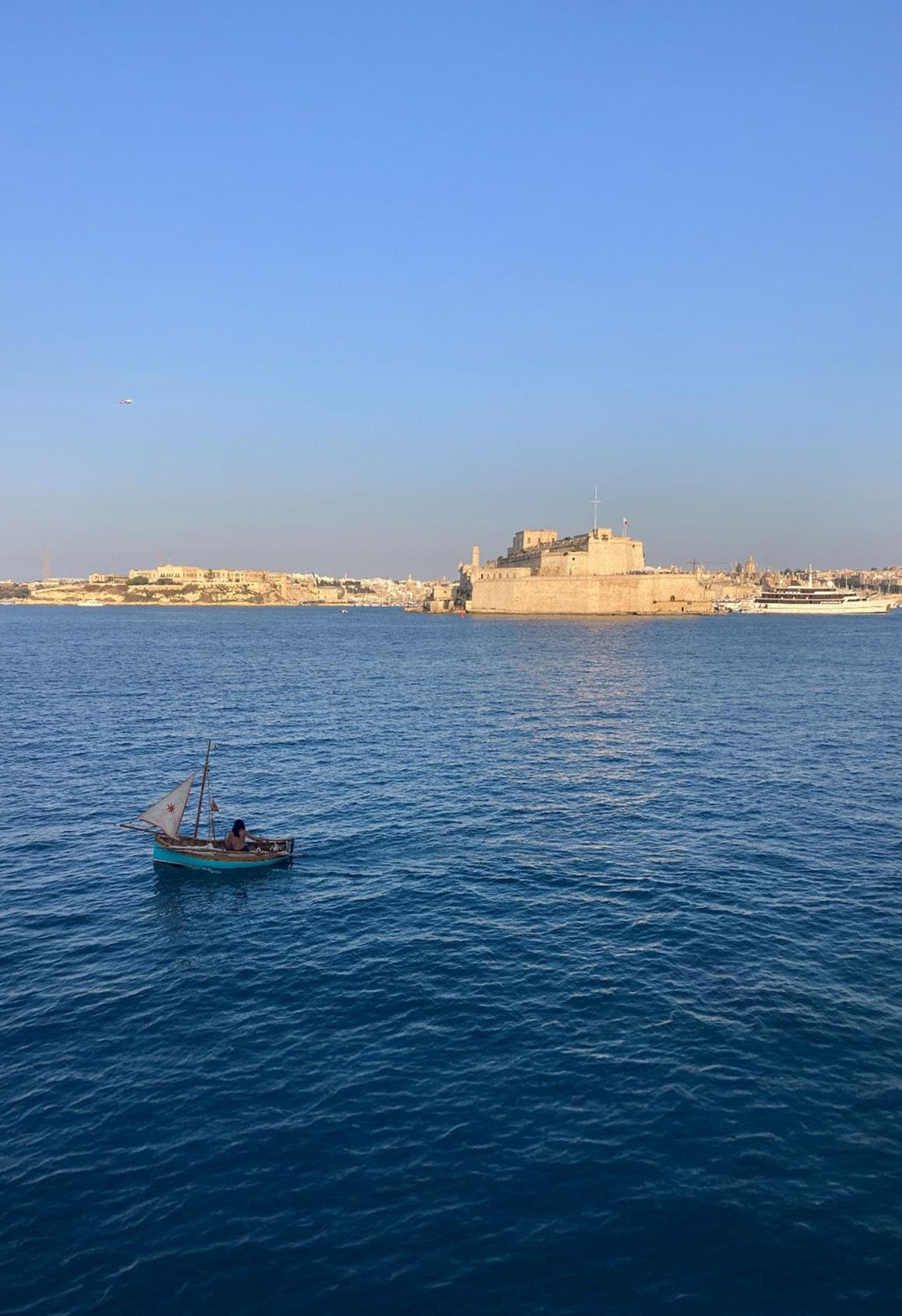
The Feast of the Assumption on 15th August also marks the day the battered SS Ohio, more wreck than ship, limped into Grand Harbour, carrying over 9,000 tonnes of desperately needed fuel. The survival of Malta depended on it. This year marks the 83rd anniversary of the extraordinary Santa Marija Convoy. Read on about this story of faith, courage and sacrifice.
I live in a street called Triq il-Konvoj ta’ Santa Marija, and I had always wondered, what’s in the name? Finally, I decided to take a closer look at the history behind it.
The word convoy, as defined by the Cambridge Dictionary, refers to “a group of vehicles or ships that travel together, especially for protection”. And the arrival of the Santa Marija Convoy was one of the most dramatic and significant episodes of World War II.
At its outbreak, the island fortress of Malta was the most important base in the Mediterranean for the British forces. The Malta convoys were vital Allied supply missions carried out to sustain the besieged archipelago. These vessels delivered food, fuel, medicines, military equipment and reinforcements.
Given Malta’s importance, the British repeatedly risked numerous merchant ships and warships to keep it supplied, while the Axis powers made relentless attempts to neutralise this key Allied stronghold in the Mediterranean.
Malta was a strategic linchpin and, therefore, a prime target for the enemy. Between 1940 and 1942, the island was relentlessly pounded in a vain attempt to force its surrender. However, the defenders, British troops and the resolute Maltese islanders, fought one of the longest and most heroic defensive actions of the war.


Serving as a crucial base for British naval and air forces, Malta also played a key role in disrupting Axis supply routes to North Africa. Maintaining control of the island was essential for Britain’s efforts to protect the Suez Canal and secure access to Middle Eastern oil.
From the moment Benito Mussolini’s Italy declared war on Britain in June 1940, Malta, then a British Crown colony, found itself under siege. Its geographic position in the centre of the Mediterranean made it a critical asset, as whoever controlled Malta could dominate the supply routes between Europe and North Africa. For the Axis powers, the island had to be bombed into submission; for the British, it had to be defended at all costs.
By 1942, Malta was experiencing the peak of the siege, enduring one of the most intense periods of sustained bombardment in world history. The island was on the brink of collapse, crippled by devastating shortages of food, ammunition and fuel. It kept going only thanks to the bravery of its defenders and the resilience of its people.
For months, Malta had posed a serious threat to Axis supply lines between Europe and North Africa, disrupting troop movements and logistics. Acknowledging the island's key position, Prime Minister Winston Churchill warned that its loss would be a disaster of the first magnitude to the British Empire and could ultimately be fatal to the defence of the Nile Valley.
To prevent this, the British launched Operation Pedestal, one of the most daring naval missions of the war. Its scale was extraordinary: four aircraft carriers, two battleships, seven light cruisers and 32 destroyers, supported by

corvettes and fuelling ships, all tasked with protecting 14 merchant vessels carrying desperately needed supplies to Malta’s Grand Harbour.
The convoy departed from ports and military bases across Great Britain, assembling off the south coast of England before setting sail on 3rd August 1942. It entered the warm Mediterranean Sea through the Strait of Gibraltar on the night between 9th and 10th August.
Determined to stop the convoy, enemy aircraft and submarines launched ferocious attacks. Hundreds of Axis planes were redeployed to Sicily and Sardinia to intercept the mission. Previous convoys had been decimated; few ships ever reached their destination.
Among the 14 merchant vessels, the SS Ohio, one of the largest and fastest American oil tankers of its time, was leased to Britain and was carrying the most crucial cargo. Despite heavy losses, five merchant vessels reached the Grand Harbour.
Port Chalmers arrived first on 13th August, followed by Rochester Castle and Melbourne Star. Brisbane Star reached beleaguered Malta the following day. Then, on 15th August, the Feast of the Assumption, the battered Ohio, more wreck than ship, limped into port, carrying over 9,000 tonnes of desperately needed fuel. The survival of Malta, and, indirectly, the fate of millions, depended on that arrival.
Throughout its perilous journey, the Ohio faced an almost unbelievable series of attacks: it was twice abandoned, torpedoed by a submarine and her hull damaged by a devastating blast, hit by a crashing German plane, and left without a functioning
rudder. Remarkably, the ship stayed afloat thanks to the efforts of four Royal Navy escort ships, which kept her upright and moving forward.
Though danger still loomed in the skies, the success of Operation Pedestal marked a decisive victory for the Allies. Less than a year later, the tide began to turn with the invasion of Sicily.
The profound devotion that the Maltese have for the Virgin Mary under the title of the Assumption, known locally as Santa Marija, is unmatched.
On 14th May, 1848, Bishop Monsignor Publius Maria dei Conti Sant, under a direct mandate from Pope Pius IX, declared her the Principal and Special Patroness of the Maltese Islands, a revered title she continues to hold.
Her feast, celebrated on 15th August, or nearby dates in 10 parishes, is one of Malta’s most cherished religious events. This devotion continues to inspire generations with a message of unity, hope and divine protection.
SS Ohio’s captain, Dudley Mason, was awarded the George Cross on 4th September, 1942, and the convoy went down in history as the Santa Marija Convoy.
In 1946, the SS Ohio was taken beyond St Elmo’s Bridge and the breakwater at the entrance of Grand Harbour in Valletta, where it was deliberately sunk.
This year, 2025, marks the 83rd anniversary of that extraordinary convoy – a story of faith, courage, and sacrifice. Triq il-Konvoj ta’ Santa Marija remains a silent witness to the heroism, bravery and determination that shaped history.


Situated in Valletta, Malta’s capital city and a UNESCO World Heritage Site, Teatru Manoel, Malta’s National Theatre, was built in 1731 by the Knights of St. John and is a unique example of early baroque architecture. It hosts the busiest theatrical season on the Island and is open for visits all year round.
Passaggi readers are eligible for a 20% discount on our daily visits. Kindly present this Promo Code at the booking office.
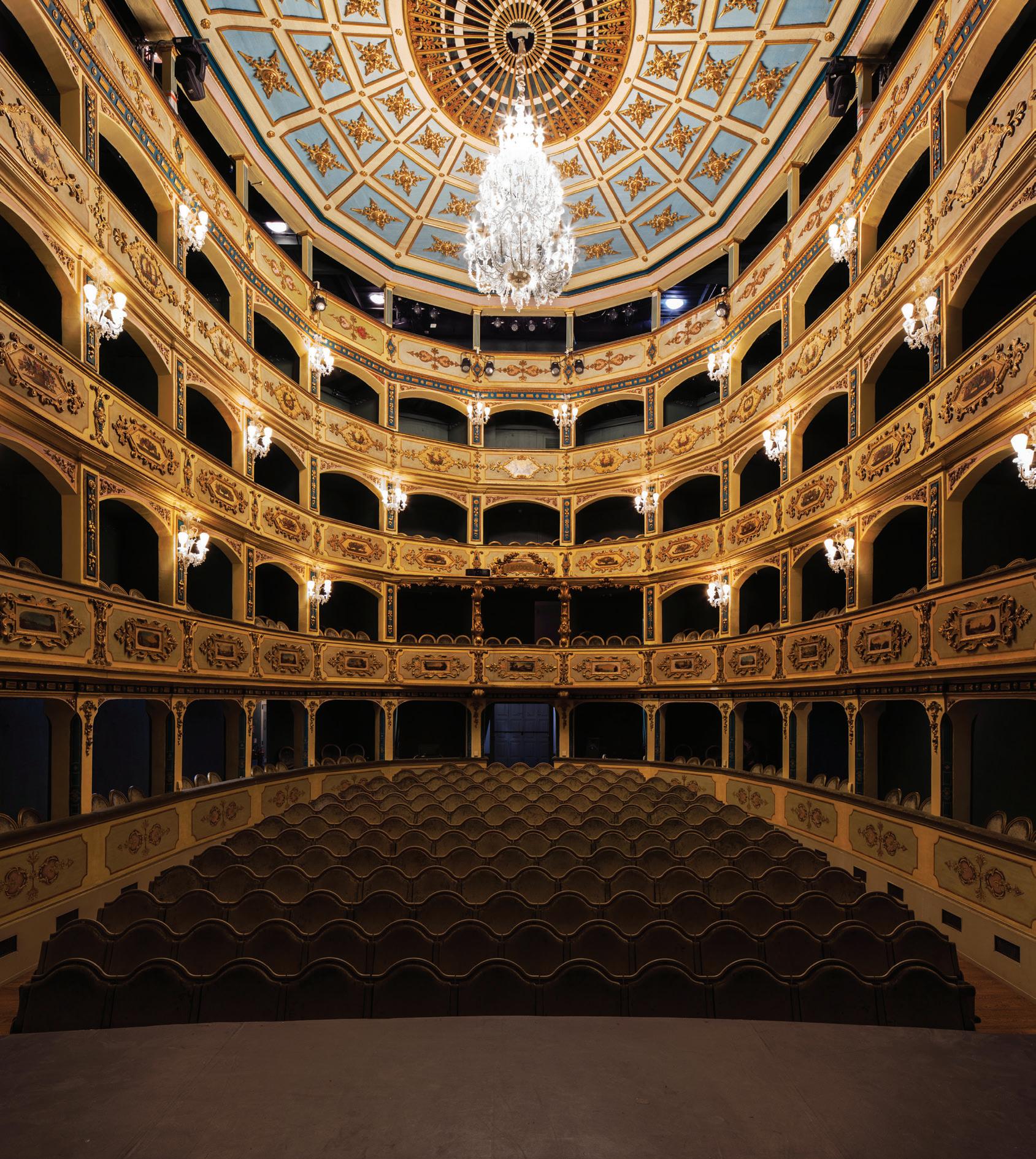
For more information, visit our website teatrumanoel.mt

Words by Leanne Ellul
Leanne is a writer and poet from Malta and is currently the artistic director of Inizjamed and its literary festival.
The idea is for literary events to be accessible and attractive to all… and the Malta Mediterranean Literature Festival 2025 promises to be just that – and more.
It’s late August. The moon is full. The temperature’s high. You’ve been to the beach all day. Listened to music, read a bit, had a drink or two. Watched a film back home, possibly. Perhaps you even slept for a while. Maybe you watched the sun set, too. And yet, there’s room for more. It’s summer. That’s where a literary festival comes in.
Wait! A festival? A lit, what? The Malta Mediterranean Literature Festival 2025 is the only one on the island. Organised by Inizjamed, a voluntary NGO that is committed to the regeneration of culture and artistic expression in the Maltese Islands, it is hosting eight events between 2nd and 30th August.
The literary scene in Malta is ever-changing. Over the years, numerous efforts have been made to promote literature and create a vibrant literary culture. Several NGOs pour their hearts into leading projects and organising events throughout the year. Twenty years ago, the team at Inizjamed
recognised the need to organise a literature festival because Malta had never hosted one before. To date, it remains the only literary festival on the island that gives space to both poetry and prose, while also placing a strong emphasis on translation – both as a means of bringing foreign literature to Malta and of sharing Maltese literature afar.
The formula has proven successful. Over the years, Maltese literature travelled wide. The festival continues to adapt to the times, seeking new collaborations, while always striving to preserve its sense of magic.
With the wand of words in its hands, Inizjamed promises that the festival’s 20th edition will be yet another magical affair. Here’s why:
IT’S ALL ABOUT STORIES
And stories are fun, right? We all love good a narrative. We all react to the rhythms that move us. We are all part of communities that have something to say. Literature is this and much more. While some may look down on reading a book, the Malta Mediterranean Literature Festival offers an experience that starts off from the page but goes beyond. Having a taste of a poem or a story during a late night in August can result in a kind of literary magic (I’m quite sure Freddie Mercury wouldn’t mind) that lingers and makes one yearn for more. Literature is the key… the rest is history.
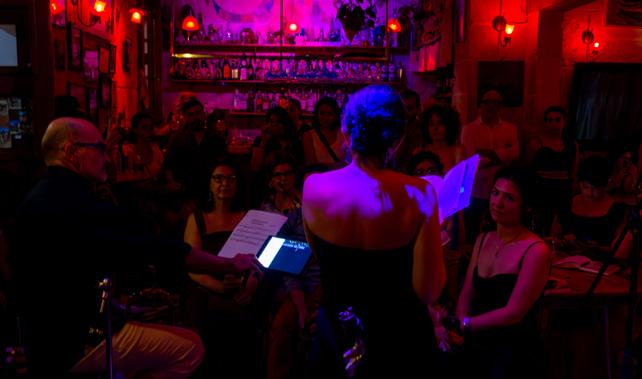
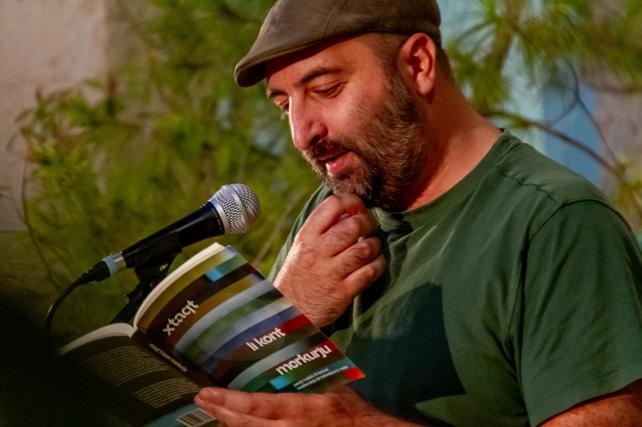
The Malta Mediterranean Literature Festival hosts authors from Malta, the Mediterranean and beyond. Through the years, these have included writers who went on to win the Nobel Prize, like Abdulrazak Gurnah, and others who won the Pulitzer Prize, like Hisham Matar. It has hosted big names in poetry like Joelle Taylor and Inua Ellams.
This year is no different. The festival will bring together Maltese writers – Omar N’Shea, Simone Spiteri and Michael Zammit – alongside international authors Carmen Camacho, Maud Vanhauwaert, Ubah Ali Farah and the colourful (pun intended) Kassia St Clair.
The festival, consisting of no fewer than eight events, will bring together a number of cultural entities, institutes and councils to give it life. This year, it is strengthening its bonds with the European platform Versopolis, besides collaborating more closely than ever with Spazju Kreattiv and the Istituto Italiano di Cultura.
The festival’s events are taking place at a variety of venues, indoors and out, and not just in Valletta. It will be in the capital city quite a bit. But you’ll also stumble upon the action in Gozo, Birgu, Sliema and Floriana.
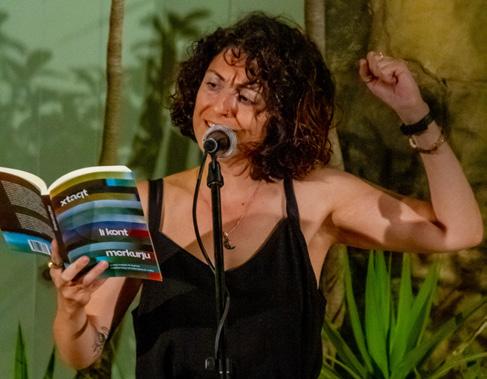
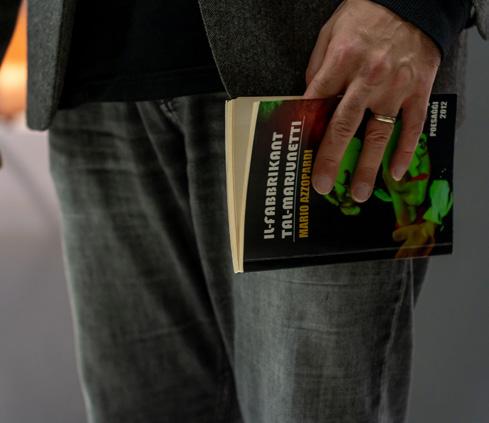
While some events are free, others are ticketed at a very low price. The idea is for literary events to be accessible to all. Indeed, most tickets include a free glass of wine! Being part of the festival means you can read your own work at an open mic, or work your magic at a masterclass. But you can also join the audience and ask questions to the protagonists of the evening. And, by all means, enjoy that glass.
Was wine already mentioned? For the teetotallers, there will be lemonade too! And of course, books and book signings. The festival also hosts film screenings, live music by Kym Pepe and Franco Tartaglia, and poetic performances... Because literature is not a solitary beast. It wants to dance; it wants to discuss; it wants to have all the fun it can. It is alive.
Being a bilingual country, the festival aims to feature both Maltese and English. Mela! But that’s not all. Its writers this year will season the festival with Italian, Dutch and Spanish. So, hasta luego!
For more information, visit www.inizjamed.org and the Inizjamed pages on Facebook and Instagram.






Words by

August in Malta means long days, warm nights and an island buzzing with life. From open-air concerts and food festivals to bold visual art and grassroots gatherings, here's your guide to soaking up every drop of Mediterranean summer.
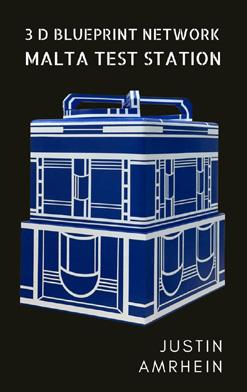
Nostalgia –A Spectacular Musical Concert
When: 7th August
Where: Vittoriosa Main Square, Vittoriosa
Enjoy a blast of musical nostalgia at this concert hosted by the St Lawrence Band conducted by Mro Jonathan Abela and joined by beloved local entertainers Christian Arding and Malta’s 1990s Eurovision star Mike Spiteri, all set against Vittoriosa’s stunning historic backdrop.
3D Blueprint Network
When: 1st - 10th August
Where: MUŻA, Valletta
Artist Justin Amrhein turns everyday objects into blueprints for fictional environmental machines. Set against MUŻA’s historic architecture, this playful exhibition weaves baroque arches, speculative tech and scattered sculptural elements into an imagined green future, which is displayed both inside the museum and spilling into the square outside.
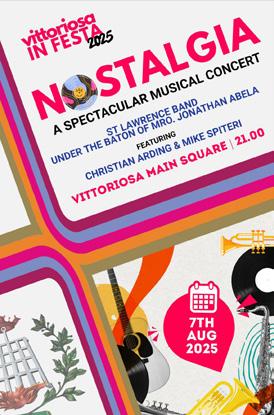

Malta International Food Festival
When: 6th - 10th August
Where: Granaries, Floriana
Malta’s biggest food festival returns with five nights of open-air indulgence. Expect sizzling street food, live cooking shows, cultural experiences, artisan stalls and a world of flavours to explore under the stars in Floriana.
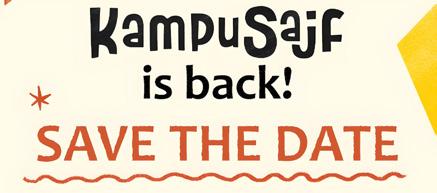
KampuSajf
When: 20th - 22nd August
Where: MCAST Campus, Mosta
With the theme Gathering of Possibilities, this year’s KampuSajf is a three-day celebration of collective imagination and creative exchange. Expect an eclectic mix of grassroots music, theatre and film from local artists and communities.
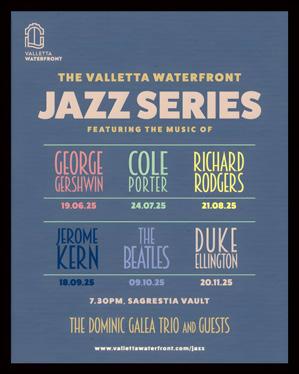
Notte Italiana con Pupo
When: 21st - 23rd August
Where: Pjazza Teatru Rjal, Valletta
Veteran Italian crooner Pupo takes centre stage with a string of sing-along classics, including Gelato al Cioccolato and Su Di Noi. Performing alongside the Malta Concert Orchestra, this three-night run promises a hearty dose of romance and retro charm under the stars.
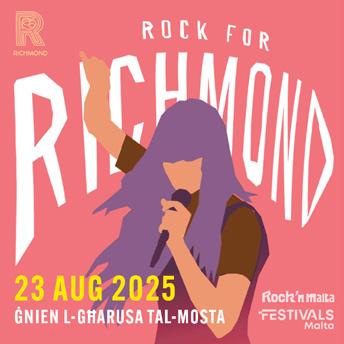
Delicata Wine Festival
When: 22nd - 23rd August
Where: Ġnien Il-Kunsill, Nadur (Gozo)
Raise a glass in Gozo’s hilltop town of Nadur as Delicata’s much-loved wine festival returns. Sample over 20 local wines, graze on delicious food, enjoy live music by top local acts, all with sweeping views and a laid-back summer vibe that’s pure Gozo charm.
Valletta Waterfront Jazz Series: Richard Rogers
When: 21st August
Where: Sagrestia Vault, Valletta Waterfront
A jazz-tinged tribute to one of musical theatre’s greats, this evening sees the Dominic Galea Trio rework the timeless melodies of Richard Rodgers, known for his classic Broadway shows Oklahoma! and The Sound of Music, with support from guest vocalists Nadine Axisa and Mariele Żammit.
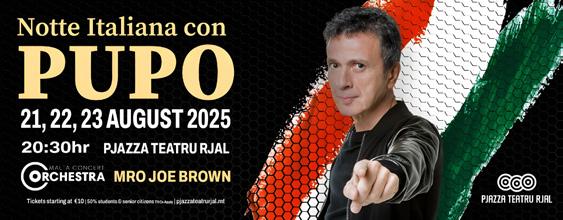
Rock for Richmond
When: 23rd August
Where: Ġnien l-Għarusa, Mosta
A heartfelt night of indie and alt rock in aid of mental health support. With Brikkuni and Beangrowers headlining, and singer-songwriters Claire Tonna and Sean Borg rounding out the bill, proceeds from this open-air festival will go toward Richmond Foundation’s mental health support services.


Typically celebrating its feast on 15th August alongside numerous other parishes around Malta and Gozo, this year the charming town of Dingli has moved its Feast of the Assumption celebrations to Sunday the 17th, giving visitors who may usually be attracted to bigger towns like Mosta an opportunity to join in their celebrations.
Dingli’s village feast centres around its beloved statue of the Assumption, a finely carved wooden figure, created in 1861 by local craftsman Mastru Anton Busuttil. The statue is housed inside the parish

church, a modest but charming building completed in 1973 with strong support from the local community, which today is officially listed on the National Inventory of the Cultural Property of the Maltese Islands.
The main celebrations begin on the evening of Saturday, 16th August, with boisterous band marches winding through the streets, alongside both aerial and ground fireworks lighting up the sky. On Sunday, the feast day itself, a solemn morning Mass is followed by a traditional band march through the village.
Families then gather for lunch, with many enjoying fenek moqli (Maltese-style fried rabbit).
In the evening, the highlight of the feast takes place with a grand procession, where eight bearers carry the statue through Dingli’s streets, accompanied by hymns, music and a final show of fireworks, delivering a moving celebration of faith, tradition and village spirit.
For a guide to upcoming religious celebrations and traditional feasts across the Maltese islands, be sure to visit Inkontru.app
If you’re visiting Dingli for the feast or enjoying a scenic stop at the cliffs, don’t miss a reservation at Diar il-Bniet. This family-run gem offers a true farm-to-table experience, serving traditional Maltese dishes made from ingredients grown on their own estate. From nanna’s traditional timpana to hearty pan-fried rabbit, every bite tells a story of heritage and passion. Diar il-Bniet is a must-visit for those seeking authentic cuisine in a beautifully rustic restaurant setting.
Step into Malta’s scene with Inkontru.app, your personal guide to all the latest art, culture and heritage events in Malta and Gozo. More than just a calendar, this app connects you with exciting events and artists through exclusive interviews and video features. Easily find event details, get directions and purchase tickets – all in one place. Need a ride? Book a cab effortlessly through the app and share your plans with friends and family with ease.



Ahead of the Delicata Wine Festival in Nadur, winemaker Matthew Delicata shares his passion for Maltese wines and the joy of bringing people together to celebrate great viticulture, local music and good company.
What’s it like growing up in a wine-making family?
Our story goes back to 1907, over 115 years ago. I’ve been making wine with my father George and my brothers Mario and Michael since I was a boy. It’s a true family labour of love. Wine making takes passion, perseverance and a lot of handson craftsmanship, but I wouldn’t have it any other way.
What excites you most about Delicata’s Maltese wine?
I have a soft spot for our indigenous grapes, Girgentina and Ġellewża. We’ve always championed their preservation as they’re unique to Malta. I’m particularly proud of our frizzantes and our 100 per cent Girgentina wine in the Medina range. They really express Malta’s character.
What makes the Delicata Wine Festival such a special annual event?
It’s our way of sharing our love for wine with the public. We believe it’s about more than tasting; it’s about bringing people together to celebrate amazing varieties with great music and food. Launching our Gozo edition in Nadur was especially meaningful to us as we work with numerous vineyards on our sister island.
Keep the kids learning and engaged this summer with these family-friendly events that mix discovery, play and a chance to make new friends.
ŻiguŻajg – Summer Bootcamp
When: 2nd & 9th August
Where: Spazju Kreattiv, Valletta
This hands-on contemporary art programme invites young artists to experiment with different artistic techniques, draw inspiration from historical and contemporary artists and curate their own final exhibition.
Eco Festival
When: 29th - 31st August
Where: Upper Barrakka Gardens, Valletta
Explore all things eco at this festival of activities, including a plant-potting station, children’s games such as Jenga and word searches, sensory boxes, and VR experiences. Activities will be available free of charge.

Discover and experience more with inkontru.app, your web-based application that prioritises functionality and performance, meaning no need to download, seamless updates, no storage space taken and easy sharing. Enjoy!
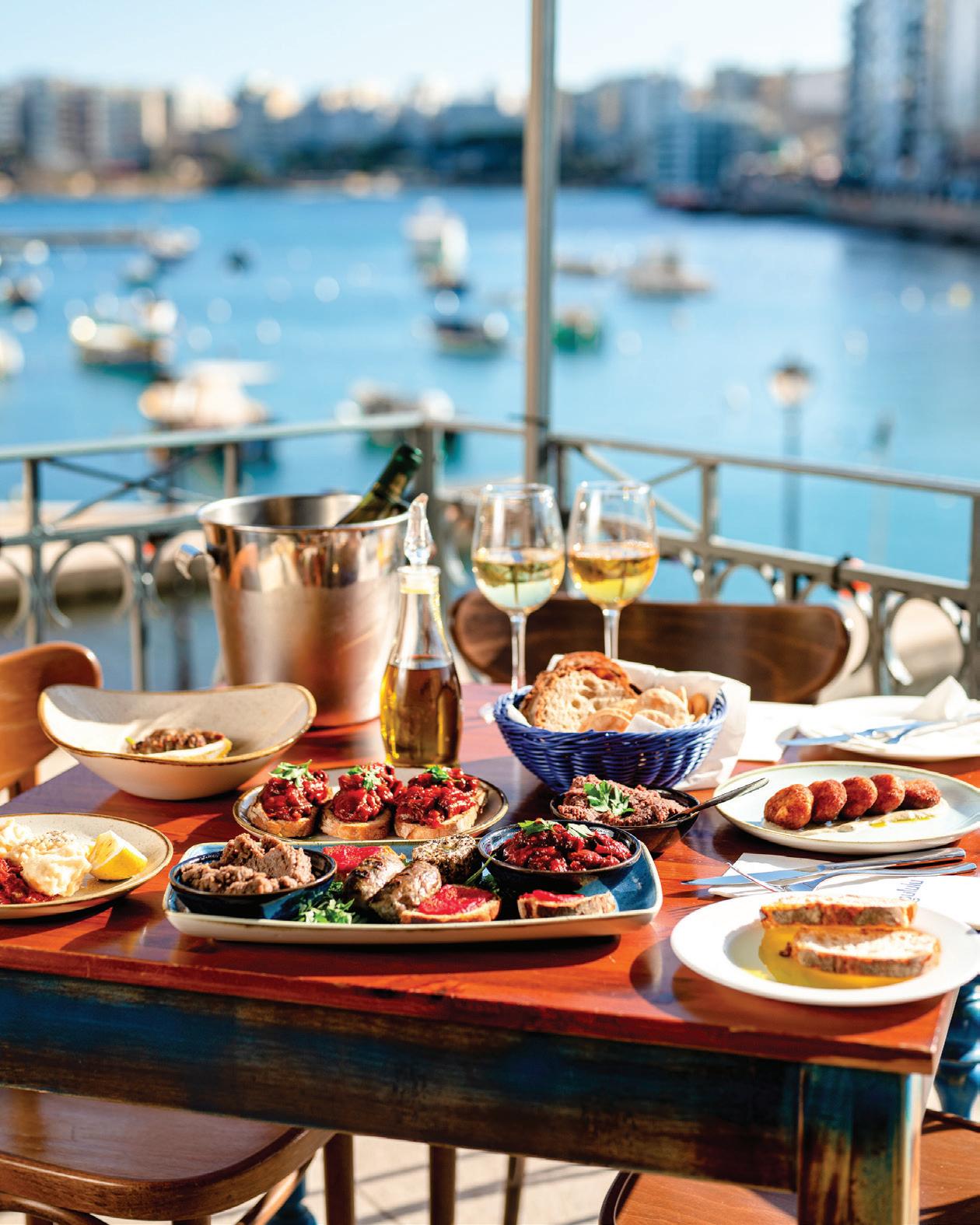

Words by Coryse Borg
Coryse is a broadcaster, actress and voiceover artiste. She is passionate about writing, travelling and spending time with her loved ones; discovering new places and sampling new food in as many countries as possible.
Heading
to Malta? Here’s your essential Maltese language cheat sheet, plus everything you never knew you needed to know about the only Semitic language written in the Latin alphabet.
It’s your first morning in Malta, and the shop owner at the corner kiosk greets you with a warm “bonġu!” You smile, say it back (a little awkwardly), and suddenly – you’re not just a tourist.
In Malta, a few well-chosen words in Maltese (or Malti) can go a long way.
Even though English is widely spoken across the islands, learning a few Maltese phrases can enrich your trip. Whether you’re ordering local delicacies, exploring quaint villages, or simply striking up a conversation with a friendly local, using the native language – however imperfectly – is always appreciated.
The Maltese language is unlike anything else you’ll hear in Europe. It’s a Semitic language, meaning it shares roots with Arabic, but it’s the only Semitic language in the world written in the Latin alphabet.
Maltese developed from Siculo-Arabic, the variety of Arabic introduced to Malta in the 9th century. Over time, it absorbed layer upon layer of vocabulary from Italian, Sicilian, English and even French, thanks to Malta’s rich history of occupation and cultural exchange.
Today, the language is a living blend of these influences. You might hear “jekk jogħġbok” (Semitic for please) followed by “grazzi” (which comes from the Italian for thank you – grazie), all in the same sentence. And it works. Maltese manages to be complex, colourful and wonderfully expressive all at once.
Maltese uses a 30-letter Latin-based alphabet, which includes some unique letters to represent sounds not typically found in other languages.
– pronounced like 'ch' in chess
– like 'j' in jam
like 'z' in zoo WHAT TO LOOK OUT FOR
a strong 'h' sound
silent
– silent

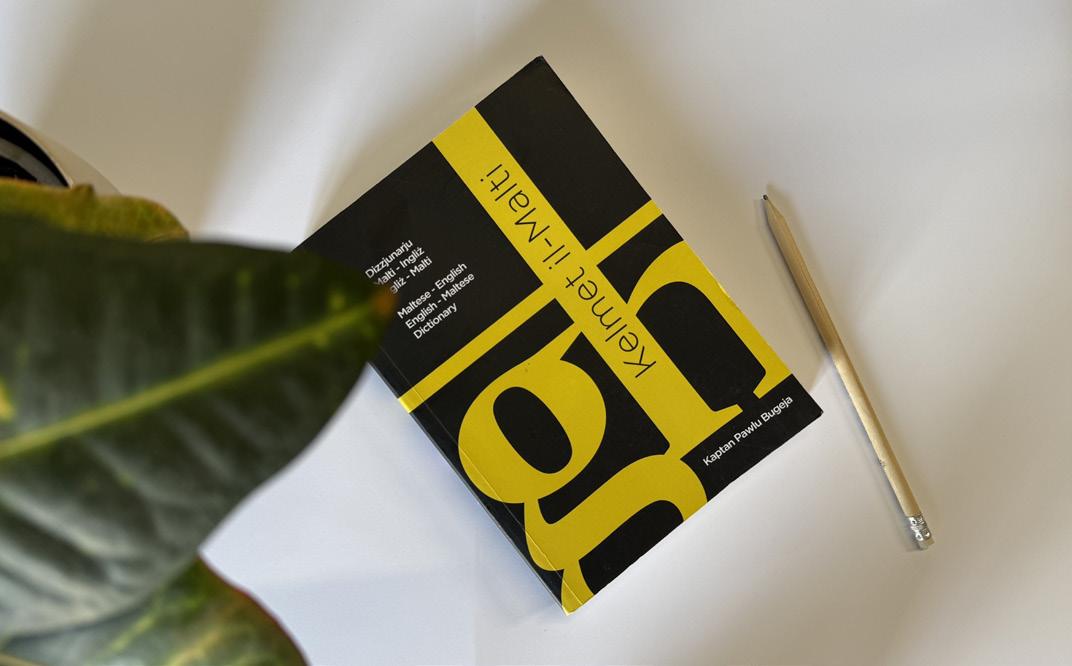

It might look daunting at first, but hearing the language spoken makes everything click. And even if your pronunciation isn’t perfect, Maltese people are usually pleased – and often charmed – that you’re giving it a go.
Here’s a handy list of everyday expressions that you can use during your stay in Malta. Whatever the situation, these phrases will help you connect with the locals and enhance your travel experience.
Bonġu Good morning
Il-lejl it-tajjeb Good night
Merħba Welcome
Grazzi Thank you
Ta’ xejn You’re welcome / No problem
Skużani Excuse me / Sorry
Jekk jogħġbok Please
Kemm jiswa? How much does it cost?
Fejn hu...? Where is...?
Iva Yes
Le No
Tista’ tgħini? Can you help me?
Sabiħ/a ħafna! Very beautiful!
Saħħa! Goodbye
Inħobbok I love you
Greeting someone in the morning
Saying goodbye in the evening
When arriving somewhere or being greeted
After receiving something or a kind gesture
Replying to “Grazzi”
When interrupting or apologising
Asking for something
While shopping
Asking for directions
Responding affirmatively
Declining or disagreeing
Asking for help
Complimenting something
When parting ways
Use this one with caution!
Most Maltese people are bilingual – or even trilingual – and will happily switch to English without hesitation. But peppering your interactions with a bit of Maltese often opens the door to warmer conversations and friendlier interactions.
So don’t be shy. Try a “merħba” when you walk into a shop. Ask “tista’ tgħini?” if you need help. And when you’re sitting at a seaside bar sipping on a cocktail, say “kemm hi sabiħa l-ħajja!” – life is beautiful!
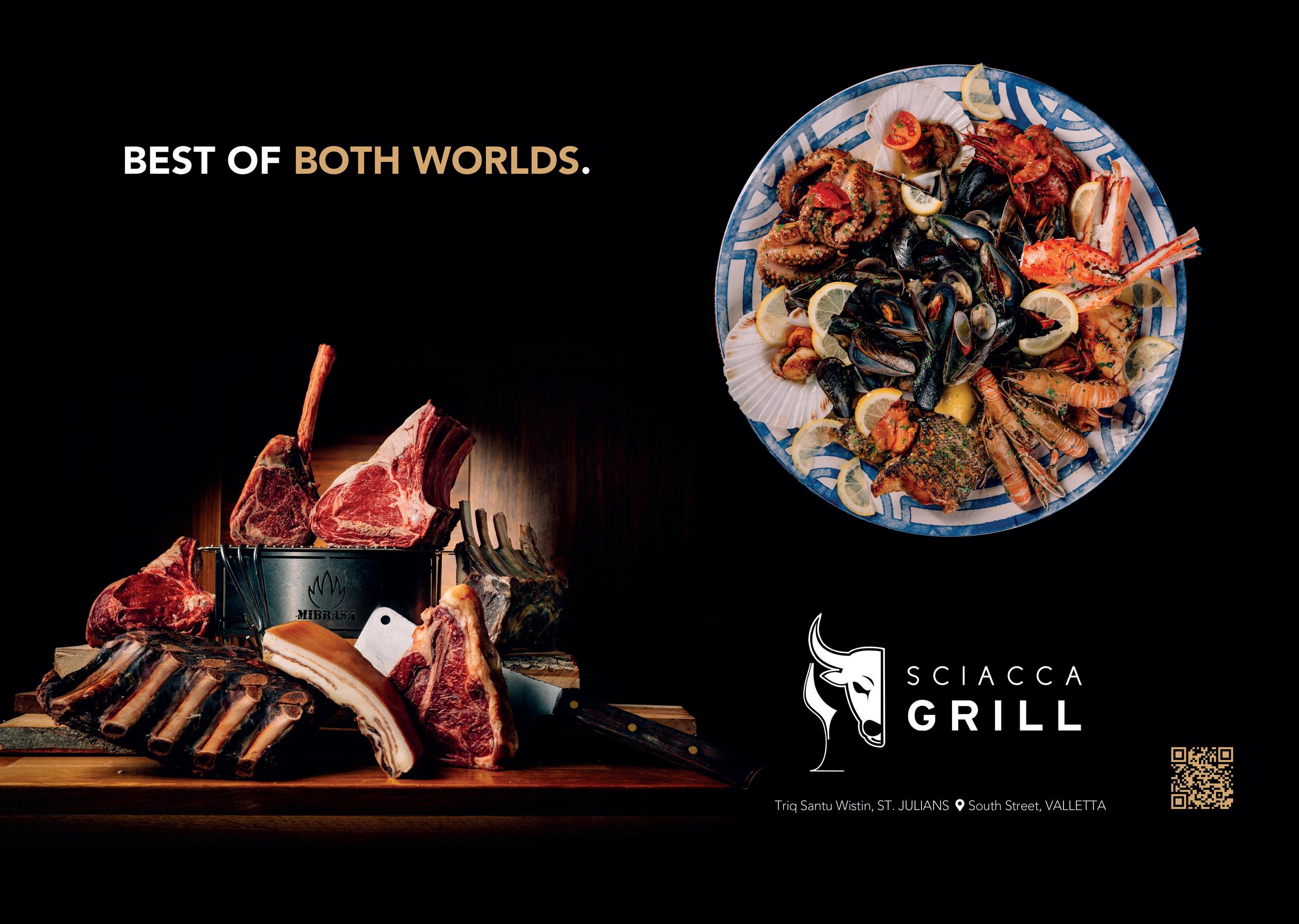

Words by Ramona Depares

Elegant escapes and understated luxury, far from the madding crowd… Experience the relaxed spirit of a truly Mediterranean night.
I’m enjoying a refreshing limoncello cocktail as the sun sets over the infinity pool, casting a golden hue all the way across Sliema. The tantalising smell of barbeque wafts on the breeze that’s coming in from the sea. It’s a moment of pure perfection.
The Maltese summer is a wonderful time for social butterflies, but it can also be chaotic and sweaty. Enter the island’s green oases, peaceful spots where the season can be enjoyed as it’s truly meant to be – in the cool shade of a tree, a cocktail or glass of champagne in hand, with the most delicious dishes the Mediterranean has to offer.
With this in mind, I’m sharing my four favourite spots for the season; the ones that made me forget the hustle and bustle and gave me the opportunity to focus on flavours served with serenity and good views.
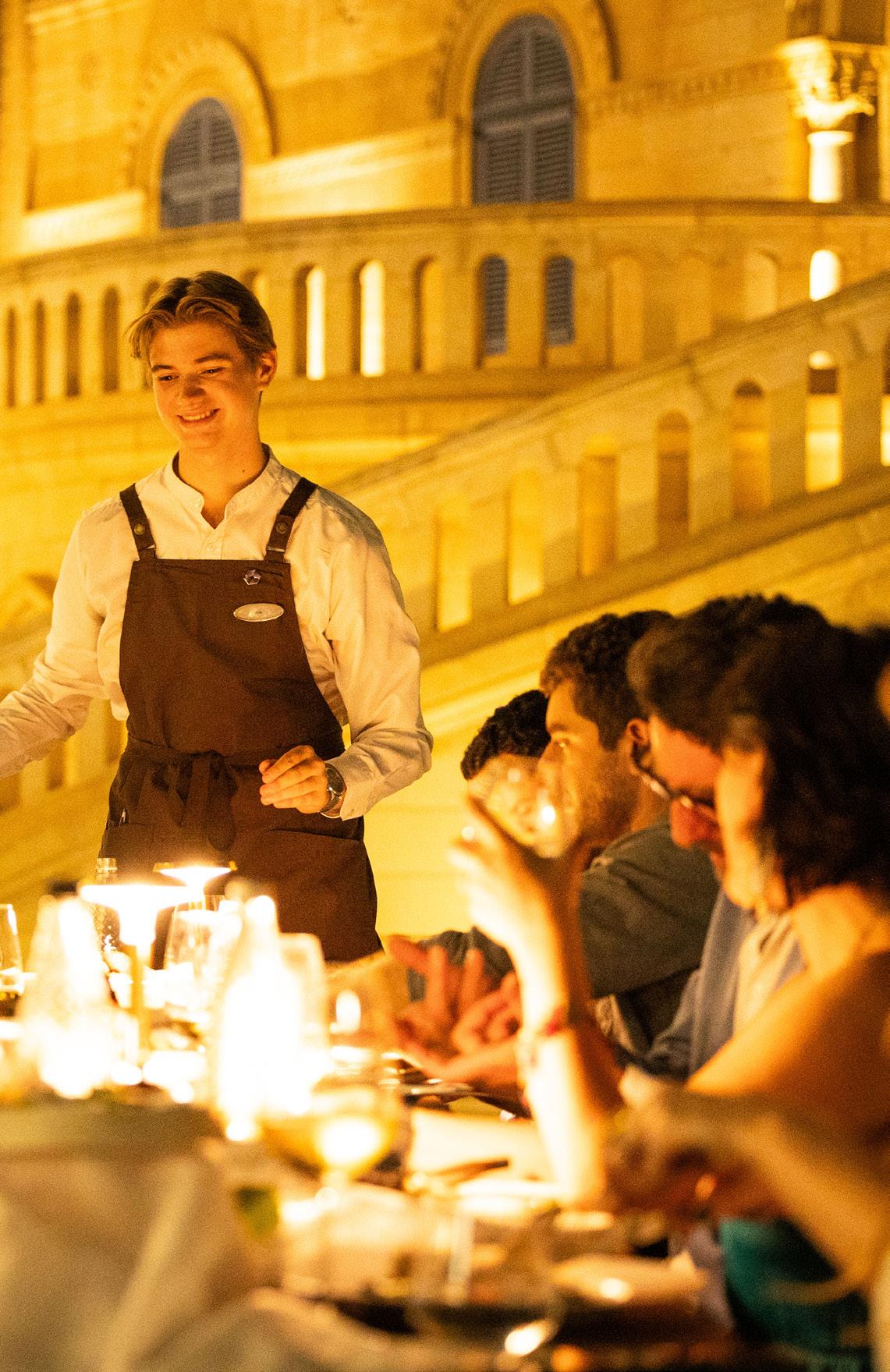
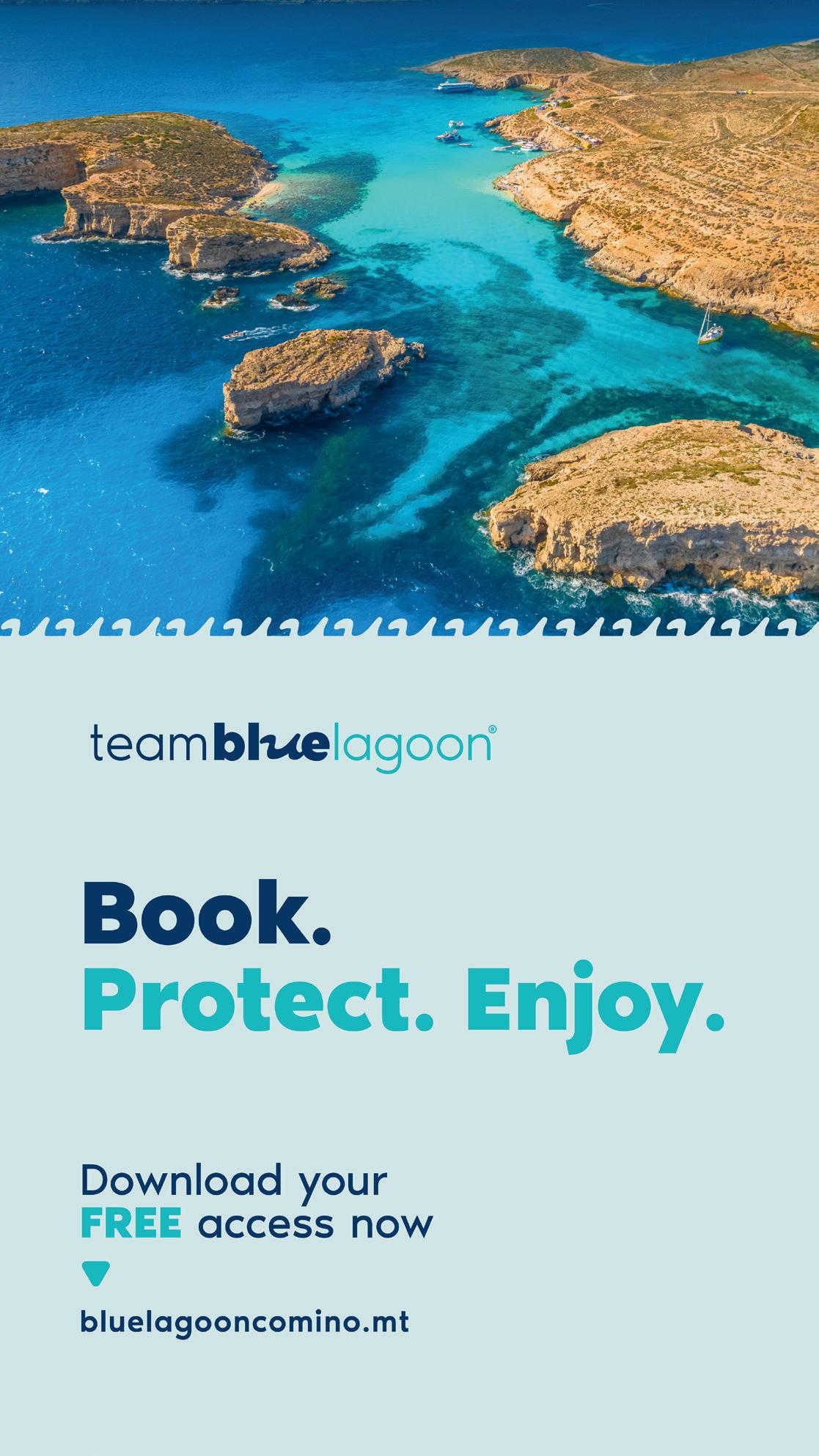
To reach the Phoenicia Malta’s Bastion Pool, Bar and Restaurant, you need to take a short walk through the luscious gardens. In two minutes, you’ll forget that you’re right on the doorstep of a busy capital city – the chirping of birds, the rich perfume of the flowers and the infinity pool nestled in the heart of Valletta’s fortifications tend to make you forget there’s another world outside.
Get here for golden hour, because, trust me, you’ll definitely want a selfie for this one, with Marsamxett Harbour behind you. The restaurant serves a Mediterranean menu every day, using produce that’s fresh from the hotel gardens. On Tuesdays and Thursdays, things take an even more delicious turn with the BBQ buffet’s excellent cuts, to the tunes of live music, while the Wednesday jazz nights are superb. The popular Nights Under the Stars promise an evening as lush as they come.
My pro tip? Before moving on to your table, order the Limoncello Spritz and enjoy a quiet chat – and maybe an impromptu photo sesh – on one of the secluded benches as the sun sets right behind you.
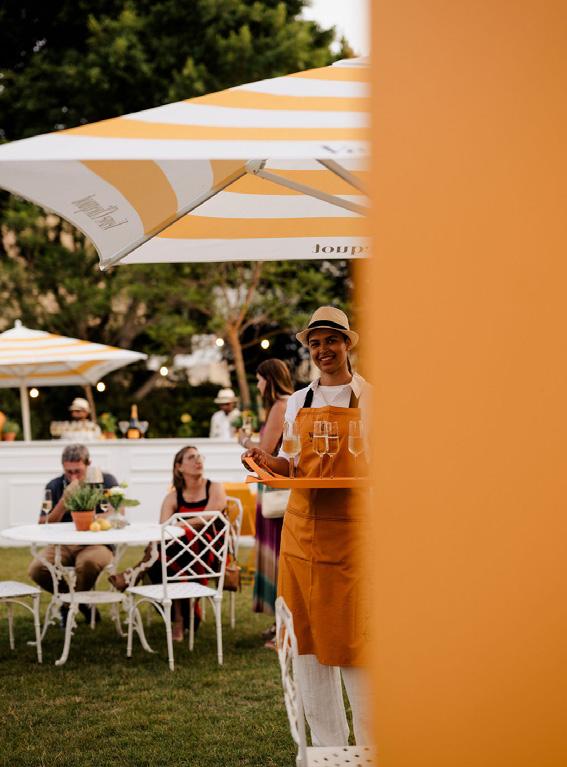
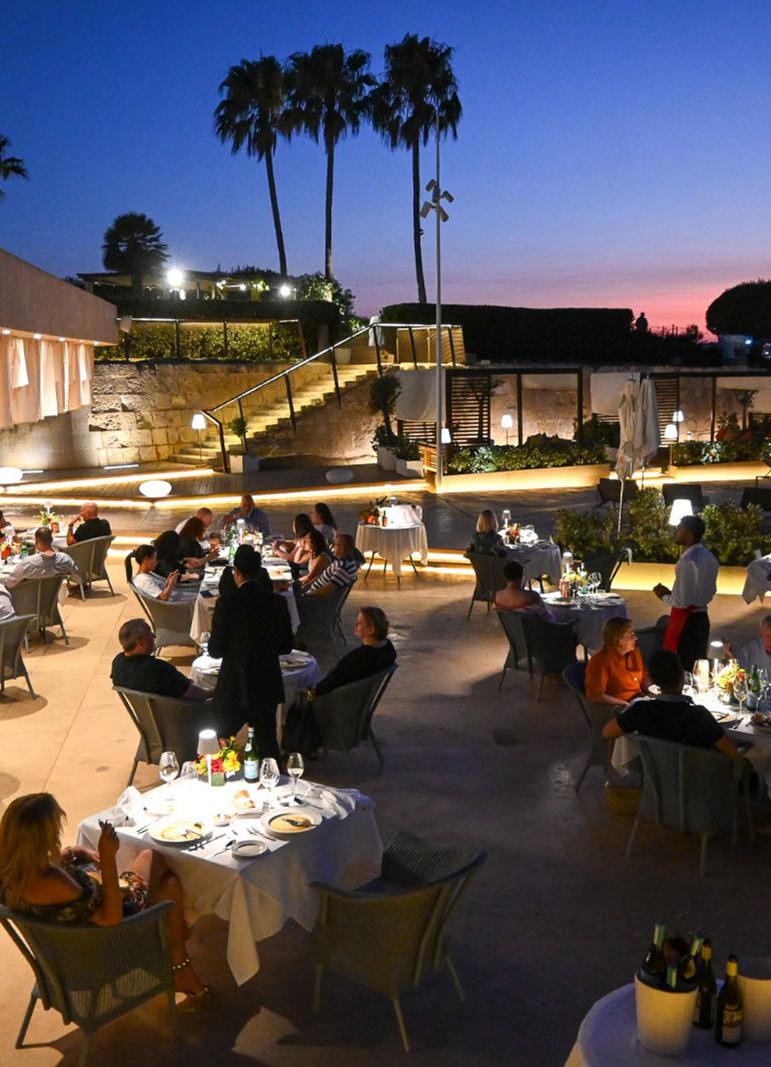
Malta’s sleepy village of Attard is home to the unique brand of quiet luxury that’s synonymous with Corinthia Palace. And, nestled among the olive groves and green grounds of the hotel is the Secret Garden.
More than a restaurant, it’s a concept based around the reimagined poolside, with Chef Franscesco Mazzei holding court over the summer menu. Dishes are as delectable as one would imagine, a bold and beautiful expression of Mediterranean flavours that set the tone for a leisurely evening enjoying the best that island life has to offer.
Every Friday, the Veuve Clicquot Lounge popup adds an extra je ne sais quoi to the night, with curated cocktails, wines and champagne to be sipped to the beats of the Balearic thanks to DJ Rosa and DOM.
Here’s my pro tip for your night of bubbles and tunes. Don’t be shy of leading a shimmy by the Corinthia Palace poolside. It’s encouraged.
While undoubtedly offering thrills aplenty, Paceville is hardly a haven of peace and elegance. Enter Seed, at the Hyatt Regency Malta, which is currently doing an incredible job of challenging my previous sentence. Seed’s outdoor space is located within a piazza, with the stunning Augustinian Priory serving as a backdrop. This season, the restaurant is serving up a delightful escape, with summer cocktails and a curated menu that centres around unique dishes with a Mediterranean twist.
But let’s not forget that music and the Med go hand in hand. And the fun at Seed goes beyond the food thanks to Pjazza Unplugged, a weekly Thursday special that sees the foodie vibe paired with live music by some of Malta’s top musicians and singers. Think classic hits that allow you to focus on flavours and conversations, perhaps with the odd pause to sing along to a favourite tune.
The menu is a celebration of Maltese terroir and – in the words of Hyatt Regency General Manager Adrian Attard – is based on “sustainability, authenticity and excellence”. The flavours certainly reflect the wisdom of this approach.
And here’s my pro tip for those with a discerning sweet tooth: the Maltese trajfil (that’s right, phonetic spelling intentional) is a beautifully decadent take on our beloved, traditional dessert.


Palazzo Parisio’s impeccably manicured gardens are always a treat, and this summer, they’re taking on a shimmer of extra charm, with a full schedule delivering cocktails, live music and starry skies to the old village of Naxxar.
The Summer Sounds schedule eases you gently into the second half of the week, starting on Wednesday with Gin & Jam – a sassy marriage of cocktails, live music and bar bites. Thursday and Friday nights are all about al fresco dining to the mellow sounds of jazz, while Saturdays take on a lounge feel with Bistro & Beats, as DJ Don Peltrinsky spins the tunes in perfect harmony with the Mediterranean summer spirit.
This pro tip will make sure your night progresses in style: when making your reservation, ask for a table at the furthest end of the building. You’ll enjoy the benefit of both worlds, music and garden, for a magical night.
The Mediterranean personality is a deliciously decadent one, and in Malta we really come into our own on these balmy, starry nights. These summer escapes symbolise a way of life that many Maltese still embrace – laid-back, quietly luxurious, full of sensorial delights. But that may not be immediately obvious to visitors, who are distracted by the lights and the busy nights. These summer oases level the playing fields, offering a taste of the authentic Maltese summer even to those who are here for a short while.
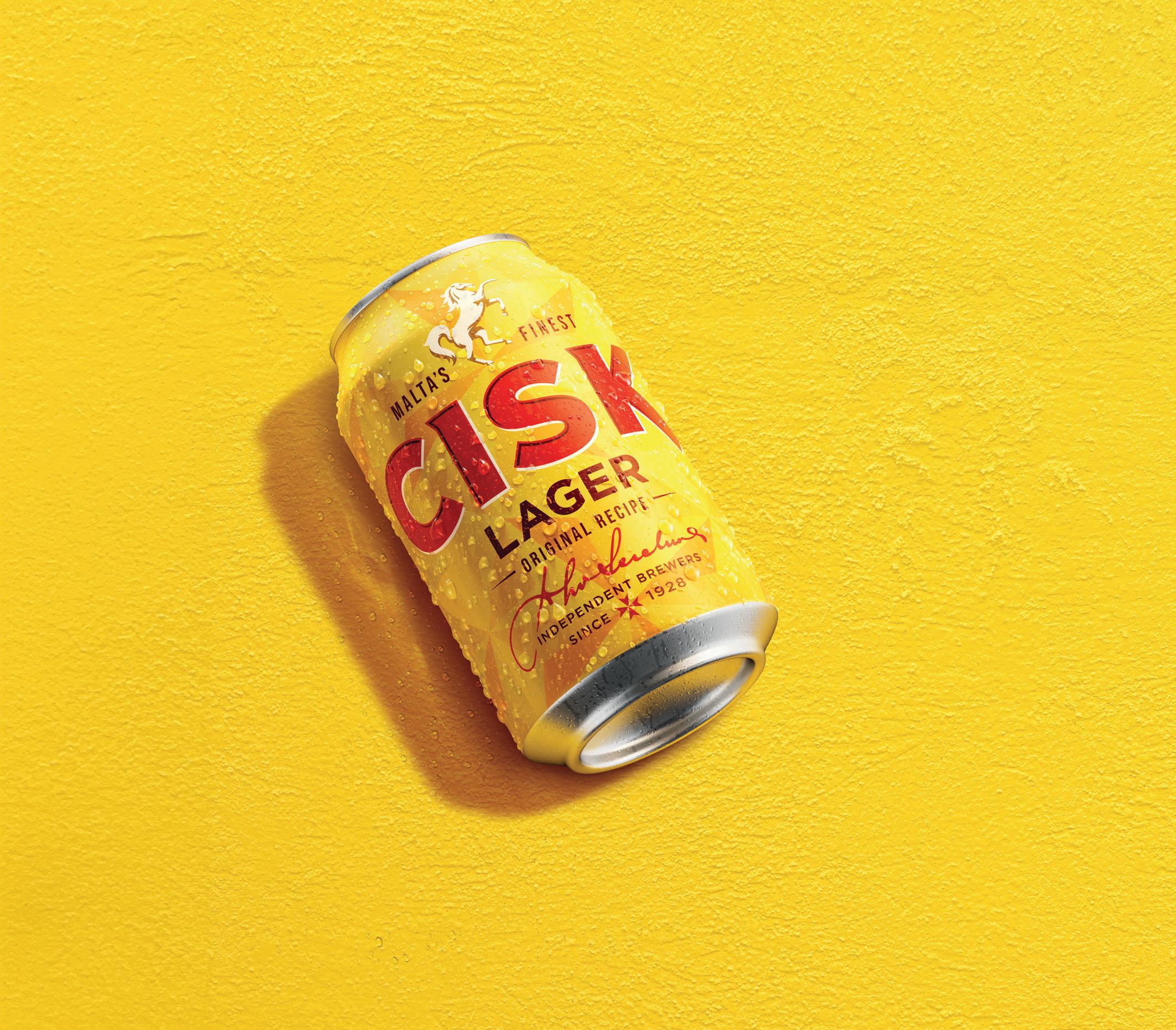
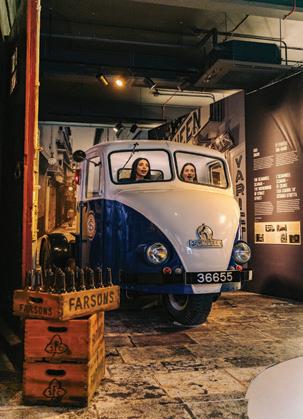

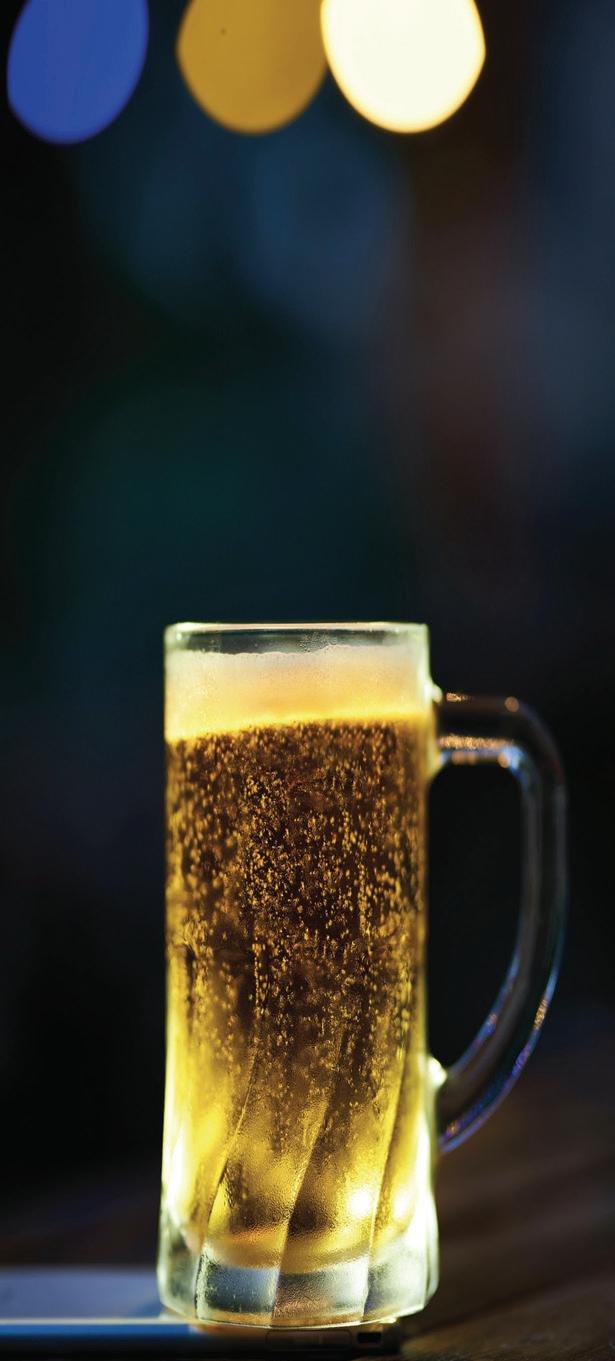
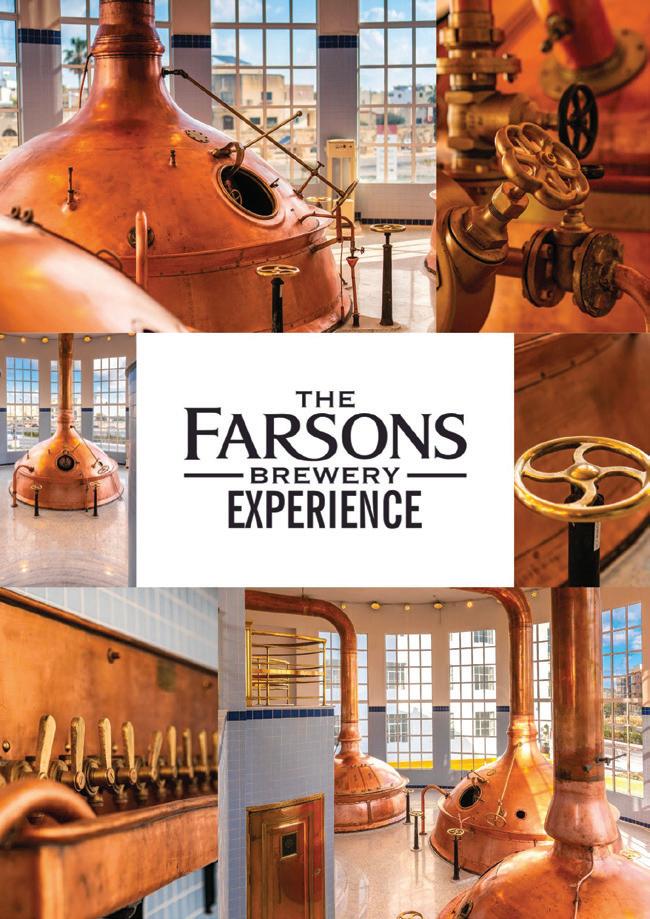
Four days of unified dance-floor energy await. Every August, the sun-drenched island of Malta becomes the stage for one of Europe’s most vibrant and internationally acclaimed electronic music events.

Since its inception in 2016, Glitch has grown from an ambitious local initiative into Malta’s flagship festival — a cultural phenomenon that has firmly placed the island on the international music map while reshaping its electronic scene in the process.
Now heading for its 8th edition, Glitch attracts thousands of visitors from every corner of the globe. Its rise is driven by a commitment to curating diverse, highquality line-ups, meticulously crafted stages, and an atmosphere that blends the energy of underground club culture with the rich heritage of its Mediterranean surroundings.
Taking place between 13th and 16th August across multiple locations, including sunsoaked boat parties, Glitch offers a four-day journey like no other. The festival kicks-off with a spectacular opening party within the Valletta bastions, a dramatic UNESCO World Heritage Site.
The main event unfolds beneath the mediaeval skyline of Mdina, where Gianpula Village transforms into a pulsating dance
haven, accommodating seven distinct stages designed for full sonic immersion.
From roaring rooftop pool parties to cave raves and the legendary Boiler Room stage, each space is attentively designed to provide festival goers the ideal spots to lose themselves in.
This year’s edition boasts one of the strongest line-ups yet, bringing together over 80 artists from different corners of the electronic spectrum, and featuring anticipated debuts, modern-day legends and emerging stars, including: I Hate Models, Sara Landry, Malugi, Kettama, DJ Heartstring, Funk Tribu, VTSS, Anetha, Rødhåd, Dax J, Chlär, Yanamaste, Freddy K and many more.
Whether you're a seasoned raver, or a curious newcomer, Glitch is a gathering of a global family; a community drawn together by a shared desire to celebrate, connect and have fun. It’s this spirit, combined with world-class talent and an unbeatable Mediterranean setting, that continues to make Glitch Festival a cornerstone of the international festival calendar.
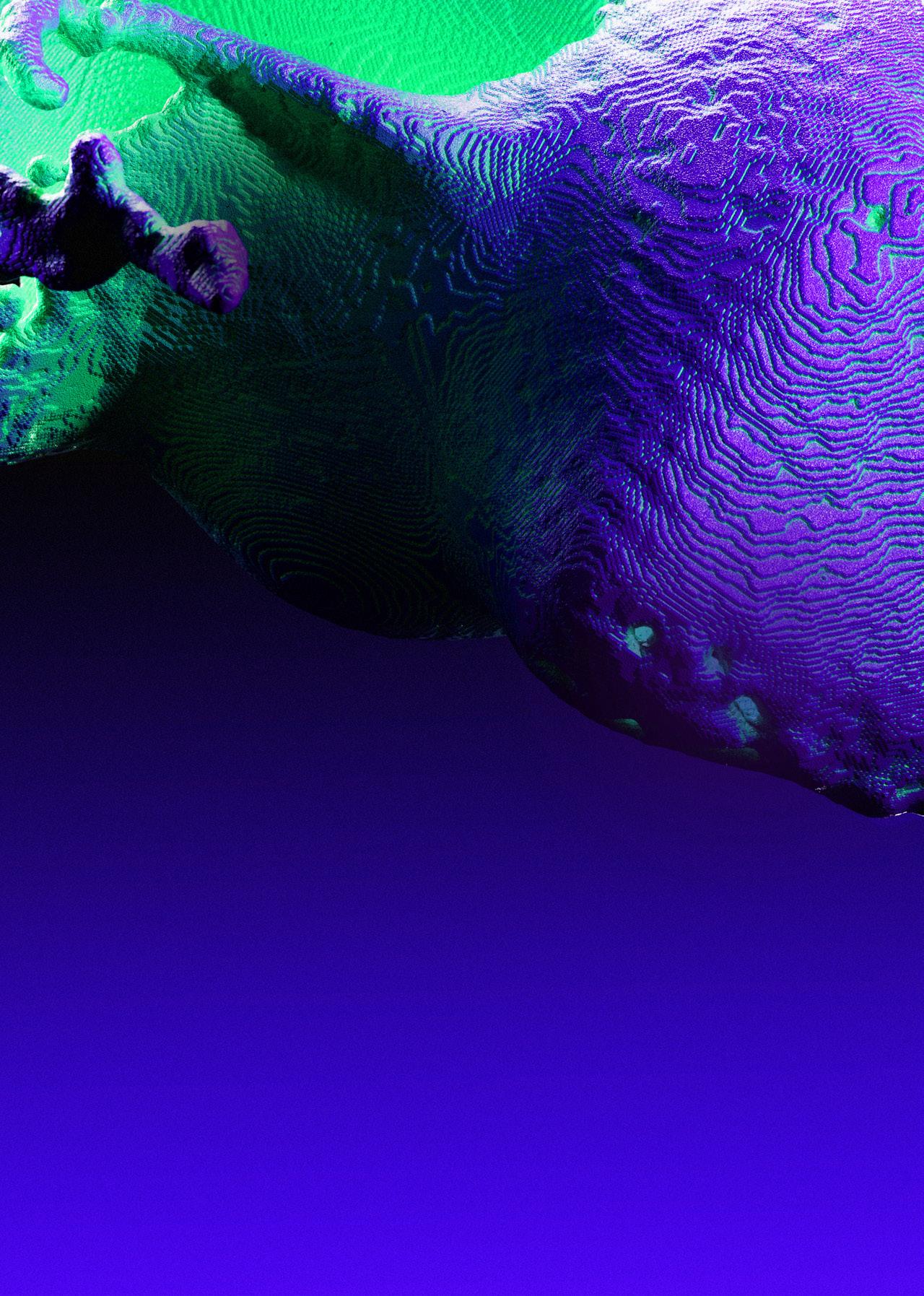

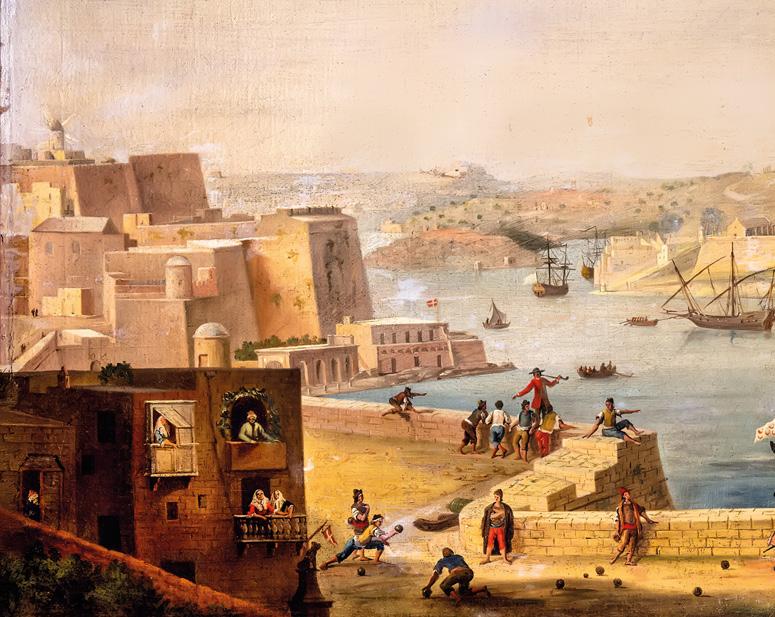
Read one of the hundreds of true stories in the book, Morte o Fortuna, which gives a voice to those who lived on the edge – from corsairs to merchants, renegades and refugees – centuries ago. They navigated a world of fluctuating borders, where cannon fire and commerce were two sides of the same coin.
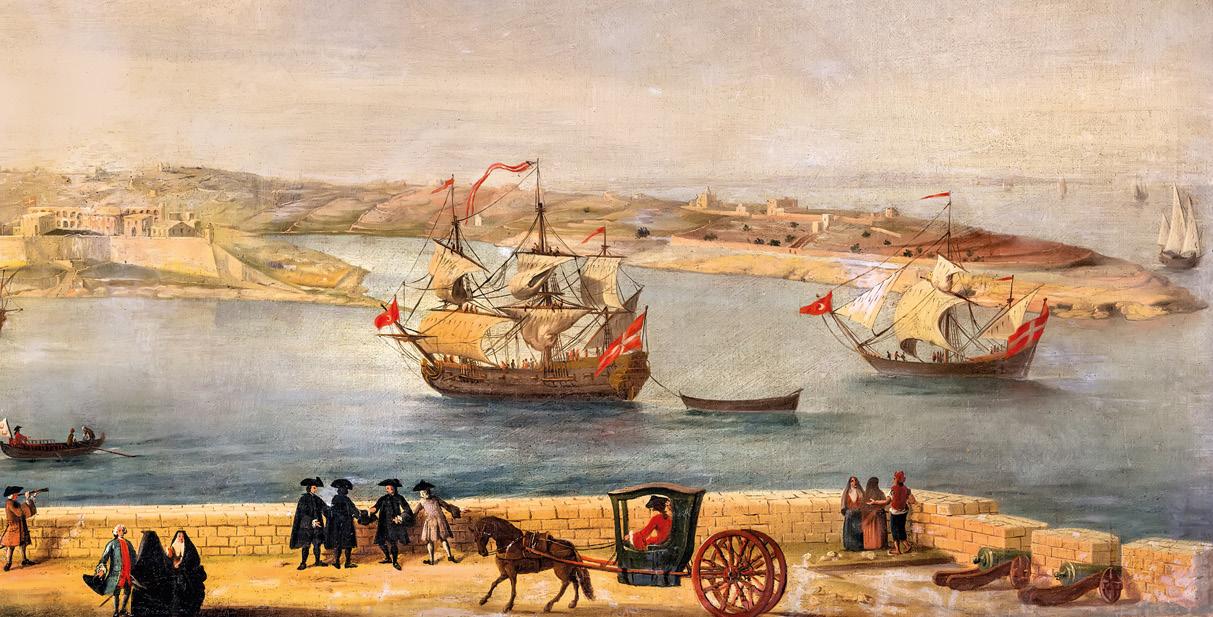
In 1736, Gregorio Cassar kissed his wife and young son goodbye and stepped aboard a corsair ship bound for fortune – or death. A cooper by trade, Gregorio had once hoped to leave the sea behind. But like so many islanders before and after him, he was drawn back by necessity. Life in Malta was dependent on work and fortune upon the waves.
His journey would span decades and empires. On his first adventure upon the waves with the corsairs, he was captured on the Tunisian coast. Gregorio was marched in chains nearly 2,000km to Derna, sold into slavery, and to better his chances at survival, he converted to Islam. In Tripoli, he worked as a cooper, married a local woman, and fathered six children – secretly baptising them with seawater and salt in the palm of his hand, conjuring up his own prayer in Maltese and Italian.
Over 40 years later, his Tripolitan wife passed away. Now an old man, he escaped aboard a merchant ship with two of his surviving sons hidden among the cargo. The voyage was perilous; one son was captured by harbour guards, but Gregorio and his son made it out of Tripoli. After an uneventful journey, Malta was sighted. It had been years since Gregorio had set eyes on his island home. The bastions gleaming with cannon must have been a welcome view as the brigantine slipped into the Grand Harbour – that most important natural asset, so well defended by the fortifications of his island home, which still stand to this day.
In quarantine at Barriera Wharf, a good 43 years after his departure from his home country, Gregorio, together with his son bearing the Christian name Antonio, inspected the onlookers behind the barriers. Among them were the various Maltese merchants, who had goods aboard the ship that had been his liberator, and the numerous characters anxious of news from Tripoli.

One day, during the long-drawn-out quarantine imposed upon the ship to purge it of any diseases it might have carried, among the visiting crowd, anxious for news and gossip, appeared his Maltese wife. Catarina must have been gobsmacked. Gregorio’s perplexed Tripolitan son must have also been amazed to meet his father’s first wife. Their conversation and their feelings are not found on the pages of the mundane documents that have kept this unique human story alive.
Gregorio’s story, grounded in archival truth, is one of countless Mediterranean odysseys that unfold in Morte o Fortuna, a book that gives voice to those who lived on the edge – corsairs, merchants, renegades and refugees, who navigated a world of fluctuating borders, where cannon fire and commerce were two sides of the same coin.
The book’s heartbeat is Malta – an island forged not only by stone and salt, but by the exchange of cultures, languages and loyalties. Gregorio’s Bormla, with its bustling dockyards and narrow lanes, stands today as a testament to that layered history.
From its waterfront, one gazes across to Fort St Angelo in Birgu, once the nerve centre of the Knights of St John and now open to the public and managed by Heritage Malta. There, high above the Grand Harbour, one can imagine the very ships Gregorio once sailed aboard slipping out past the bastions.


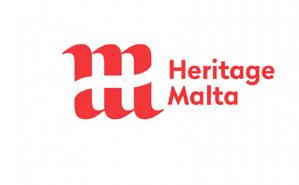
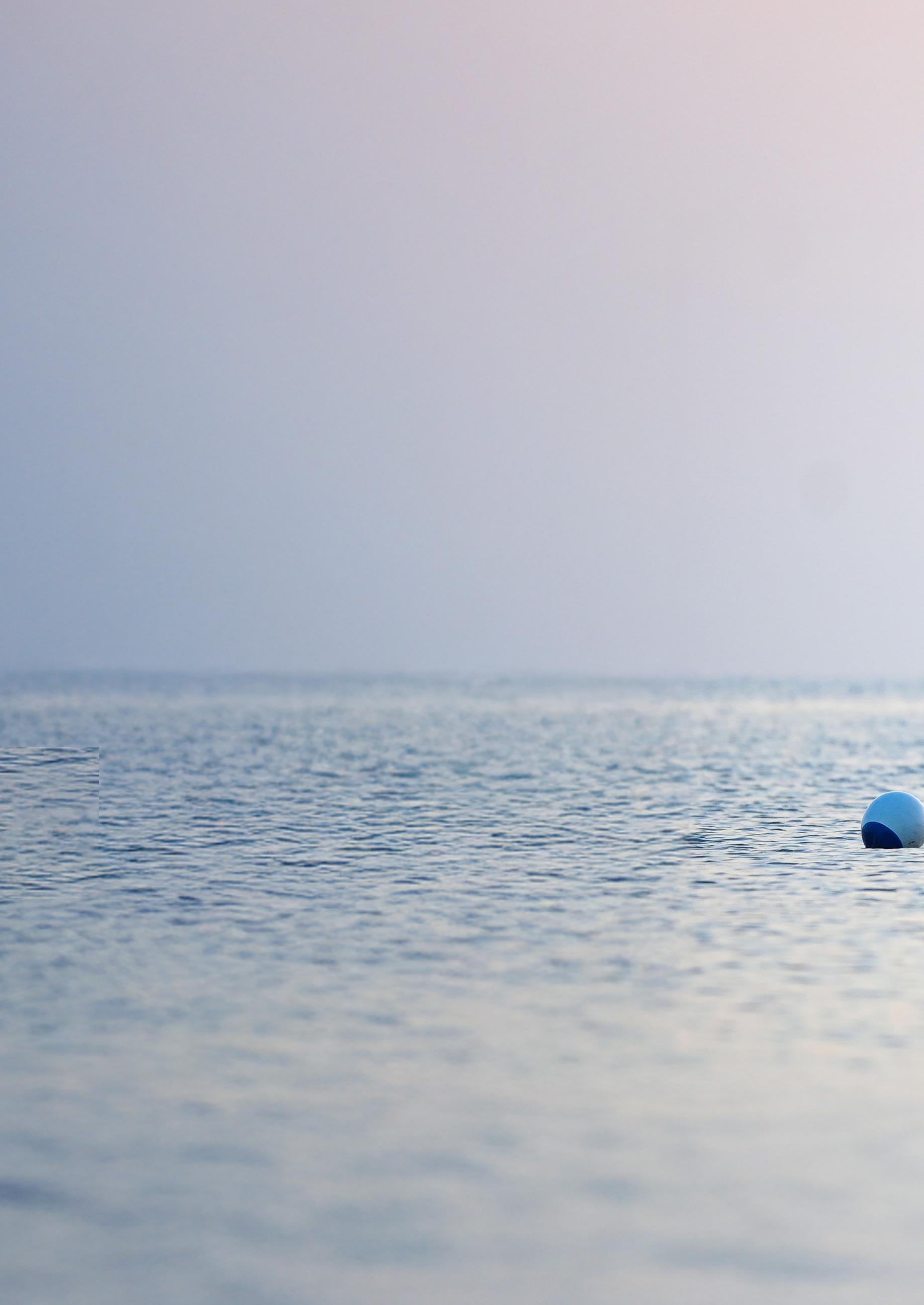
Words by Vanessa Macdonald
Vanessa is a former journalist who knows there is still so much more to discover about her country.
SUP yoga is not just any exercise; it’s a chance to find a calm space to focus on rebalancing everything – literally. For a total workout, with an emphasis on fun, in blissful seaside surroundings, it’s the island way to keep fit.
There is a point at which all your senses stop jangling and your daily stress seeps out of you without even a by-your-leave. You lie down, looking up at the clear blue sky, with the background noise reduced to a murmur, and just a slight rocking motion from the sea beneath you.
The sea, in this case, is at Ġnejna, a partsand-part-rock-part-clay-slopes bay on the northwestern side of the island. It may have a few kiosks, some boathouses and some caravans, but to the left – where the bay falls behind you – is a little cove.
The splendid isolation, just a short paddle out from the people and boats in the bay, is one of the reasons that the 2004 film Troy used the slopes just above the cove as one of its locations in Malta.
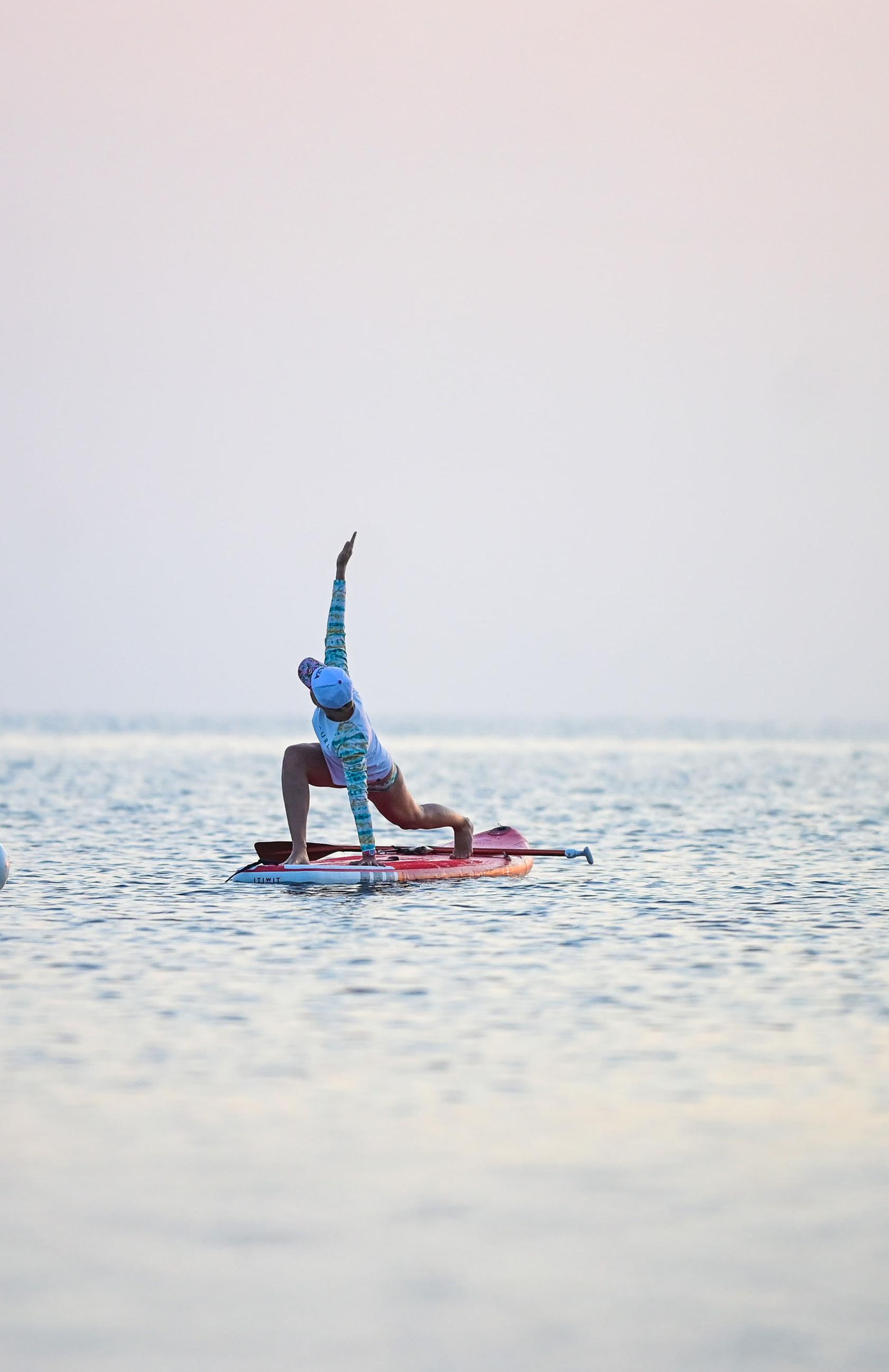
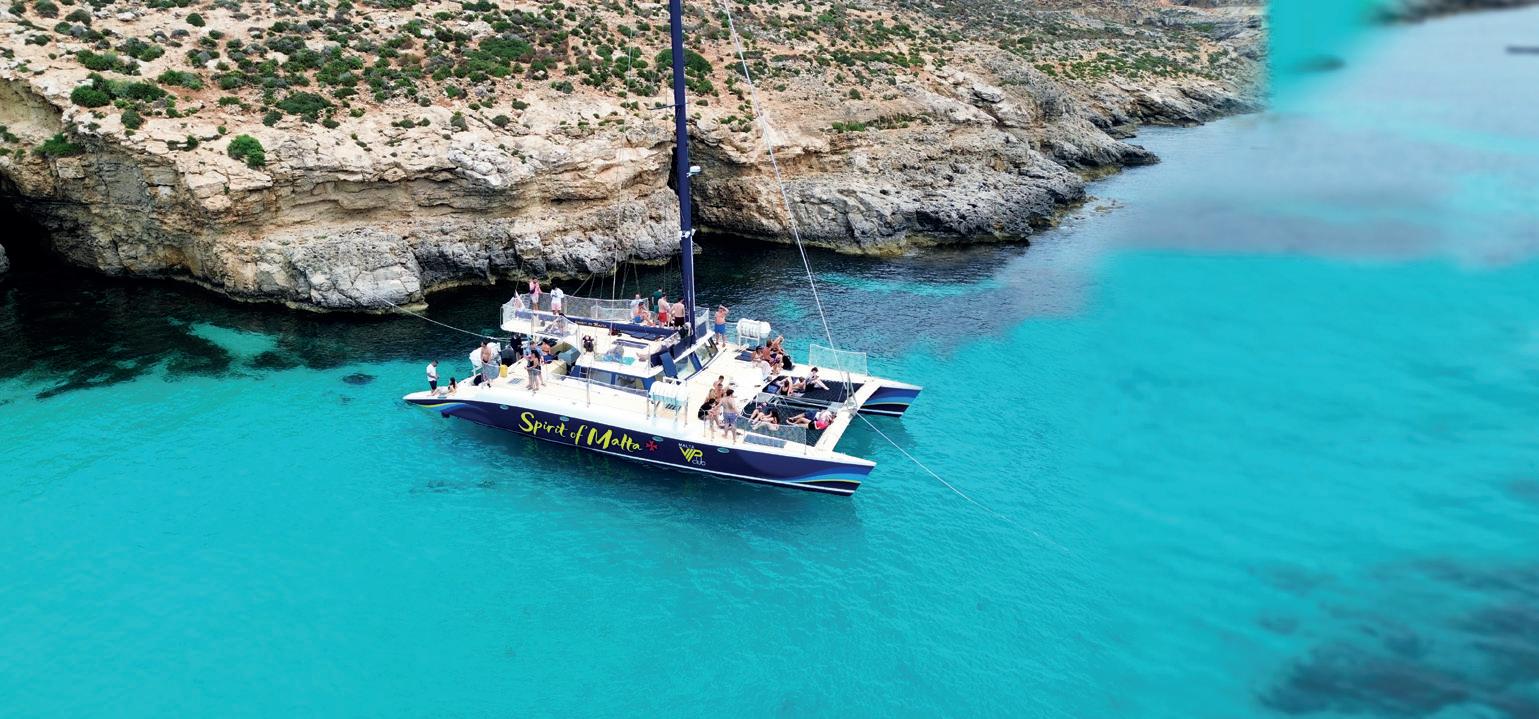
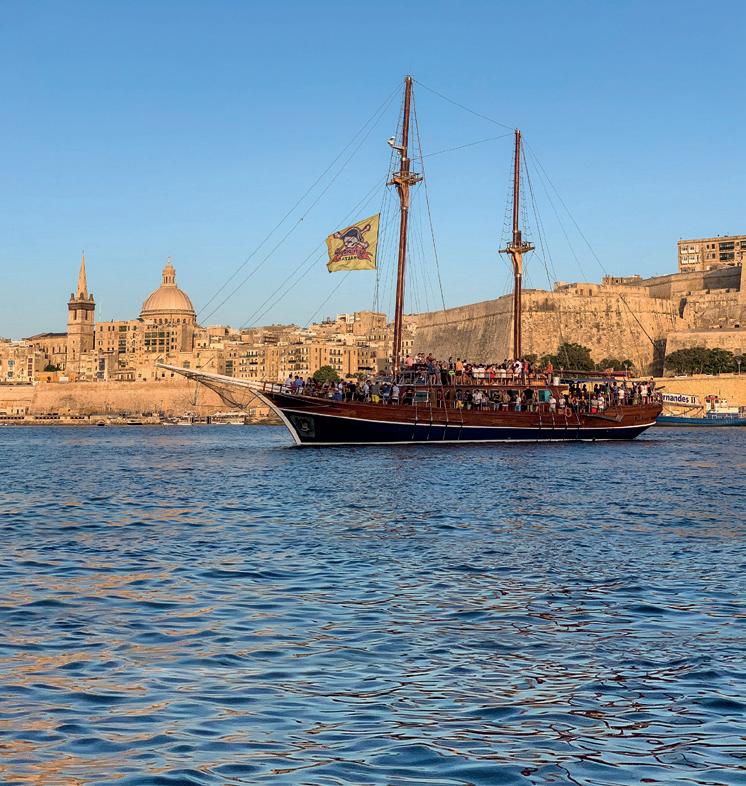

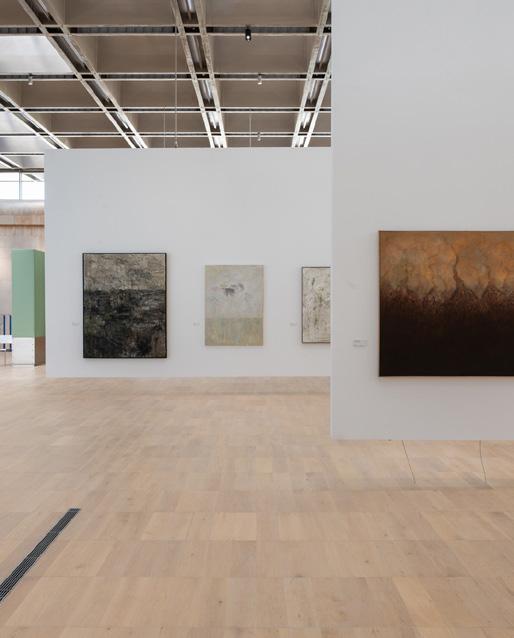

This is one of Svetlana Abela’s favourite spots for her lessons, which combine the benefits of yoga with the challenges of not falling off a stand-up paddleboard (SUP). She has been teaching yoga in Malta since shortly after she moved here with her family.
After the harsh winters of Northern Europe, the azure waters and blue skies in Malta were a welcome change, but yoga was not yet that popular. She opened a studio, offering various styles of the discipline, and now offers yoga retreats. But it was not long until her attention turned to the combination of exercise and rebalancing offered by SUP yoga.
“We have around 10 people per class – sometimes more and sometimes less – with a real variety of ages and nationalities,” Svetlana says as she paddles out to the cove.
The yoga itself can be anything from basic level to advanced, while the SUP is surprisingly achievable to handle with the right tips – everything from how to get on to the board, to finding your balance and standing up, and then to paddle.
Sveta, as she is better known, offers a wide range of yoga classes, including aerial yoga, but she is clearly in her element on the sea, finding it a marvellous
place for people to find a calm space in which to focus on rebalancing everything from posture and balance to muscle and mental stress.
Having to add the movement of the SUP to the balance required for all the classic yoga poses means this hour or two will provide a total workout, not just of your core and limbs, but also with an emphasis on fun.
“Most of the people who come to the classes are familiar with yoga on land, but it is very different to be on a board! You know that there is a very real possibility of losing your balance and falling into the water,” she says. “This is why our classes are really all about laughter as the idea is to have fun!”
Sveta deliberately chooses places – like Ġnejna –where it is easy to paddle out from the shore, and to put down anchors from each board to keep the group close together.
“The last thing you want is to look for a peaceful spot but then have to shout to make yourself heard,” she laughs.
Indeed, the stillness is a very important part of the yoga experience, meaning that her students only need sunblock and the right attitude. Everything else is provided.

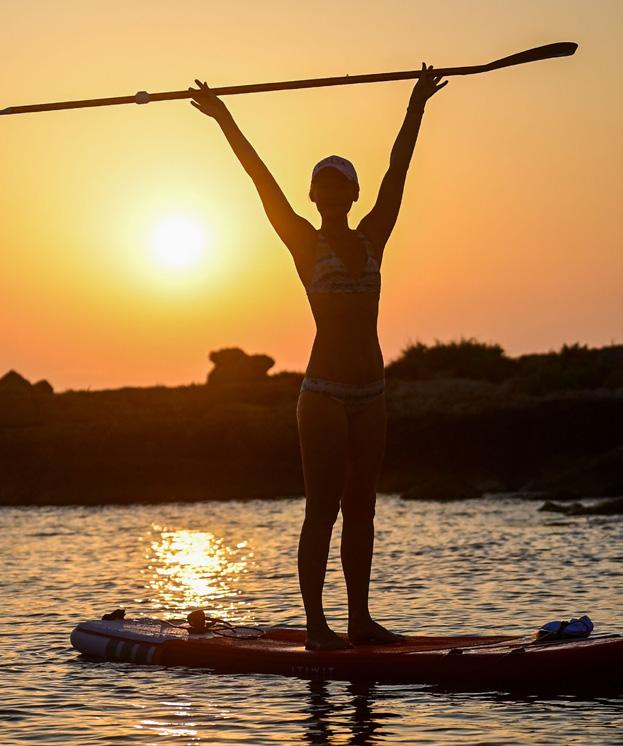
Sveta was introduced to yoga by her mother when she was 16 and was immediately hooked. She was subsequently trained by various yoga masters all over the world, including India, Germany, Spain, Greece and the US.
However, it was only some years later that she ran into a friend at a yoga conference in Germany who was practising SUP yoga on a lake.
Although SUPs only became popular recently when inflatable versions made them lighter and more convenient to carry, they have actually been around for a while. In fact, the first SUPs date back to the 1940s in Hawaii, where surfers opted for longer boards that they could stand on to paddle their way through the crashing surf waves.
The idea intrigued Sveta, and she first started offering SUP yoga in 2012 from a beach in the north, overlooking the Comino channel. Now, she has a number of venues depending on the weather. Since then, others have also started offering classes, but being the first gave her that edge, she says.
“My regulars love the classes. There is just a moment where you leave the rest of the world behind and your senses focus only on the heat, the gentle lapping of the waves, the lovely sounds of nature, and your mind and body. It is magical!” she says.
Find out more from the SUP Yoga Malta Facebook page.
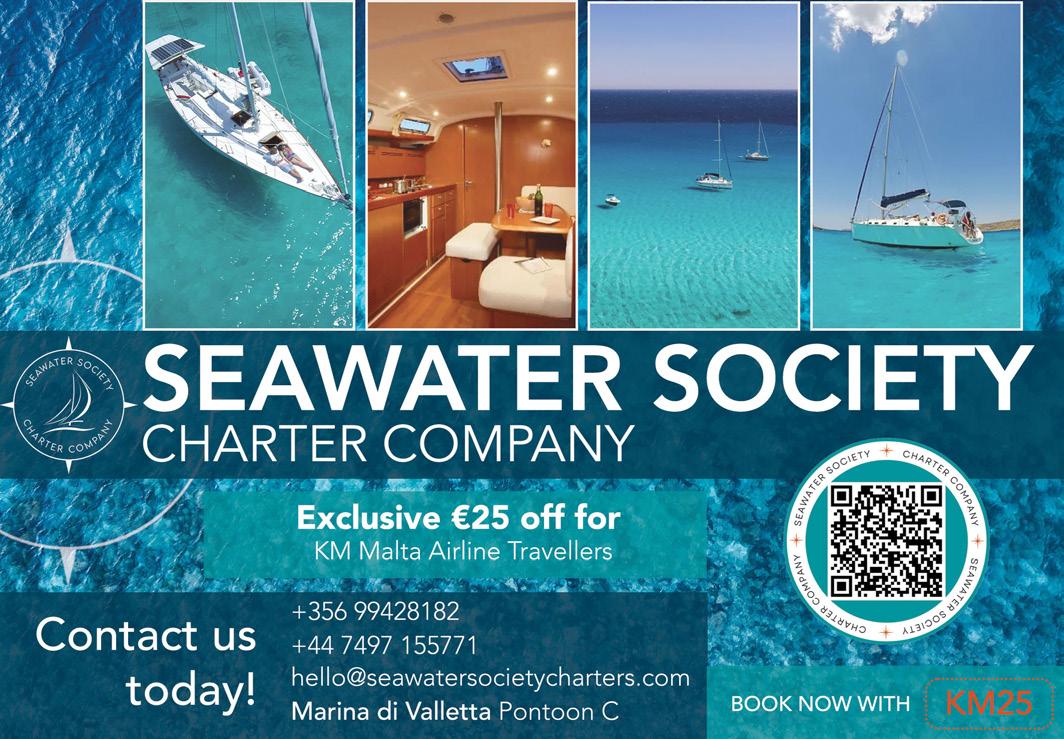
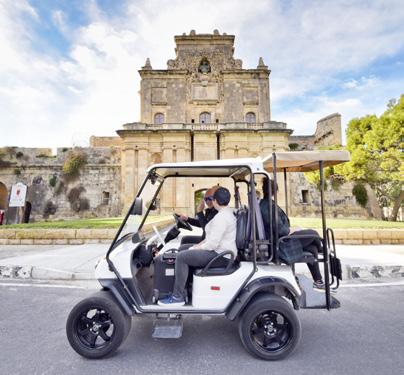
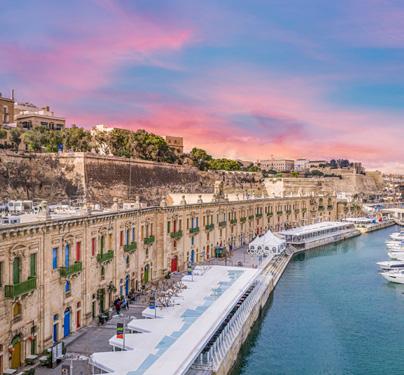
Rolling Geeks offers an exciting, new way to explore the Three Cities. Imagine cruising through this stunning open-air museum in a sleek, fun, eco-friendly, easy-to-drive car, following a cutting-edge GPSguided route to explore at your own pace, while on board commentary in your chosen language brings the surrounding rich history to life. Whether you’re a history buff or just looking for a unique adventure, Rolling Geeks is the ultimate sightseeing experience. Affordable and flexible, it offers a fresh, unforgettable perspective on Malta’s beauty.
(+356) 7995 0695
rolling-geeks.com
VALLETTA WATERFRONT
Triq il-Vittmi Furjaniżi tal-Gwerra, Floriana
Discover this hidden gem within Malta’s Grand Harbour, where history meets modern indulgence. Enjoy panoramic views, exciting activities and delectable dining experiences along this promenade. Savour Chinese, American, Mediterranean, sushi, or local cuisine in beautifully refurbished 1752-built stores, or dine al fresco by the water’s edge. Just a short walk from central Valletta, experience fun and relaxation away from the crowds. There is always something happening at Valletta Waterfront, especially in summer, with cultural celebrations, seasonal events, live music, special themed nights and family-friendly activities that bring the promenade to life.
vallettawaterfront
vallettawaterfront.com
Words by Palazzo Parisio
Some places whisper their secrets only to those who know how to listen. Frederica Agius, Palazzo Parisio’s new curator, is helping the palace’s extraordinary tales find their voice and come to life.

At Palazzo Parisio, every marble surface, every painted cherub and every carefully crafted detail holds a story that will transform a visit into an intimate conversation with Malta's most fascinating aristocratic legacy.
This remarkable palazzo has witnessed centuries of transformation, beginning as Grand Master Antonio Manoel de Vilhena's hunting lodge in the early 1700s. The elegant orangery, created in 1733, and the chiselled stone grotto still grace the grounds today – silent witnesses to nearly three centuries of history.
The Parisio family lent their name to the estate in the late 1700s, and in a delicious twist of fate, Paolo Parisio even hosted Napoleon himself in 1798 after the French invasion. But it was the visionary Marquis Giuseppe Scicluna who, upon acquiring the palazzo in 1898, enlisted renowned Italian architect Carlo Sada to transform it into a glorious winter palace, a mini-Versailles that was completed just a year before the Marquis's death in 1907.
Take the marble handrail, for instance. Most visitors glide along it without realising they're touching the largest single block of marble on the island – a six-metre masterpiece sourced from the same Carrara
quarries that supplied the Victoria and Albert Museum. What they don't know is the delightful drama behind its arrival: it took three attempts to transport this beauty to Malta, breaking twice before finally making its triumphant journey to the palazzo.
And the marble pattern beneath your feet on the landing? It mirrors the very floors of the Vatican, laid by master craftsman Giuseppe Valenti, with the precision of a Renaissance artist.
Marquis Giuseppe Scicluna, the palazzo's original patron, was a man of extraordinary vision and surprising humility. While commissioning what would become one of Malta's most spectacular private projects, he worried about whether the opulence was excessive. But this same gentleman was quietly financing Fra Diegu, a shelter for battered women, and sent his palazzo artisans to complete that charitable work with the same dedication they brought to the palace’s gilded halls.
When you arrive, be sure to look closely at the playful putti frolicking across the study walls. Yes, they are decorative cherubs… but they’re also clever visual puns, referencing the Marquis's banking empire. Lean in and you'll spot them exchanging money and cheques, a cheeky nod to the Sciclunas, who introduced cheque banking to Malta. The locals couldn't quite pronounce ‘cheque’, calling it "iċ-ċisk" instead; a mispronunciation that eventually lent its name to Malta's beloved local beer, which the family helped create.
In the Pompeian dining room, the Roman goddess gazing serenely
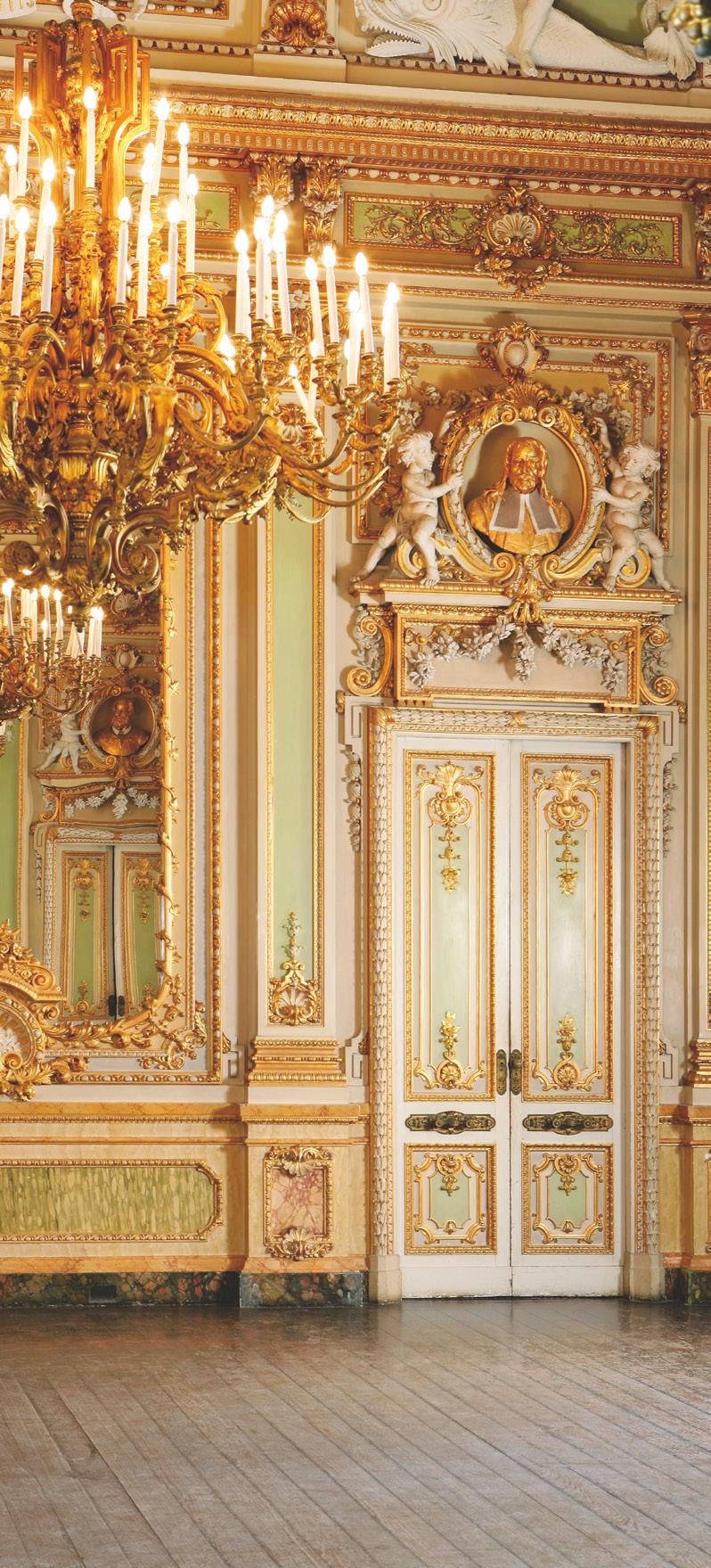
from the painted walls is Corinna Scicluna, the Marquis's wife, immortalised in mythological splendour. Meanwhile, the ships sailing across another painting aren't artistic flourishes but actual vessels from the Scicluna merchant fleet.
Even Francis Ford Coppola couldn't resist the charms of the palace. He reportedly coveted the cherub lamps in the billiard room, but fortunately, the Scicluna family remained firm, and the cherubs stayed put, still illuminating the billiard table today.
This palace has been guided by remarkable women for generations, from Violetta Testaferrata, who brought musical recitals and cultural soirées to Malta's elite, to the current Baroness Justine Pergola, continuing this tradition of opening the palace doors to beauty, creativity and community.
But perhaps the most extraordinary secret is this: Palazzo Parisio wasn't built as a museum to be admired from afar. This historic space was designed as a living, breathing home, where art, culture and hospitality converge.
Today, whether you visit for a legendary afternoon tea, a leisurely lunch in the gardens, or an intimate dinner surrounded by Art Nouveau masterpieces, you're becoming part of a continuing story.
Come and discover what else Palazzo Parisio has been keeping secret. After all, the most beautiful stories are meant to be shared.
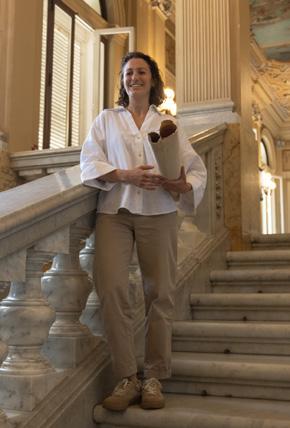





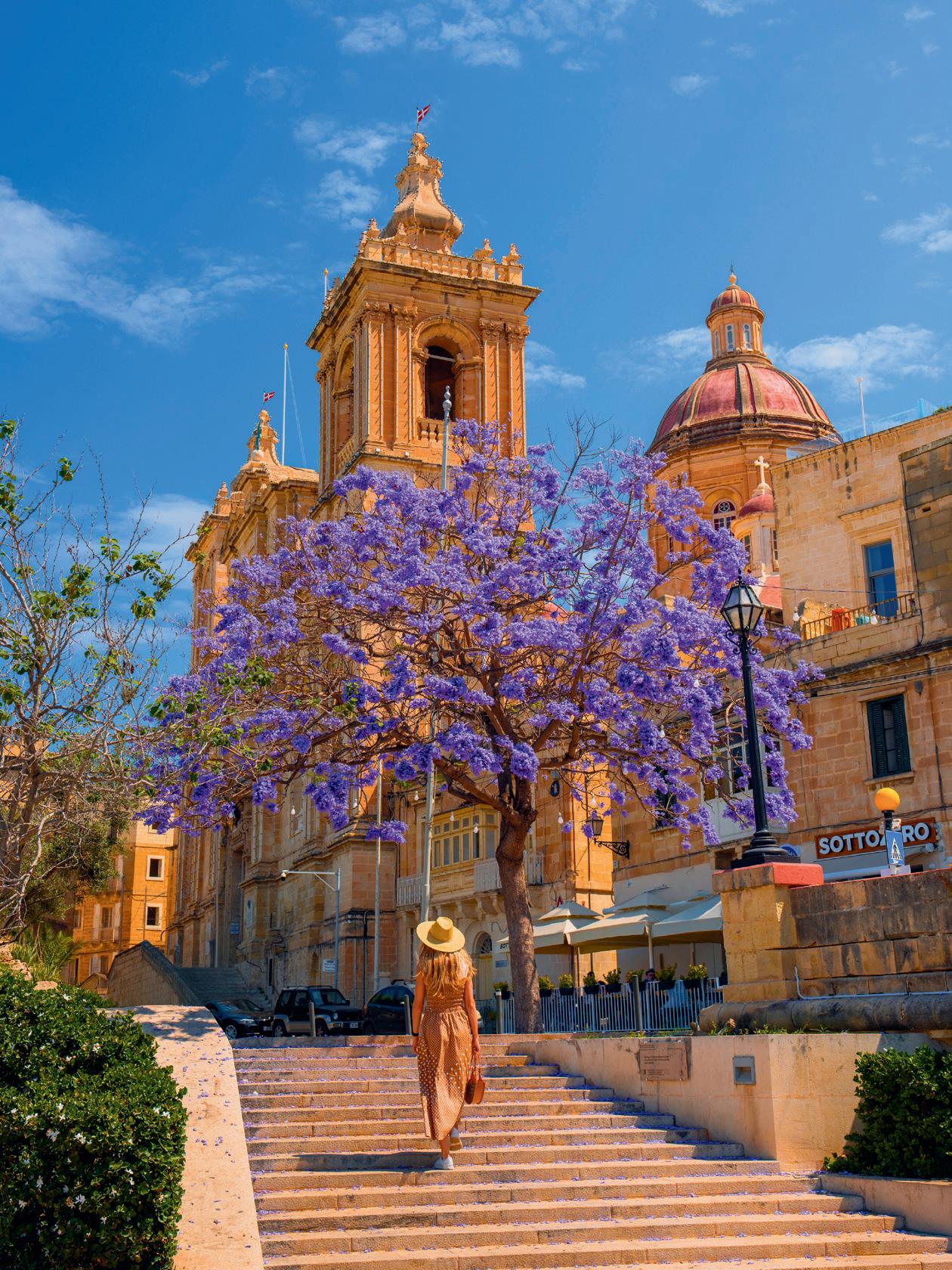
Birgu ( Città Vittoriosa )
Discover the maritime city of Birgu (also known as, ‘Città Vittoriosa’), one of Malta’s oldest and most captivating cities. @VisitMalta
Once Malta’s gateway to the Mediterranean, Birgu’s rich history predates that of our Capital City, Valletta, offering timeless charm and stunning seafront views.


Words
by Dean Muscat
Dean is a writer and musician who is increasingly drawn to exploring and writing about the stories and places that shape his home island of Malta.
From teenage misfits to indie mainstays, Beangrowers' Alison Galea and Ian Schranz rewind the tape on their early days, evolving sound and why mental health has always been part of the conversation.
From the outside, it looks pretty sweet to be the Beangrowers these days. Three decades in, the band is still the same trio who started it all back in 1994, with vocalist and guitarist Alison Galea, bassist Mark Sansone and drummer Ian Schranz holding tight to the chemistry that’s defined their sound from day one.
That alone is certainly worth raising a glass to. But there’s more to celebrate as Beangrowers continue to command a loyal following and remain one of the few Maltese bands to have broken through internationally. Now, they’re also being discovered by a fresh wave of indie kids, fans who weren’t even born when their debut album 48K was released.
“There’s a formula and a familiarity to Beangrowers,” Ian says. “The band only really works when it’s the three of us in a room. While we can’t give the project as much time as we used to, when we meet up, there’s this dynamic that just clicks. And there’s a history and life behind us now, which makes it more special.”
Alison nods in agreement. “It’s a really nice space to be in, especially when you see friends coming out to see us and these younger kids getting into our music, still caring. That means a lot.”
In many ways, Beangrowers have been a band against the odds from the very beginning, emerging at a time when Malta’s music scene was under the long shadow of 1980s rock, where big riffs and even bigger solos ruled the day. The three teenage Beangrowers shared a love for grunge and alternative music. Their stripped-back style, sci-fiinspired sounds, and the fact that they were fronted by a woman made them an outlier from day one.
“When we started, most of the scene didn’t know what to make of us,” chuckles Ian. “We had these simple riffs that people thought sounded amateur. But then Nirvana blew up, and suddenly that sound was undeniable.”
So, while Malta’s music scene was busy catching up, the Beangrowers were already miles ahead. With a clear aesthetic and a growing catalogue of songs, the trio began recording demos and building a local buzz. Then came one of those lucky turns when talent meets timing.
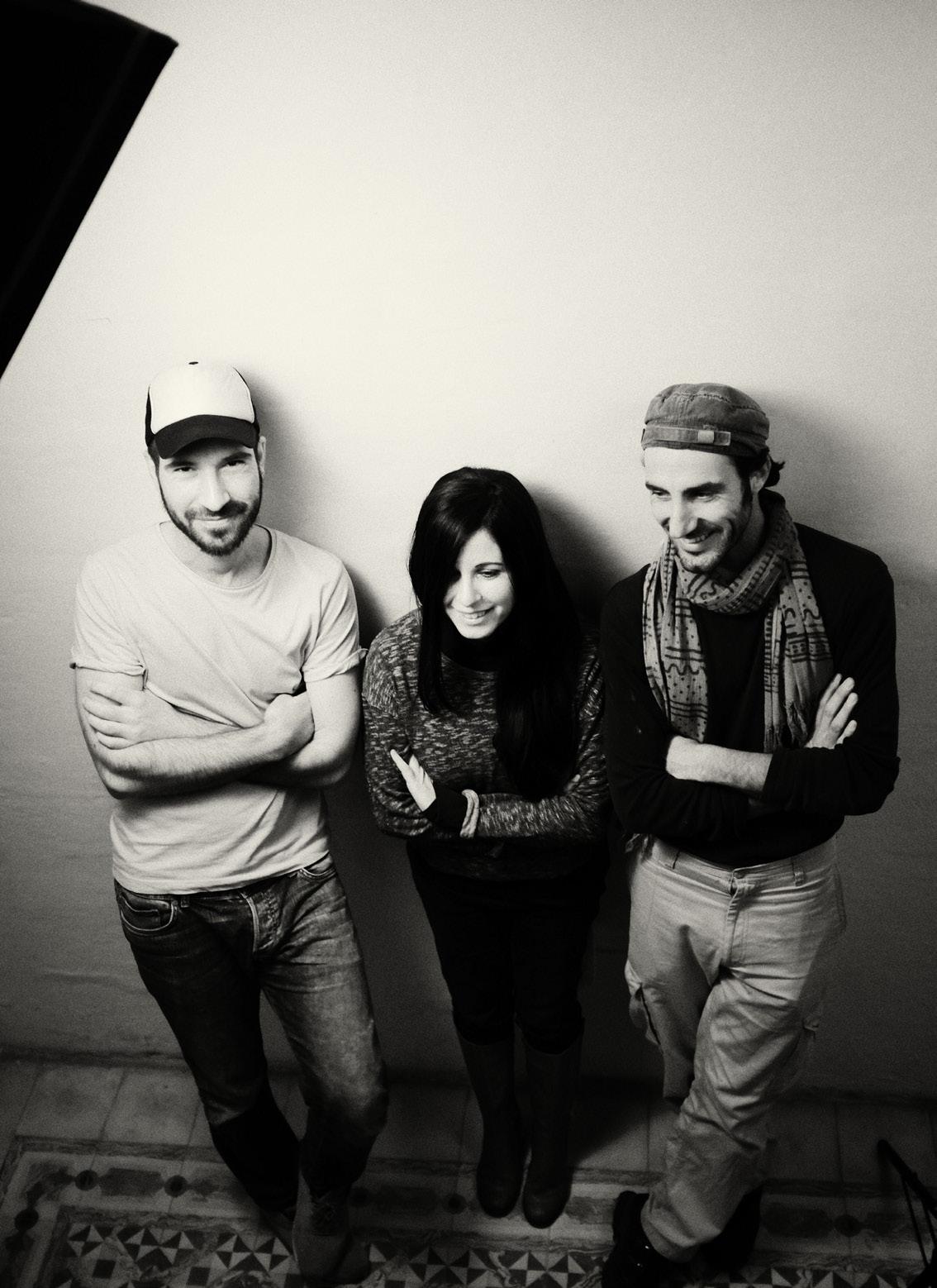
As Alison recalls: “It all happened pretty fast, but within a couple of years, we found ourselves invited to a music showcase in Germany, and that led us to being signed with Rough Trade.” That’s the same Rough Trade behind legendary acts like The Smiths and The Fall.
Alison sounds a little amazed at it all today. “We were wide-eyed teenagers, and we had no idea how we ended up there,” she says. “Malta was very provincial back then, and Berlin felt wild. We were like village kids dropped into this big, transgressive world. It was incredible.”
This was also a different era when even indie labels had serious budgets. For Beangrowers, that meant a tour bus, promo shoots and long stretches on the road as they built up their following across Europe. It also afforded them serious time in the studio to record their material. They laid down songs with local producer David Vella, who gave them space to experiment and chase their own sound, messing about with analogue synths and cheap plastic toys to get unusual sounds and beats.
“We were a three-piece with one voice,” Ian explains. “So, the studio was where we were really able to expand on our core sound with the right textures and atmosphere.” They even got to work with Gareth Jones, the studio stalwart behind huge acts like Depeche Mode. “He was muting mics, doing things we’d never seen. Over time it gave us a casual confidence in the studio,” he continues.
“When I look back on those first two albums especially,” Alison says, “what we had was the luxury of time. We could spend three months in the studio. That just doesn’t exist anymore. Now it’s record fast and get out.”
By the time their third album was released, Dance Dance Baby in 2004, Beangrowers had grown up musically, personally and professionally. They decided to go fully independent and started navigating the industry on their own terms. Touring abroad had also opened their eyes to growing conversations about inclusion and mental health, which back in Malta were subjects wrapped in silence for the most part.
The band became early supporters of the Richmond Foundation, one of the few local organisations tackling mental health head-on. “We were doing this long before it became part of the mainstream conversation,” says Ian. “For us, inclusion and being part of something that mattered was important to us as a band and our community.”
This year, Beangrowers is back to headline the first night of Rock for Richmond, the annual fundraising festival now in its sixth edition. The event, which the band helped co-found alongside Mario Vella of local band Brikkuni, has become a staple of the alternative music calendar and a powerful platform.
“We’re always happy to be part of it,” says Alison. “We’ve followed Richmond’s work for years and seen how much impact they’ve had. The festival is such a warm, friendly space. Musicians come together and play for something real.”
So, what can fans expect from this year’s set? “We don’t gig much these days, so we are really looking forward to it,” Ian notes. “We might dig up an old track or two we haven’t played in a while and maybe bring a friend on stage. We can’t wait; it’s always a great crowd.”
And for fans new and old, there’s even more to get excited about. After a rather quiet spell following their last release, Dystopia in 2019, the band is heading back into the studio with long-time producer David Vella once again at the helm.




“It’s the first time in a while that we’ve actually booked the studio and said: ‘Right, let’s do this!’ We’re ready to commit, get our agendas aligned, and make it happen. In many ways, nothing has really changed. Myself, Alison, and Mark are here, David’s still here, it’s the same studio. And after all these years, it really feels like home.”
For more details on the Rock for Richmond festival, turn to PG 35 or head directly to online arts and culture guide Inkontru.app
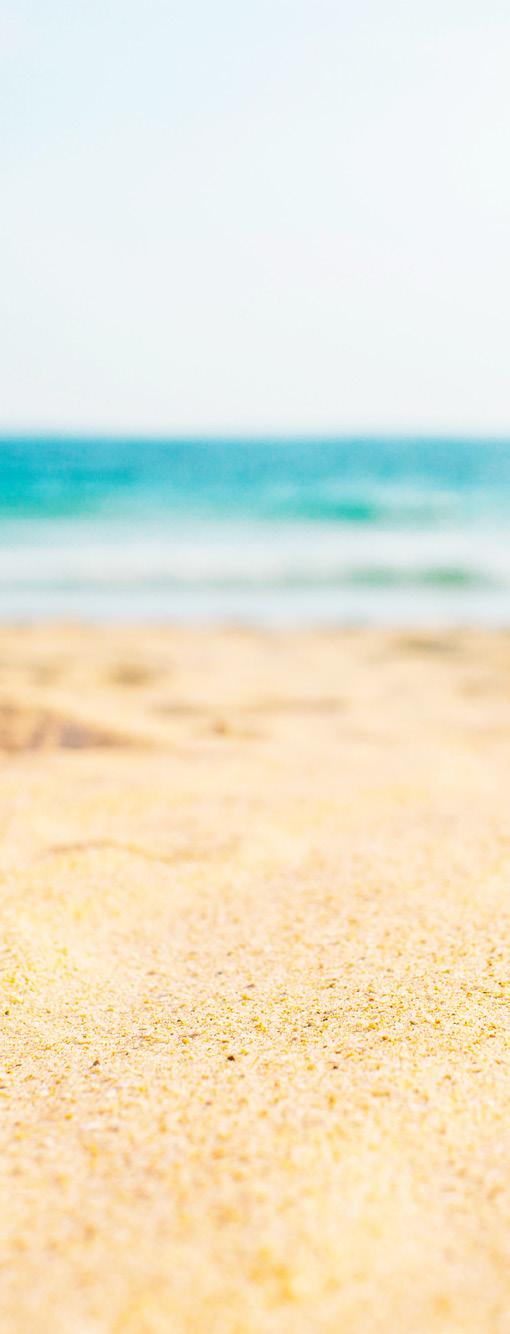


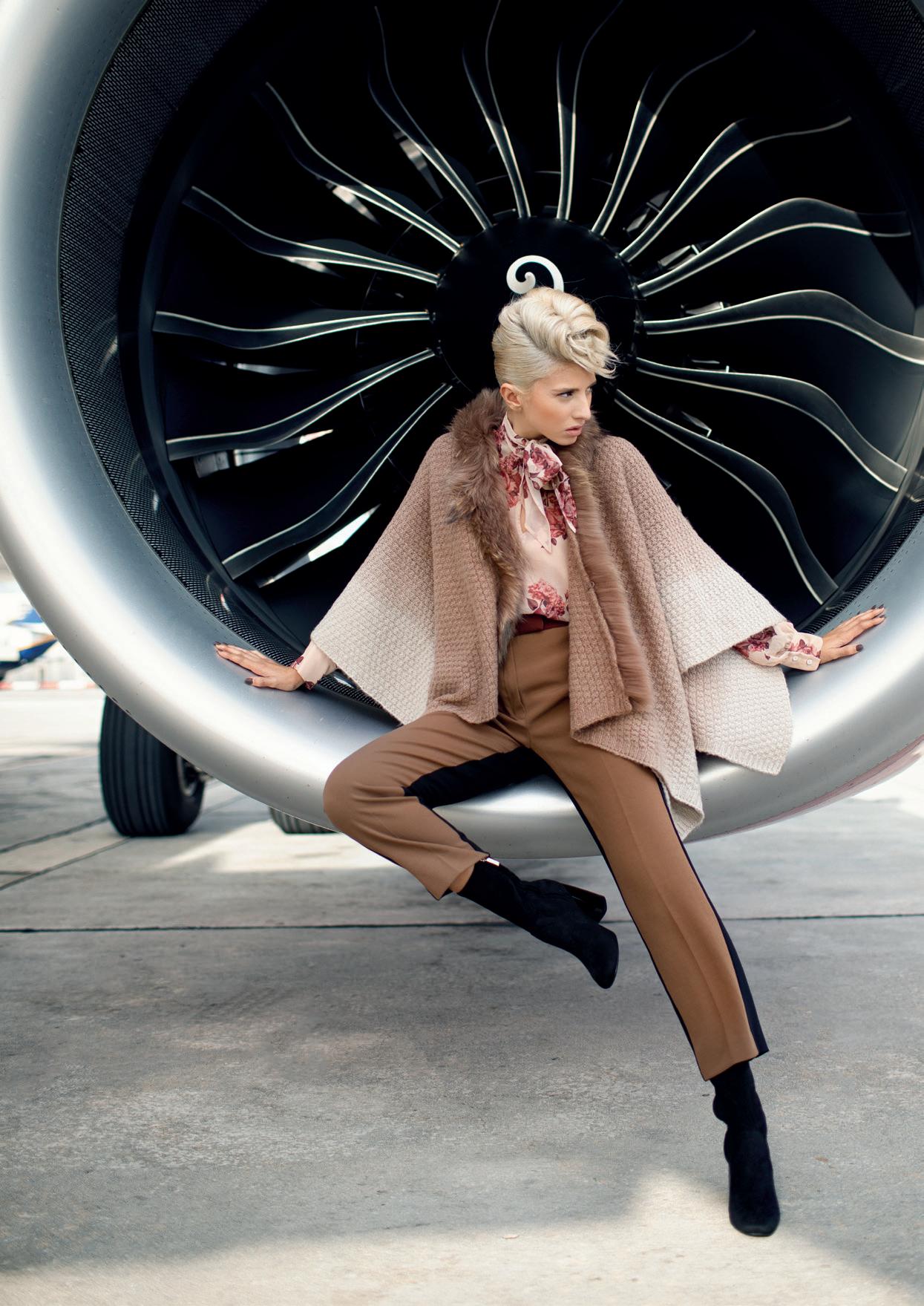

Sarah Vella Zerafa in a photo shoot for Pink magazine.
Kurt
Words by Anna Marie Galea
Anna Marie is a writer, shopaholic and gourmand. When she's not looking up the best restaurants to visit in other cities, she loves playing tourist in her own country.
What happens when an aviator and an influencer meet? Sparks fly! Here’s how Sarah and David Vella Zerafa’s romance took off, grew in mid-air, and had a soft landing in marriage, with some jet- and trendsetting in-between.
A truly modern-day love story, Sarah and David Vella Zerafa didn’t meet up in the air but very much on the ground… or rather via social media. Sarah, a hugely successful local content creator, who currently has 3.1 million followers on Instagram, spotted David in the wild when he used to like her photos.
“I had never met David before in person, but he used to like my photos, and I used to like his back to signal my interest. When he didn’t directly message me, I decided to try another way to get his attention. Because I knew he was a pilot, I created an answer box on one of my Instagram stories with the question: ‘Can someone take me to Santorini?’ Happily, he finally got the message and wrote back: ‘I’ll take you to Santorini!’”
Their first date was at Nine Lives in St Paul’s Bay, and they spent four hours chatting non-stop. But their second date had to be delayed by a bit because David, a First Officer, was flying to Amsterdam the next day to see his sister: “Our second date started with me picking him up from the airport after his trip. He brought me back a gift – a thermos,” Sarah laughs playfully, reminiscing.
“It was the first thing I saw, and I didn’t have time to get anything else,” David replies, laughing even louder.




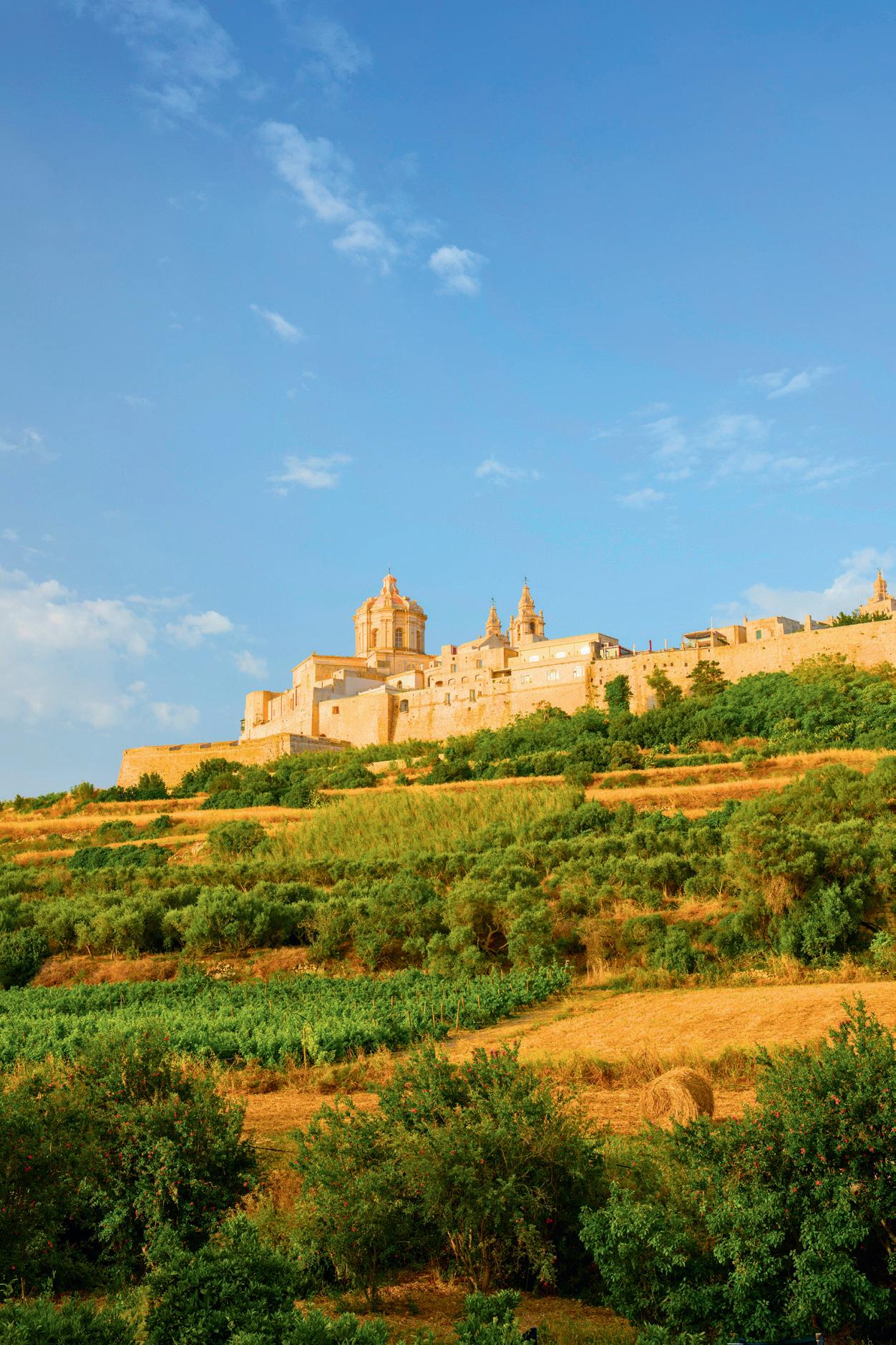
Behind its fortified walls, Mdina’s timeless beauty has been mesmerising visitors throughout its 4,000 years of existence. @VisitMalta


“All my friends thought I was going mad, but the thing is that I knew David was the one from the very beginning because I always felt so safe and comfortable with him. He’s been nothing but supportive since day one.”
Even though their relationship didn’t start on a plane, they seem to have spent a lot of their early days up in the air. A week after their second date, Sarah was going to Athens for a job and David decided to join her.
“All my friends thought I was going mad, but the thing is that I knew David was the one from the very beginning because I always felt so safe and comfortable with him. He’s been nothing but supportive since day one.”
So, with two demanding jobs and very different schedules, how do they find time for each other?
“Sarah works around the clock,” David starts. “Her job is immensely fast paced and varied, and if she’s not filming content or coming up with ideas, she’s in meetings or replying to e-mails and messages. My roster for the next month comes out mid-month, so we try to plan around each other as much as possible.
“For us, the important thing is that we manage to make time for each other. One of the advantages that Sarah has is that, because she’s self-employed, she’s more flexible when it comes to planning holidays.”
Asked where they love to travel to, the answer is unanimous: “We are huge fans of Paris, and it holds many very happy memories for us. We got engaged in Paris and had a joint bachelor and bachelorette party in the City of Lights. Everyone can’t believe we keep returning, but it’s such a magical city. The lights, Disneyland, the shopping, the food… It’s a dream! We love going to Maxim’s de Paris for dinner and Buddha-Bar for drinks. Honestly, though, just doing nothing together makes us happy.”
Although Sarah is full of excitement talking about her travels now, it’s important to note that she was once a very nervous flyer. When asked if travelling with a pilot makes things easier for her, her answer is emphatically positive.

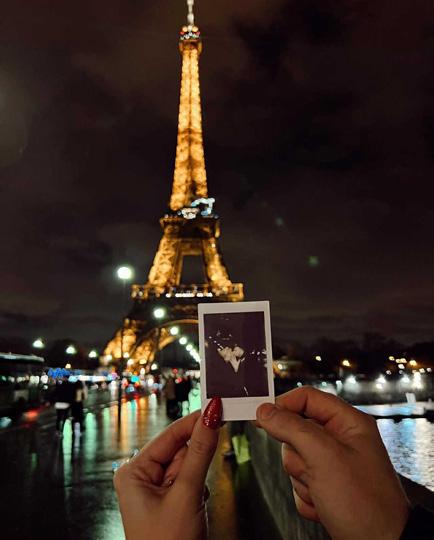


“Oh, yes! Flying with a pilot offers a different experience because they’re obviously very knowledgeable about what’s happening. Before, every sound and bump would bother me, but David always goes out of his way to explain what things mean, so I’m far more relaxed these days.
“It also helps that he’s constantly studying, so I can see firsthand the amount of time and effort that goes into being an aviator. I’m so, so proud of him. I even got to experience him at work once; I got onto the plane to attend London Fashion Week and was amazed to see him in the cockpit – it was a lovely surprise.”
So, what have they learnt from each other through their journey together so far? “I feel like we really complement each other,” David begins. “Sarah is so inspirational to me because she’s so creative and such a hard worker. Some days, she works from 7 in the morning till 9 at night, and I look at her and think that I definitely couldn’t do everything she does. She never gives up, and I can’t help but be immensely proud of her.”
A beaming Sarah adds to his sentiment: “For me, what he does is extraordinary, and he is living proof that anything is possible if you study and put your mind to it. David has been my absolute rock from day one and always pushes me to be better. I couldn’t ask for more.”




Words by Roy (with a little help from Ruth Zammit DeBono – paws don’t type!)
Ruth is a passionate traveller, artist and devoted dog mum, who finds joy in storytelling and discovering the world always with her pet by her side.
Ciao, furry jet-setters! Roy here – your trusty four-legged guide for a pawfect day out in Gozo.
Now, if you’re visiting Malta this summer and itching (hopefully just metaphorically) for a little adventure, then Gozo is your island escape. Just a short ferry ride from Malta, this little gem packs big charm, sniffs and tail-wagging trails.
GETTING THERE – EASY, BREEZY, WAGGY
Hop aboard the ferry with your humans – small dogs like me can travel in soft carriers (or on leads, depending on the operator). You’ll catch a breeze, glimpse of the sea, and probably steal the show from the sunset. Take your pet passport and water bottle with you – we travel smart around here.
SNIFFS, SUN AND SIGHTSEEING
First stop? Victoria, Gozo’s capital, where narrow alleys meet oldworld elegance. The paths around the Citadel offer stunning vistas and plenty of cobbled curves to explore. I recommend an early start to avoid the midday heat. Gozo sun is no joke when you’re wearing a permanent fur coat.
BEACH? YES, PLEASE.
Head to Xlendi or Marsalforn for a seaside stroll (leads required). While most beaches in Malta and Gozo are not really dog beaches, walking
your human responsibly along the promenade is welcomed. Shade and fresh water are a must. Bring both!
LUNCHTIME = TREAT TIME
There are numerous outdoor cafés you can visit with your human, so they can sip a cold drink while you can lounge under the table like the royal you are. I usually flash my best ‘travel influencer’ look and am treated to crunchy cold snacks. Works every time.
CULTURAL SNIFFS & SCENIC SITS
Stop by Ta’ Pinu Basilica for a peaceful photo opportunity, or sniff out the salt pans in Marsalforn. Gozo’s wide open spaces and laid-back pace make it perfect for curious pups who love to roam (with permission, of course).


Only adults may carry a pet in cabin
Soft carrier must fit under the seat and remain stowed
Max pet weight (including carrier): 10kg
Your pet must stay inside the carrier for the full flight
All pets must be at least 15 weeks old to fly
Gozo’s also a great base for longer stays. Some hotels and guesthouses are pet-friendly (ask your human to double-check when booking). It’s the kind of place where locals will greet you with a smile, and maybe a head scratch, too.
So if you’re flying into Malta with KM Malta Airlines, don’t miss your chance to add a day in Gozo to your itinerary. One ferry, four paws and endless memories…

From boarding gates to belly rubs, the journey doesn’t stop here – follow @pupspaintandprosecco on Instagram for more paws, prosecco and pup-approved places.



Words by Passaġġi

Learn about the technology that brings order to the chaos, allowing companies to unify, automate and optimise how they manage payments across different platforms, currencies and providers.
When you tap, click, or swipe to pay, it feels instant. But behind the scenes lies a complex web of systems and providers. For businesses, managing the various touch points and facets of modern payments is often a frustrating, costly challenge. This is where payment orchestration comes in: the technology that brings order to the chaos, allowing companies to unify, automate and optimise how they manage payments across different platforms, currencies and providers.
Right here in the heart of the Mediterranean, one company is solving this global challenge through smart, seamless payment orchestration. Meet Payage, a fast-rising tech player helping businesses take back control of how they move money across the world.
Payage gives companies what it calls payment independence. Through a single, intuitive platform, businesses can manage onboarding, transaction routing, fraud protection, currency conversion and reconciliation. This means always remaining free to choose the providers and payment methods that work best for them. It’s not just about handling payments; it’s about orchestrating them in a way that gives businesses greater control, smarter performance and the flexibility to scale without friction.
Founded in 2021 by fintech veteran Ian Pellicano, Payage is built on decades of experience in global payments. Ian previously founded and led ApcoPay to international success and has now assembled a tight-knit team of product leaders, engineers and operators with

backgrounds in finance, mobility, iGaming and SaaS. Together, they are building a platform trusted by highgrowth businesses.
What makes Payage stand out is its rare blend of deep technical capability and elegant, user-first design. The platform connects to over 450 integrations and more than 900 alternative payment methods, including both fiat and crypto. And this number is growing rapidly.
This broad connectivity gives businesses maximum flexibility without added complexity. So, whatever the payment type, Payage orchestrates them all through a single, cohesive interface. Its clean design, real-time dashboards, and white-label capabilities make it a powerful solution for PSPs, aggregators and regulated platforms looking to scale fast and stay in control.
But perhaps most impressive is Payage’s pace of innovation. Built on a modular, API-first architecture, the platform is designed for rapid deployment and continuous evolution. New features are truly innovative and shipped fast. This means Payage isn’t just a payments tool; it’s a foundation for future-ready financial infrastructure, built to adapt as industries evolve.
From a small island in the Med, Payage is looking to shape the way businesses power payments. In a space often dominated by slow-moving giants, it’s proving that speed, focus and world-class thinking can come from anywhere – and scale everywhere.
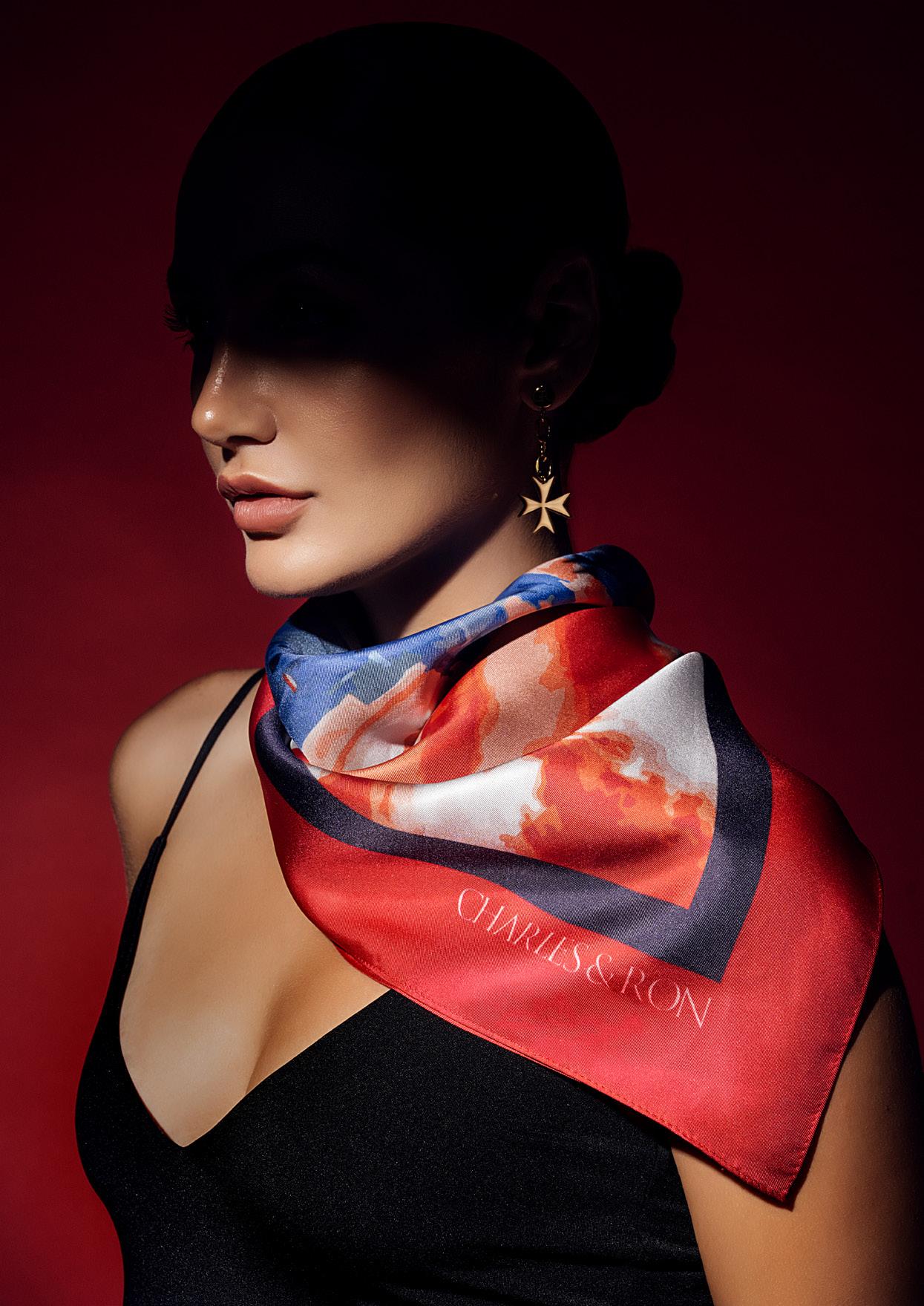
Words by Alexandra Alden

Maltese designer duo
Charles & Ron launch a unique collaborative collection with the national carrier, available only at KM Malta Airline’s airport Sales Office. Be the first to get your hands on these unique pieces as a thoughtful gift to take Malta back home with you – or simply as a memorable treat for yourself.
From this month, travellers will have the opportunity to discover an exclusive new product range, available only at the Sales Office in the Departures area of Malta International Airport, as the country’s iconic fashion house, Charles & Ron, has partnered with the national airline to create a capsule collection that celebrates Maltese culture through fashion.
Following the celebrated refresh of the KM Malta Airlines uniforms last month, this exclusive accessory collection offers travellers the perfect opportunity to take home a piece of that refined new look – a tasteful, elegant gift for a dear friend, or a little something special just for you.
“As a brand, we've always embraced Malta and taken our history and origins on our design journey,” explains Ron, one half of the Charles & Ron fashion house, underlining the cultural roots behind each accessory.


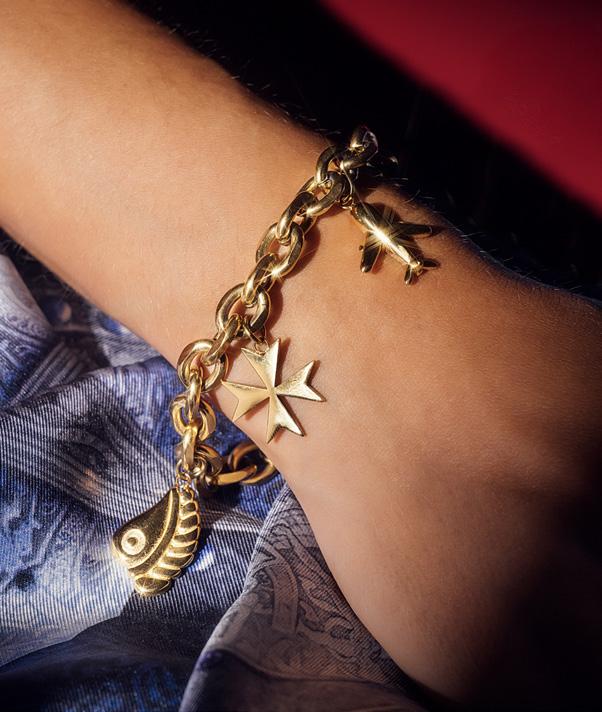
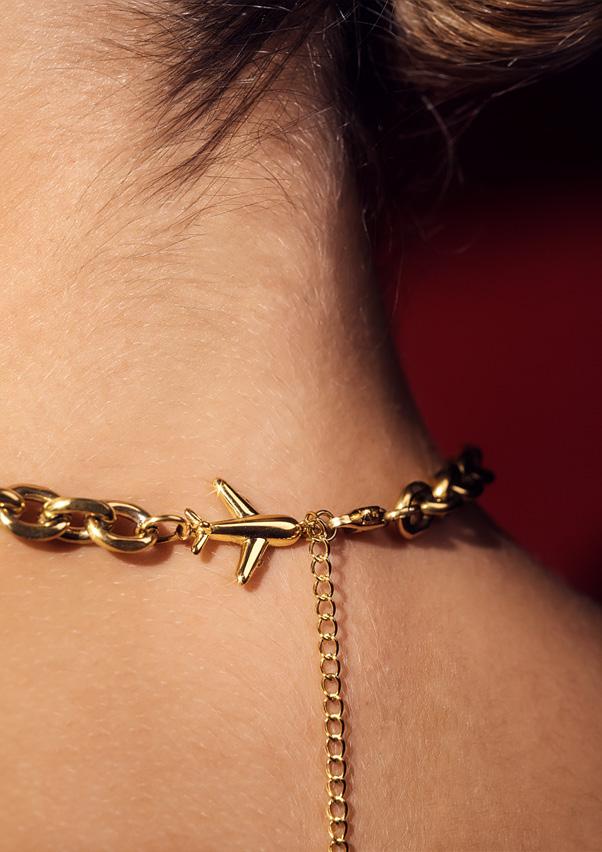
ANOTHER TOUCH OF MALTA JUST BEFORE TAKE-OFF
At the heart of this partnership is a specially designed collection of accessories: two scarves, two ties, and a trio of jewellery pieces, each infused with unmistakable Maltese elements. From Mdina’s skyline to the famed Maltese cross, every item speaks of the island’s heritage in a modern and wearable way.
“This collection is truly close to our hearts,” Ron shares. “Designing for KM Malta Airlines has allowed us to fuse fashion with national identity in a way that feels authentic and accessible.”
The scarves and ties are beautiful accessories, showcasing emblems of Malta’s story. The silk twill scarf, featuring the Mdina landscape, pays tribute to the Silent City's timeless charm, while another scarf draws on the bold, ornate aesthetic of the Knights of Malta Armoury.
For the ties, the Maltese cross takes centre stage in one design, repeated in an elegant pattern of Air Force blue and grey. The second tie channels the rich textures and detail of armoury motifs, adding a layer of historical depth to a modern wardrobe staple.
For Charles & Ron, this collaboration is a way of sharing Malta with the world. “This is how we can promote the country and push talent,” Ron noted in their earlier collaboration with KM.
Perhaps the most personal pieces in the collection are the jewellery items. A charm bracelet brings together aviation elements, Maltese cultural symbols, and the unmistakable C&R touch. The necklace and earrings, crafted from stainless steel and plated with 18kt gold, carry the iconic Maltese cross in subtle, stylish forms.
“The idea was to create something that feels both exclusive and intimate,” explains Ron. “These are keepsakes you take with you; that remind you of Malta long after your flight has landed.”
This exclusive collection will be available for purchase only from the Sales Office in the airport’s Departures area, making it a rare and meaningful souvenir for travellers. Whether you’re gifting a piece to a loved one or treating yourself, each item is a wearable memory; something that connects you to the island, even in the skies.
As KM Malta Airlines reinvents itself with a modern identity rooted in local pride, this offering signals a renewed commitment to showcasing Malta’s cultural richness… at every stage of the journey!


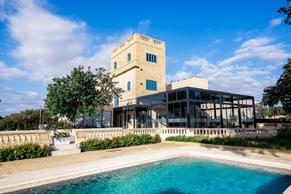
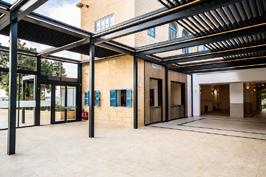

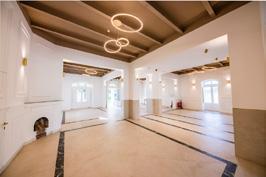




Words by Coryse Borg
Meet the Pace brothers, John-Paul and Steve, whose retro-flavoured food truck, Gemma Joe’s, is as much a tribute to family and heritage as it is a destination for delicious milkshakes and ice cream.
The smell of ice cream mingles with the salty sea breeze. Delighted passers-by in the town of Sliema pause in front of a vintage-style food truck that looks like it drove straight out of a 1950s American postcard.Welcome to Gemma Joe’s.
Behind the counter, serving up Ice Cream Spaceburgers, croffles and award-winning milkshakes, are two brothers with a heart for hospitality and a hunger for creative expression. John-Paul (aka Jay) and Steve Pace – Maltese-Australians with a passion for food – are the very soul of this nostalgic food truck.
The brothers' parents, born in Malta and raised in Sydney, were the original inspiration for their venture. Working long hours at Paddy’s Market, running a street food truck in Sydney in the mid1980s, instilled the values of kindness and resilience in their sons.
“Our parents didn’t have much, but they gave everything –generosity was their currency. That spirit of warm welcomes, cheeky banter and making sure no one walked away hungry lives on through us. We greet regulars by name. We remember
what kids love. We check in with the elderly couple who stop by for their Friday treat. Every moment matters. Hospitality isn’t a job to us – it’s how we were raised.”
Gemma Joe’s, named in honour of their mum and dad, is a living tribute to their spirit. And while the van itself began humbly in Gżira, selling shaved ice and juice, the vision was always grander.
“Gemma Joe’s is built on love, legacy and late nights around a table. But those early days were rough. We had no staff, no real equipment, and no backup plan. We just believed in something bigger than ourselves – this idea of building a place that brought people together through food and feeling.”
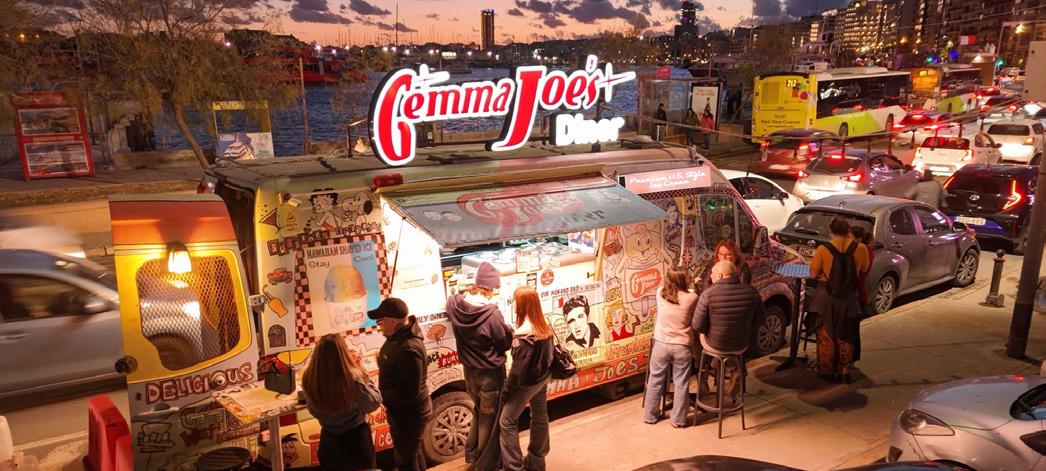
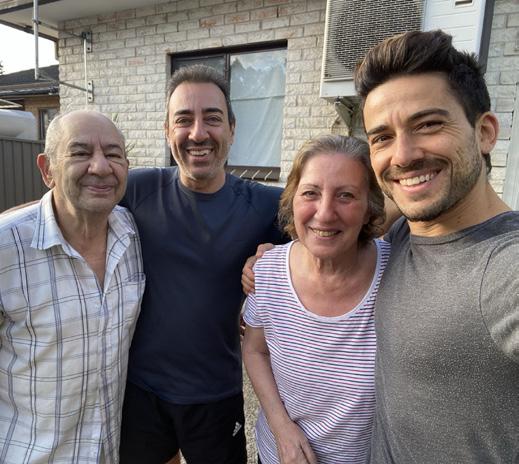
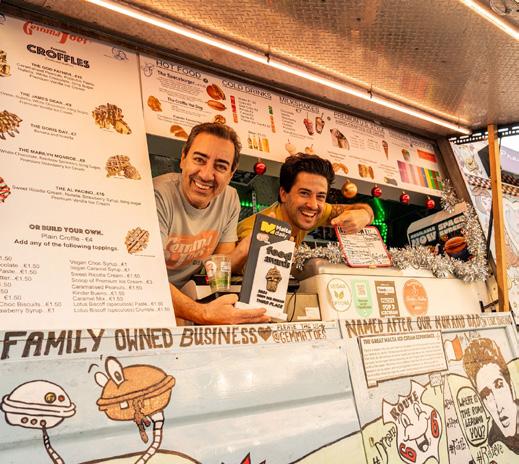

As the powerhouse of Sports betting in Germany and Austria, we are always looking for great talent to join our team.
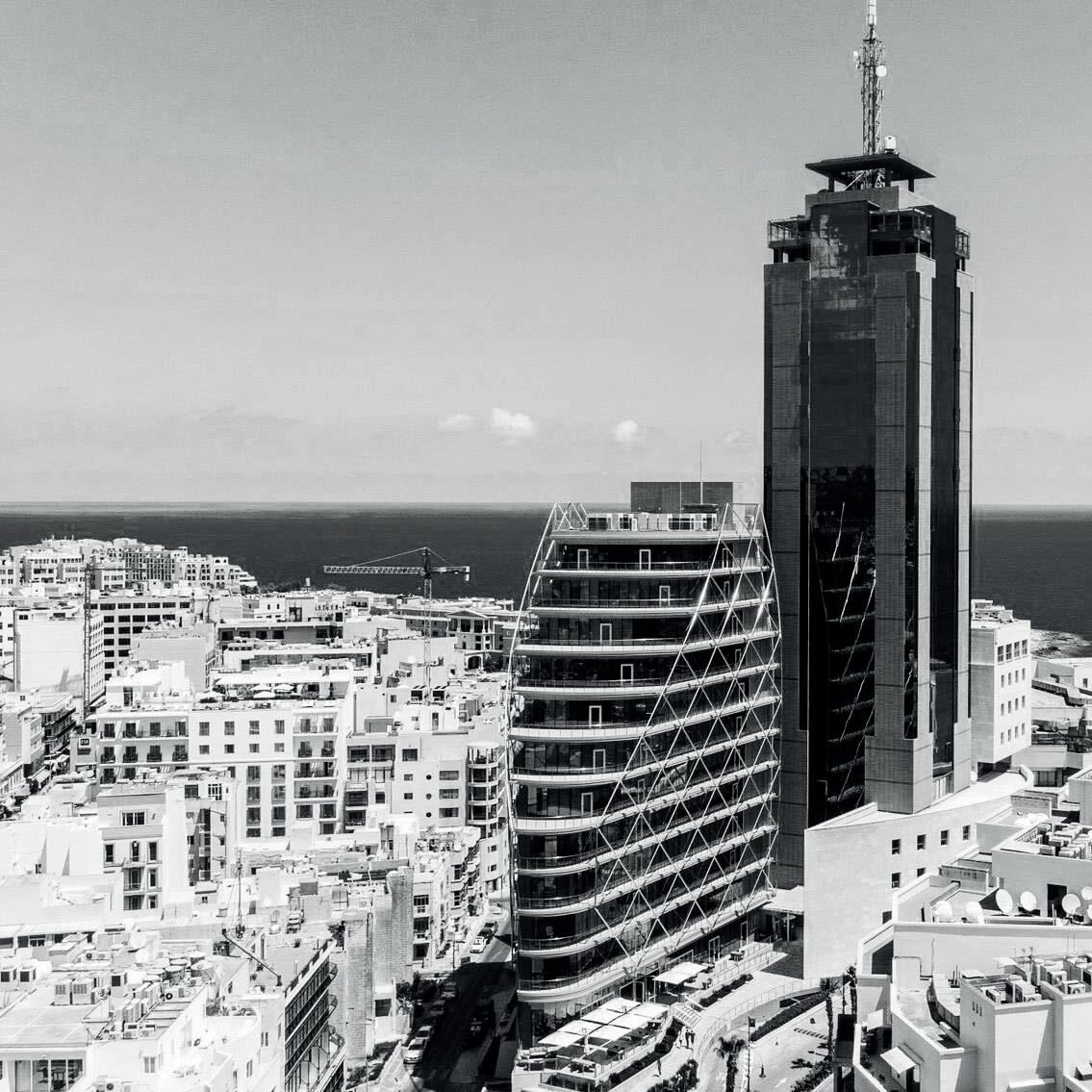



Scan the QR code to see our opportunities.




The brothers’ road to Gemma Joe's was anything but conventional. In his early 20s, Jay left his work as a gym trainer to pursue the craft of acting seriously, studying at NIDA (the National Institute of Dramatic Art) and Screenwise drama school before landing national commercial roles and a part in HBO’s The Pacific. He moved to New York City to train at HB Studios, marking the start of over a decade living between New York, Vancouver, Los Angeles and Sydney.
Steve, meanwhile, spent years on the road as the drummer for super-popular Australian children's music group The Wiggles, joining a vibrant creative force that would see him perform across Australia and contribute to over 25 albums and
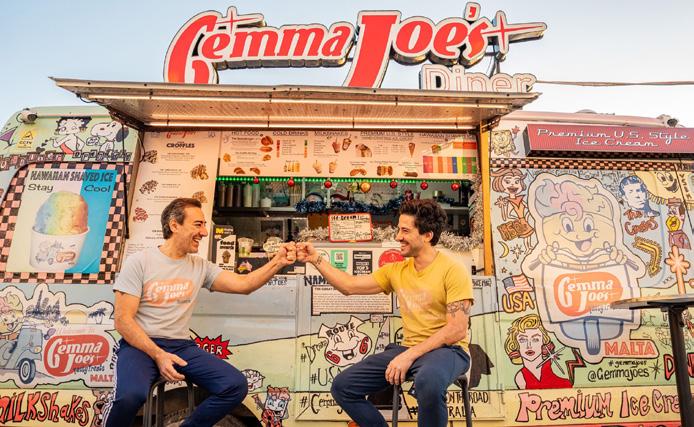

DVDs, many of which went on to win ARIA Music Awards and reach millions of families worldwide.
Both brothers also worked as youth mentors for children in out-of-home care – an experience that profoundly influenced their understanding of empathy, resilience and connection.
“Whether it was on stage or around a table, we’ve always been storytellers,” they say with a smile. “Now, we just happen to tell those stories through food. We’re Maltese by blood, Aussie by birth and American diner dreamers by heart. We never sat down and said: ‘Let’s build a brand!’ We just tried to be honest. To make food that feels like a memory and serve it with heart. That’s how it all fits. That’s how it’s real.”
On Gemma Joe’s menu you’ll find everything from the Ice Cream Spaceburger – a sweet-and-savoury, UFO-


shaped creation, inspired by a 1960s Seattle street-food fad – to croffles (a croissant–waffle hybrid). Then there are my personal favourites: the strawberry and honeycomb scoops.
The point? To make people smile.
“The truth is, we’re just two brothers trying to serve good food with good energy, and to honour our parents while we're at it. Wherever that takes us, we’ll be grateful,” the Paces say.
“We’re not a restaurant. We’re a feeling. And that feeling? You’ll carry it long after you leave.”
Check out their website gemmajoes.com or follow them on Facebook and Instagram.
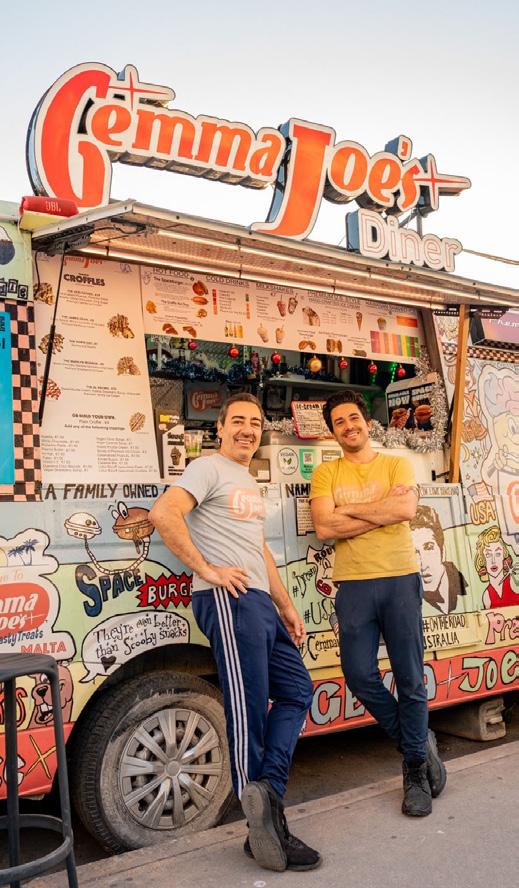
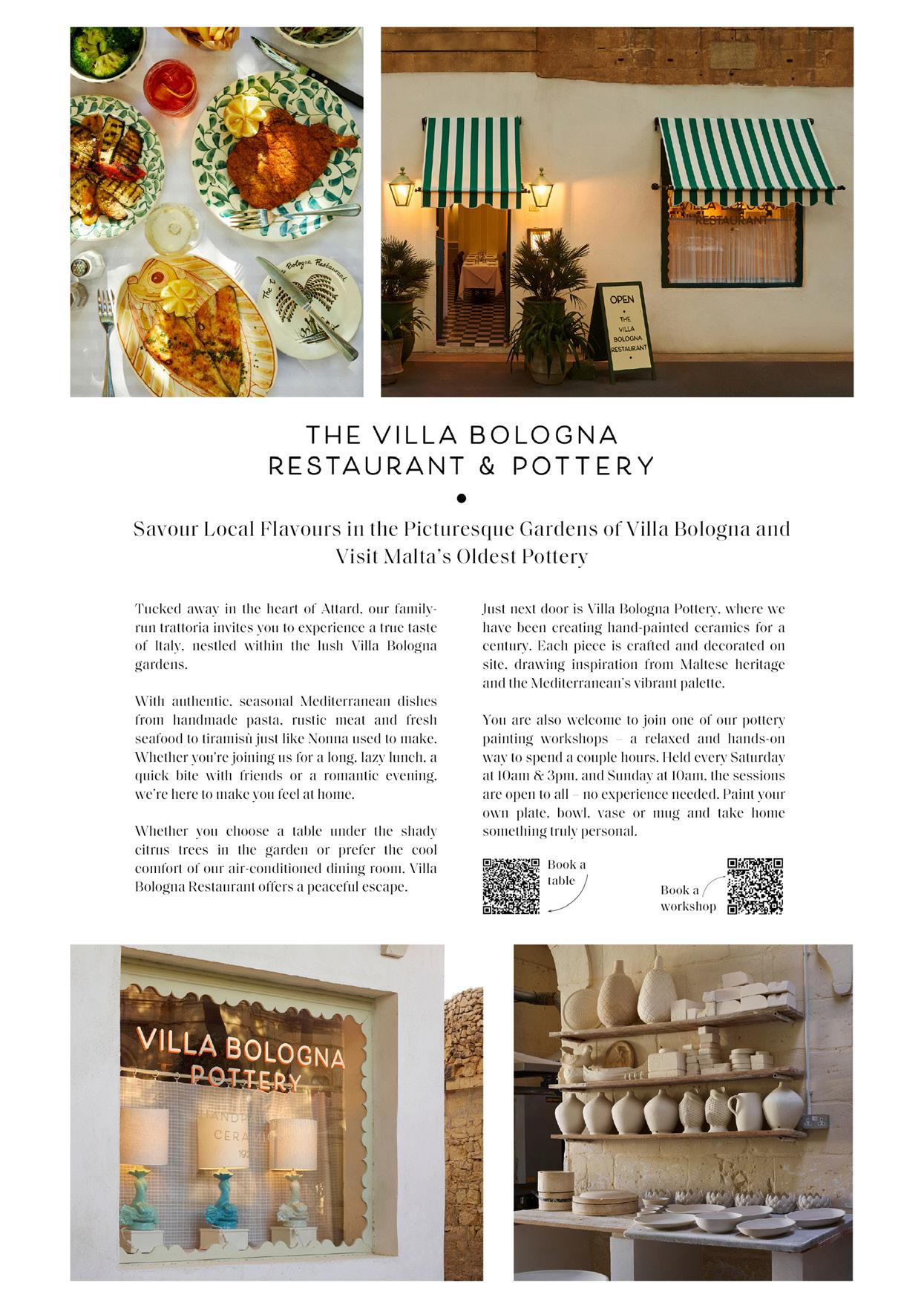

Words by Passaġġi

It is not surprising that Ben Muscat, chef patron of Ta’ Marija, a gastro Maltese kitchen, has been most influenced by local cuisine. Having grown up in the family restaurant his father opened in 1964, it is “in my roots”. Malta is full of flavour and pride – and he is, indeed, proud to be part of what he describes as an innovative, welcoming and buzzing restaurant scene.
WHO DID YOU LEARN MOST FROM IN THE KITCHEN?
A lot of my childhood was spent in our kitchens, both at Palazzo Pescatore, since our first home was actually based there, and also at Ta’ Marija (formerly the Whisper Nightclub). So, my initial training came from our amazing chefs and my parents, Benny and Maria Muscat. My mother’s feminine leadership and vibrant energy left a lasting impression, not only on our kitchen but on the entire familyrun business.
YOUR ALL-TIME FAVOURITE INGREDIENT AND HOW YOU USE IT BEST…
Our locally grown tomatoes, bursting with flavour and a hero in so many Maltese dishes! From the simple but perfect combo of fresh ġbejna with a beefy tomato, basil and virgin olive oil, or our homemade kunserva sweetening tomato sauces for our handmade ravjul, to our sun-dried tomatoes paired with anchovy in my dad’s old Rabat recipe of Sfineġ ta’ l-inċova, the list is endless and delicious.
YOUR GO-TO MEAL TO WIN OVER YOUR FAMILY…
Majjal il-forn, a recipe passed down through generations. It was my ultimate 'welcome home' meal, lovingly prepared by my mother Maria during my student days abroad, and it still works like a charm today. Plenty of roast crackling to keep everyone around the table smiling and fighting over the crispiest bits.
WHO COOKS AT HOME?
My wife Nadine is a passionate cook, who loves trying new recipes, often way outside my usual Maltese repertoire. But with two kids and their ever-changing tastes, it’s a shared mission to keep things
interesting, balanced and edible. Most days, we just aim for something everyone agrees on.
YOUR FAVOURITE COMFORT FOOD…
Froġa tat-Tarja, a tradition from my youth and our Maltese take on spaghetti carbonara, fried and packed with flavour. It’s still my go-to comfort dish and now has pride of place on our menu. A must-try, especially if you’re from my generation.
WHEN YOU EAT OUT, WHAT DO YOU LOOK FOR?
I can be a delightfully curious customer, always noticing the small details. Hospitality is an art, and when it’s done right, from the warm welcome to a properly mixed cocktail, beautiful ambiance and a well-executed dish, it sparks joy and admiration in me, whether it’s a humble café or a fine-dining gem.
DO YOU PASS ON DESSERT?
Definitely not! A great dessert rounds off the palate and finishes the story of a meal. I have a soft spot for anything chocolate and no shame in saying it.
WHAT WOULD YOU NEVER SAY NO TO (FOOD-WISE)?
Foie gras. It brings back memories of travels with my father, from being trolley-served the dish in Cannes to enjoying it at Maxim’s in Paris. A culinary weakness I’ve failed to shake off, not that I’m trying too hard.
BBQS, BRUNCHES, LONG LUNCHES, BOOZY DINNERS, PICNICS, TAPAS, TEATIME? WHAT TYPE OF MEAL TICKLES YOUR TASTE BUDS MOST?
I can enjoy them all when the setting and company are right. But top of the list has to be a well-paced dinner. Aperitivos, paired wines, coffees, liqueurs, and finally, a fine whisky or two. What I call a king’s meal.
COMPLICATED HAUTE CUISINE OR ALLA BUONA HOME COOKING?
I have huge respect for the creativity and precision of haute cuisine, but it’s seasonal, authentic home cooking that wins my heart every time. Soppa tal-armla in winter, lampuki in summer and prinjolata at Carnival – that’s the kind of food that feeds the soul.
HEALTHY OR SINFUL, DECADENT AND RICH?
I lean towards healthy food maybe a few months before summer. The rest of the year, sinful, decadent and rich takes the lead.
THE IDEAL CUSTOMER PROFILE?
Appreciative, adventurous, chatty, open to recommendations, excited to try all courses and happy to bring their family and friends along for regular visits. Oh, and someone who tips with a big thank you – that’s the cherry on top.
WHO WOULD YOU MOST LIKE TO COOK FOR AND WHY?
We’ve served royalty, religious leaders, politicians and the occasional celebrity, so I’m not easily starstruck. But if I had to choose someone, it would be Jimmy Fallon, the Emmy-award-winning host of The Tonight Show and a musical sketch–performing whirlwind of energy. Also, my wife’s not-so-secret crush – she loves comedic geniuses, which explains why I’m her favourite person in real life. I imagine we’d end up with a sing-along, a few laughs over wine and probably dancing on our 1960s dancefloor. Sounds like my kind of dinner party.
THE CUISINE THAT HAS INFLUENCED YOU THE MOST?
Maltese cuisine, no doubt. It’s in my roots, especially having grown up running the family restaurant my father opened in 1964. I had my first trials in the kitchen in the 1970s, and today, we still have regulars who visit us with their fourth-generation families. That kind of continuity is both rare and humbling.
WHERE WOULD YOU TRAVEL TO EAT, AGAIN AND AGAIN?
La Colombe d’Or in St Paul de Vence. Not just for the breathtaking views over the French Riviera or the walls lined with original Picasso paintings, but for their superb cuisine and a front-of-house team whose elegance and experience show in every interaction. A magical place.
WHAT OR WHO INSPIRES YOU WHEN IT COMES TO FOOD?
I’m constantly inspired by local chefs who preserve and elevate Maltese traditions. From a rustic ftira loaded with potatoes, capers and anchovies, to a fresh grilled fish at a village eatery or a hot batch of pastizzi at your local bar, Malta is full of flavour and pride and I’m proud to be part of that.
A CULINARY SECRET YOU CAN SHARE?
I often joke with guests that there’s a secret ingredient I’ll never reveal. But here’s one I’m happy to pass on: my mum’s handwritten recipe for pulpetti tal-laħam. It’s a simple dish she used to prepare on Monday mornings, and yes, I used to steal a few before they hit the table. Still do.
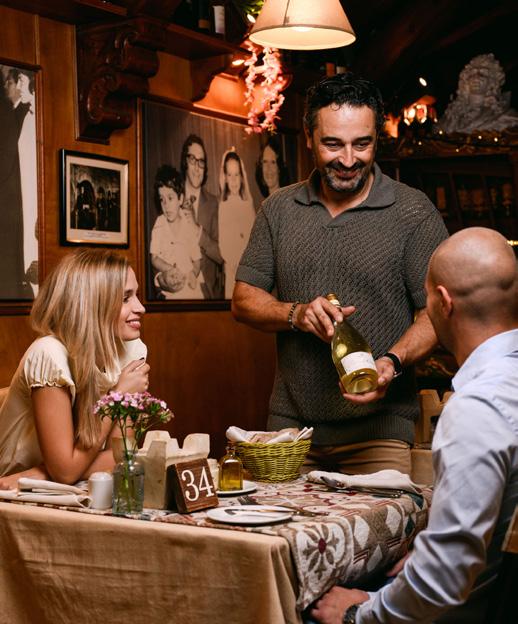
WHAT DO YOU SAY TO SOMEONE WITH NO CONFIDENCE IN THE KITCHEN?
Start with what you enjoy, cook it a few times and gather feedback from your best and kindest eaters. Confidence grows when you focus on progress, not perfection. And remember, even the best chefs burn a few things along the way.
YOUR IDEA OF QUINTESSENTIALLY MALTESE FOOD?
Slow-cooked dishes using natural, local ingredients. Think bebbux bl-arjoli with fresh herbs and Gozo sea salt, homemade ravjul with a rich tomato and basil sauce, fenek moqli braised in local wine and garlic, and gelat tan-nanna made the old-fashioned way with my grandmother Annie’s recipe. That’s real Maltese hospitality on a plate.
YOUR OWN TAKE ON A LOCAL DISH?
Froġa tat-Tarja à la Ben. It starts with the traditional mix of tarja, eggs, bacon, tomatoes, onions, cheese and parsley, crisp-fried to perfection. Then I take it up a notch with a silky saffron sauce made from fresh cream, cream cheese, saffron and tarragon. Finish with melted cheddar and a dusting of sweet paprika under the grill. It’s indulgent. And yes, you’ll come back for more.
THREE WORDS TO DESCRIBE THE MALTESE RESTAURANT SCENE… Innovative, welcoming, buzzing!
SERVES 1 AS A MAIN DISH AND 2-3 AS AN APPETIZER
INGREDIENTS
FOR THE TARJA
100g tarja (or Capellini)
3 eggs
2 tbsp milk
1 tomato, finely chopped
1 onion, finely chopped
2 slices bacon, finely chopped
2 tbsp grated cheese (Romano)
Salt & Pepper
Chopped parsley
Chopped chives
80g Cheddar cheese
1 tsp sweet paprika
FOR THE SAFFRON SAUCE
1 small tub fresh cream
3 tbsp cream cheese
1 tsp saffron
1 tsp tarragon
METHOD
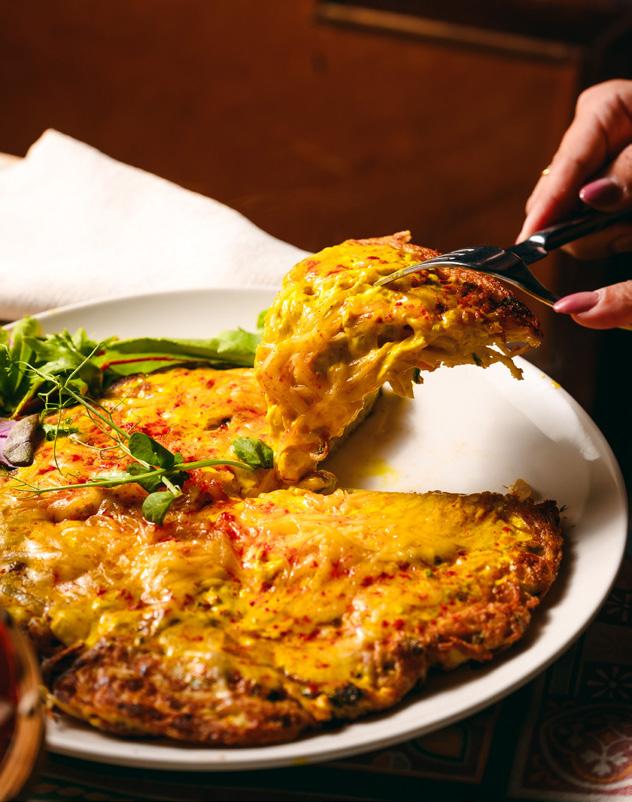
Boil the tarja for three minutes, cool it under cold water and drain it.
In a bowl mix together the beaten egg, milk, finely chopped tomato, onion, bacon, cheese and add the chopped parsley, chives and some seasoning. Drain the pasta and mix with the above ingredients.
Heat a little butter and vegetable oil in a frying pan, add the mixture in and cook for about three minutes.
Turn the froġa for another three minutes until its golden brown.
METHOD FOR THE SAFFRON SAUCE
In a separate small saucepan, mix together the fresh cream, cream cheese, saffron and tarragon, stir well as you heat it on a slow fire and spread on top of the fried froġa.
Add Cheddar cheese and grill for a few minutes until melted. Sprinkle a touch of sweet paprika before serving.
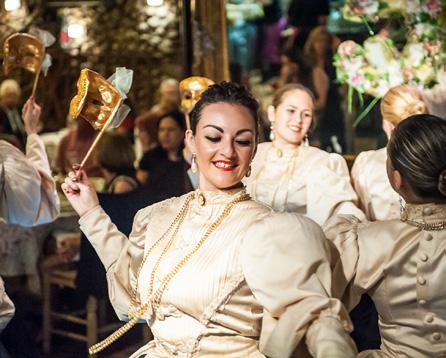
TA’ MARIJA – YOUR GASTRO MALTESE KITCHEN
Constitution Street, Mosta
Established in 1964, Ta’ Marija is one of Malta’s most historically rich restaurants. Enjoy its Folklore Dinner shows on Wednesdays, Fridays and Sundays for some Maltese liveliness. (Transport can be arranged.) The gastro menu is bursting with creativity and local traditions, stamped with Ta’ Marija’s signature flavours. From appetizers and platters to traditional homemade ravioli, Ta' Marija brings Maltese favourites to the table in a unique way. Mains include a popular rabbit selection, fish and shellfish in season, local meats and the famous Whisper chargrilled steaks.
(+356) 2143 4444 tamarija.com TamarijaRestaurantMostaMalta
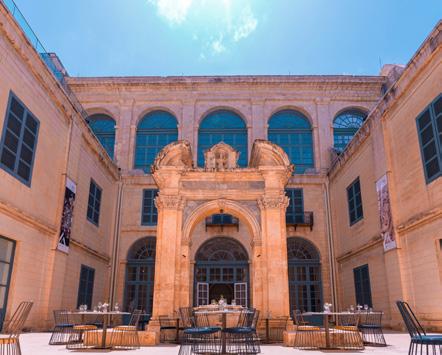


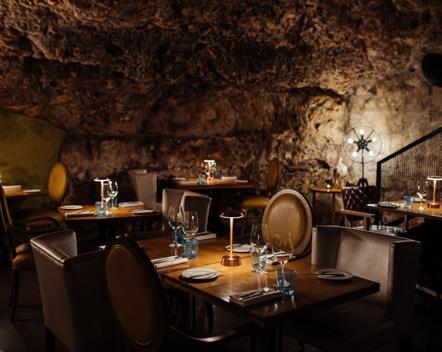
MUŻA RESTAURANT
Merchants Street, Valletta
If you're looking for an extraordinary dining experience in the capital city, book a table at MUŻA Restaurant. Situated in the picturesque courtyard of an old auberge, MUŻA provides a cosy, laidback ambiance, perfect for a romantic dinner, or a night out with friends. The menu is bursting with fresh, local ingredients, and the knowledgeable staff can help you select the perfect wine to complement your meal.
(+356) 7979 0900
MUZARestaurantValletta muzarestaurant
66, Church Street, St Paul’s Bay
Discover Ostrica at Gillieru, where tradition meets innovation on the shores of St Paul’s Bay. Located within the iconic Gillieru Harbour Hotel, a landmark with over a century of history, it celebrates the finest local ingredients from fresh fish to dry-aged meats, prepared with a modern twist. Its talented chefs craft each dish with care, offering an unforgettable dining experience. With stunning views of the bay and a tranquil atmosphere, Ostrica invites you to indulge in Malta’s rich culinary heritage.
(+356) 7902 2371 ostrica.mt ostrica ostrica
BOTTEGIN PALAZZO XARA
Triq San Pawl, Rabat
Tucked away in the heart of Rabat, just a short stroll from the historic Mdina, Bottegin Palazzo Xara offers an authentic Maltese dining experience. Situated within a local band club, the cosy bistro provides a welcoming atmosphere, while the peaceful Mediterranean Courtyard offers a tranquil setting for al fresco dining. The extensive menu features everything from hearty breakfasts to pizzas, pastas, grills and traditional local dishes. With soft jazz music and a vibrant, social atmosphere, it's the perfect place to dine like a local.
(+356) 7945 4538 bottegin.com.mt botteginpalazzoxara botteginpalazzoxara

GROTTO TAVERN
Misraħ Ii-Paroċċa, Rabat
The Michelin-recommended Grotto Tavern restaurant offers a unique and unforgettable dining experience in the heart of Rabat. Nestled in a cave, the ambience is enchanting and romantic. Grotto Tavern’s chefs expertly craft tasting menus that showcase their passion for local and seasonal ingredients. Guests can sample innovative dishes by indulging in its fiveor seven-course experience. A visit to Grotto Tavern is a must for those seeking fine dining with a twist.
(+356) 7945 3258 grottotavern.net grottotavernrestaurant thegrottotavern
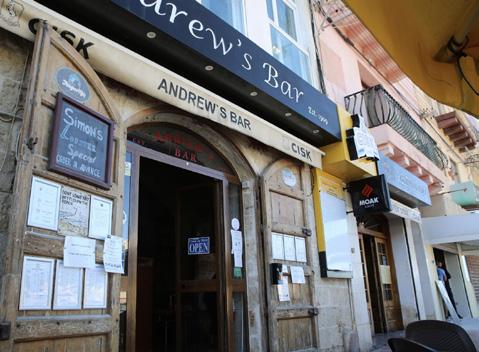
ANDREW’S BAR
St George’s Bay, St Julian’s Andrew's Bar is a freshly re-opened venue where fun is not optional, good food is compulsory, and building great memories is essential. Steeped in legacy, this is, in fact, Malta's oldest bar! The place is a go-to, and you're simply going to love indulging in the extensive menu, with a great local cuisine focus, serving traditional Maltese and modern dishes, such as pizza or pasta. Ideal for breakfast, lunch and dinner, it is also perfect for a quiet drink or two.
(+356) 2138 8031 info@andrewsbar.com
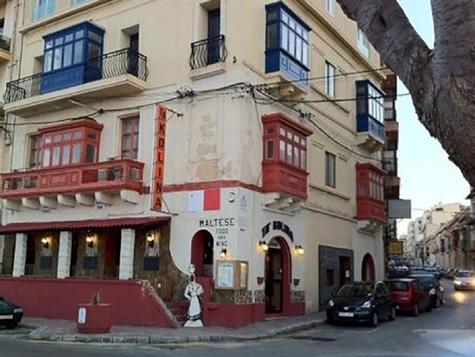
TA' KOLINA
151, Tower Road, Sliema
Ta’ Kolina is a quaint, family-run restaurant on Tower Road (one of Sliema’s most popular spots). Open since 1974, it is a typical Maltese restaurant with a traditional Maltese interior and décor. A set menu comprising of traditional Maltese food offers a choice of starter, main dish, dessert and coffee for €27 per person. There is also a vibrant à la carte menu and daily display of fresh local fish. Dining here is a true Maltese experience for a reasonable price. Ta' Kolina is open for both lunch and dinner from 12 to 10.30pm.
(+356) 2133 5106 www.takolina.mt


Love our sleek Airbus A320neo? Now you can take one home! Visit our Sales Office, found in the Departures area at Malta International Airport, and pick up your very own KM Malta Airlines aircraft model. Choose from two sizes: small (1:200 scale) for just €25; or large (1:100 scale) for €55. It’s perfect for collectors, aviation fans, or as a unique Maltese souvenir.
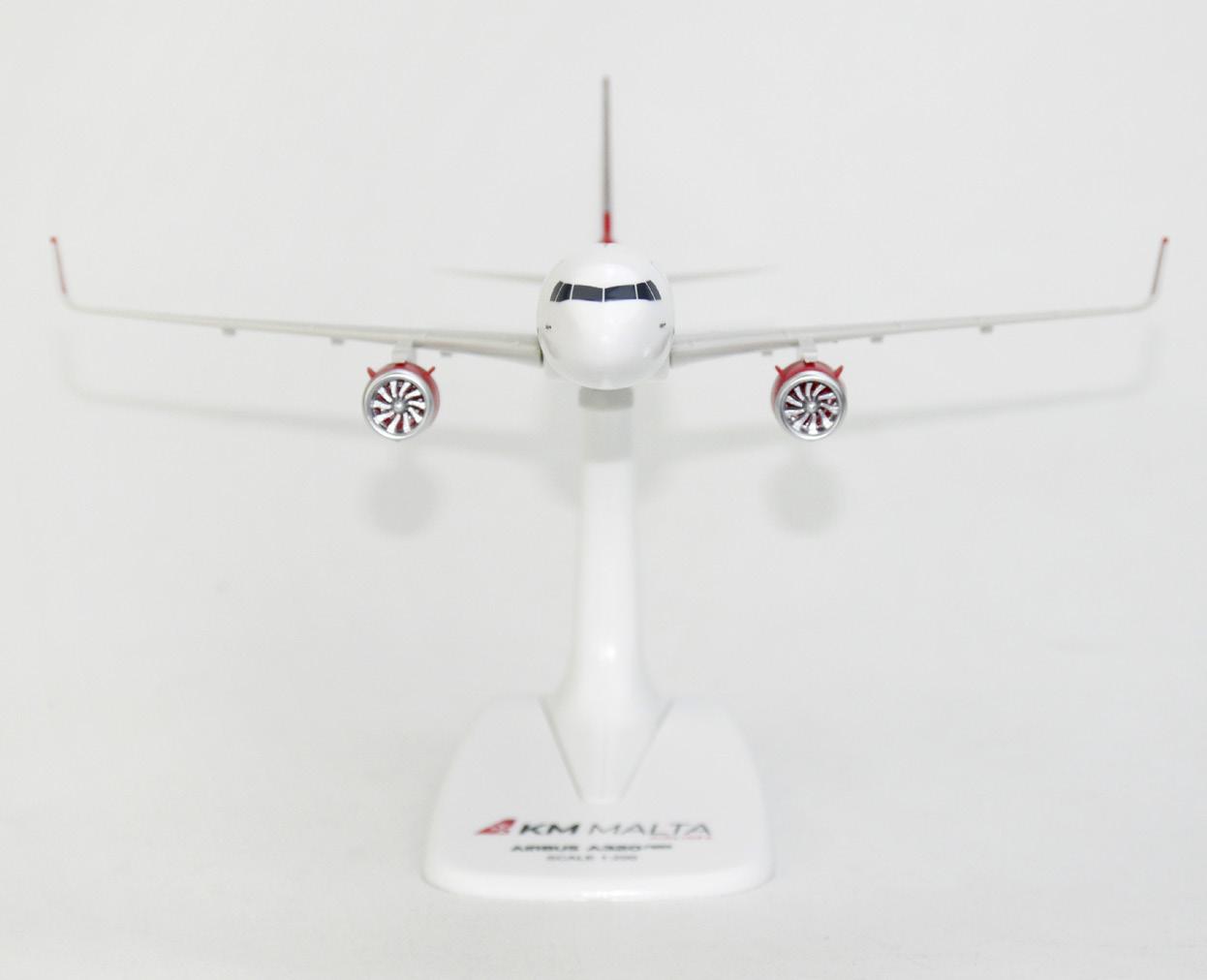
Ready to plan your next trip? Scan the QR code and visit kmmaltairlines.com/flights to find our best travel deals from Malta to all our destinations!
Browse by destination, explore travel inspiration and see the lowest fares available by date –perfect for flexible planners and savvy travellers. Whether it’s a quick escape or your dream holiday, your best deal is just a click away!


Say hello to Marija, our friendly chatbot service, here to make your journey smoother! Available 24/7 on our Customer Support website (help.kmmaltairlines.com), Marija can help answer your most frequently asked questions – from baggage allowances to check-in information and more.
Marija is ready to guide you through your travel needs with instant, reliable support. It’s smart, simple and just another way we can help; anytime, anywhere. And if your query needs a human touch, don’t worry –Marija will seamlessly transfer you to a live agent, available every day from 8am to 8pm.

Discover a world of exclusive benefits with KM Rewards, the loyalty programme designed to make your travels with KM Malta Airlines even more rewarding. Every time you fly, you earn SkyBux, which can be redeemed for flights, extras and more!
Join for free today and start turning your SkyBux into unforgettable journeys. Climb the tiers faster and unlock the exclusive perks of KM Elite – before you can say: "Ready for take-off!"




Just joined KM Rewards? You can still earn on flights flown up to three months before your enrolment date. It’s our way of helping you get the most out of every trip, right from the start.
Log in to your account before you book and let us do the work for you! Your personal details are filled in automatically, saving you time, and making your booking experience smoother than ever. Less typing, more travelling!
Whether you fly often or just once in a while, your SkyBux can help you save on your next trip with KM Malta Airlines.
Use them to save on your flight or to enjoy extras like extra legroom or more baggage. With our easy-to-use slider, you decide how much SkyBux and cash to combine. Your SkyBux are ready to go!

New ways to redeem your SkyBux are on the way – not just for travel, but beyond. Stay tuned!
Amsterdam (AMS)
Berlin (BER)
Brussels (BRU)
Catania (CTA)
Düsseldorf (DUS)
Istanbul (IST)
London (LHR)
London (LGW)
Lyon (LYS)
Madrid (MAD)
Milan (LIN)
Munich (MUC)
Paris (CDG)
Paris (ORY)
Prague (PRG)
Rome (FCO)
Vienna (VIE)
Zurich (ZRH)
We’re excited to have you with us and want to ensure you have a comfortable and enjoyable flight. Here are a few important tips to keep everything smooth and safe for everyone.
Aħna ħerqanin li inti tkun magħna, u rridu nkunu żguri li jkollok titjira komda u pjaċevoli. Hawnhekk issib ftit pariri importanti biex jinżamm kollox pinna u sigur għal kulħadd.
Malta International Airport (MLA), the main hub for KM Malta Airlines, first opened in 1958 as Luqa Airport and has since grown into a modern, world-class facility. Playing a crucial role in connecting the island to hundreds of destinations, MLA supports KM Malta Airlines’ extensive network of flights. Guided by core values, the airport ensures a seamless travel experience for all passengers. By working sustainably and collaboratively with its partners, MLA continues to enhance Malta's connectivity and deliver exceptional service to travellers worldwide.
L-Ajruport Internazzjonali ta’ Malta (MLA), iċ-ċentru ewlieni għall-KM Malta Airlines, fetaħ għall-ewwel darba fl-1958 u minn dakinhar kiber f’faċilità moderna u ta’ klassi dinjija. Bi rwol kruċjali biex jgħaqqad ’il gżiritna ma’ mijiet ta’ destinazzjonijiet, l-MLA jappoġġja x-xibka estensiva tat-titjiriet tal-KM Malta Airlines. Iggwidat minn valuri tal-qalba, l-ajruport jiżgura esperjenza ta’ vjaġġ trankwill għall-passiġġieri kollha. Permezz tal-ħidma sostenibbli u kollaborattiva mal-imsieħba tiegħu, l-MLA jissokta jsaħħaħ l-konnettività ta’ Malta u jagħti servizz eċċezzjonali lill-vjaġġaturi mad-dinja kollha.
OUR FLEET

AIRBUS 320NEO
QUANTITY: 8 IN FLEET
NUMBER OF SEATS: 180
ENGINES: CFM LEAP-1A
MAXIMUM TAKE OFF WEIGHT: 73.5 / 77 METRIC TONS
OVERALL LENGTH: 37.57M
WINGSPAN: 35.8M
CRUISING SPEED: MACH 0.78 (450KNOTS, 833KM/HR)
RANGE: 6,500KM, 3,500 NMI, 4,025 SMI
FUEL CONSUMPTION: 1.8 LITRES PER 100KM PER PASSENGER*
* Based on a 1,000NM (1,860KM) journey with 180 pax and bags.
Your seatbelt is here for your protection! Please fasten it whenever the seatbelt sign is on or while the aircraft is moving. For your safety, we recommend keeping it fastened throughout the flight. If you’re travelling with a child under two, they’ll need to be secured on your lap with an infant seatbelt, which our crew will be happy to provide.
Only alcohol served by our crew is allowed on board, and it’s only for passengers aged 17 and over. Remember, alcohol can have a stronger effect at high altitudes, so please enjoy responsibly. In line with international regulations, we may prevent intoxicated passengers from boarding or continuing their journey.
We want everyone to feel comfortable, so please respect your fellow passengers and crew. Please do not take photos or videos on board without their verbal permission.
For the safety and comfort of everyone, smoking –including e-cigarettes – is strictly prohibited at any time when on board the aircraft. If you see anyone smoking, let our crew know immediately.
Customer satisfaction is of the utmost importance at KM Malta Airlines and we are always looking for ways to improve. Scan the QR code to tell us about your experience and be in with a chance to win a pair of return flights with us!

Iċ-ċinturin tiegħek qiegħed għall-protezzjoni tiegħek! Jekk jogħġbok aqflu kull meta s-sinjal taċ-ċinturin ikun mixgħul jew sakemm ikun miexi l-ajruplan. Għas-sigurtà tiegħek, aħna nirrakkomandaw li żżommu maqful matul it-titjira kollha. Jekk qed tivvjaġġa bl-ulied taħt is-sentejn, dawn għandhom jinżammu fuq ħoġrok b’ċinturin għat-trabi li l-ekwipaġġ ikun kuntent li jagħtik.
Abbord huwa permessibbli biss l-alkoħol servut mill-ekwipaġġ tagħna, u dan qiegħed biss għallpassiġġieri li għandhom 17-il sena jew iktar. Ftakar, f’altitudnijiet għolja l-alkoħol jista’ jkollu effetti aqwa, għalhekk, jekk jogħġbok, ħu gost b’mod responsabbli. Skont ir-regolamenti internazzjonali, nistgħu nipprevjenu lill-passiġġieri fis-sakra milli jitilgħu abbord jew milli jissuktaw bil-vjaġġ tagħhom.
L-ETIKETT TAL-FOTOGRAFIJA
Irridu li kulħadd iħossu komdu, għalhekk, jekk jogħġbok, irrispetta lill-passiġġieri ta’ miegħek u lillekwipaġġ. Jekk jogħġbok tiħux ritratti jew filmati abbord mingħajr il-permess verbali tagħhom.
Għas-sigurtà u l-kumdità ta’ kulħadd, it-tipjip –inklużi s-sigaretti elettroniċi – huwa pprojbit f’kull waqt abbord l-ajruplan. Jekk tara lil xi ħadd ipejjep, għarraf lill-ekwipaġġ tagħna minnufih.
Is-sodisfazzjon tal-klijent huwa tal-ogħla importanza għall-KM Malta Airlines u b’hekk aħna dejjem infittxu modi kif intejbu dan. Skennja l-kodiċi QR biex tgħidilna iktar dwar l-esperjenza tiegħek u idħol fiċ-ċans li tirbaħ magħna żewġ biljetti bir-ritorn!
Most portable electronic devices (PEDs) are equipped with powerful lithium batteries. Under certain conditions, these can overheat and catch fire. By following these instructions, you will be enhancing safety on board our aircraft. Monitor your PEDs during the flight and protect them from damage and unintentional activation. E-cigarettes and power banks can be easily activated and raise their temperature quickly. Keep them on your person if you can, and do not place them next to flammable items such as perfume when in hand baggage. Power banks are not to be used or charged during the flight.
Any devices that can send or receive data by wireless means, such as smartphones, tablets and e-readers must be switched to flight mode before departure and can be used throughout the flight. If data transmission capability cannot be switched off while the device is operating, the device itself must be switched off completely for the duration of the flight. Bluetooth connectivity can be used during all phases of flight.
These should be turned off and stowed away during taxi, take-off and landing, but you’re free to use them during the cruise.
The use of Wi-Fi with flight mode enabled is allowed on aircraft which are equipped with an in-flight entertainment system. Follow any crew instructions regarding connectivity.
Headphones may be used during all phases of flight, however we ask you to remove them during the safety briefing. Customers sitting in an emergency exit row must refrain from using headphones during taxi, take-off and landing.
If any device is damaged, starts to overheat or produces smoke, is lost or falls into the seat structure, please notify our crew immediately. Do not try to retrieve it yourself if it falls between seats; we’ll take care of it. Carriage of damaged, defective or recalled lithium batteries or devices is prohibited on board our flights.
We kindly ask that all passengers follow these guidelines for the safety and comfort of everyone on board. Have a fantastic flight with KM Malta Airlines!
Ħafna mill-PEDs huma mgħammra b’batteriji b’saħħithom tal-litju. Meta jkunu taħt ċerti kundizzjonijiet dawn jistgħu jisħnu żżejjed u jieħdu n-nar. Jekk issegwi dawn l-istruzzjonijiet, inti tkun qed issaħħaħ is-sigurtà abbord l-ajruplani tagħna. Osserva l-PEDs tiegħek matul ittitjira u pproteġihom mill-ħsara u milli jixegħlu b’mod mhux intenzjonat. Is-sigaretti elettroniċi u l-power banks jistgħu jixegħlu faċilment u t-temperatura tagħhom tista’ tiżdidilhom malajr. Jekk tista’ żommhom fuqek, u tqegħedhomx ħdejn oġġetti li jieħdu n-nar bħal fwieħa meta dawn ikunu fil-bagalja tal-idejn. Il-power banks m’għandhomx jintużaw jew jiġu ċċarġjati matul it-titjira.
Kwalunkwe tagħmir elettroniku li jista’ jibgħat jew jirċievi d-data mingħajr il-ħtieġa ta’ wajer, bħall-ismartphones, it-tablets u l-e-readers għandhom jinqalbu għall-modalità tat-titjira qabel it-tluq, u hekk jistgħu jintużaw matul ittitjira kollha. Jekk il-funzjoni tat-trasmissjoni tad-data ma tistax tintefa waqt li t-tagħmir elettroniku jkun mixgħul, it-tagħmir innifsu għandu jintefa għalkollox tul it-titjira kollha. Il-konnettività tal-Bluetooth tista’ tintuża tul il-fażijiet kollha tat-titjira.
Dawn għandhom jintfew u jintrefgħu matul is-sewqan, it-tlugħ u l-inżul, iżda tista’ tużahom b’mod liberu tul il-kruċiera.
L-użu tal-Wi-Fi bil-modalità tat-titjira mixgħula huwa permessibbli fuq l-ajruplani mgħammra bis-sistema taddivertiment ta’ matul it-titjira. Segwi kull istruzzjoni talekwipaġġ rigward il-konnettività.
Il-headphones jistgħu jintużaw tul il-fażijiet kollha tat-titjira, madankollu nitolbuk tneħħihom waqt l-ispjegazzjoni tas-sigurtà. Il-klijenti bilqiegħda f’xi filliera tal-ħruġ tal-emerġenza m’għandhomx jużaw ilheadphones matul is-sewqan, it-tlugħ u l-inżul.
JEW LI JKUN SAĦAN IŻŻEJJED Jekk xi tagħmir elettroniku jkollu l-ħsara, jibda jisħon jew idaħħan, jintilef jew jaqa’ fl-istruttura tal-pultruna, jekk jogħġbok għarraf lill-ekwipaġġ tagħna minnufih. Tippruvax issibu inti jekk jaqa’ bejn il-pultruni; nieħdu ħsiebu aħna. Il-ġarr ta’ batteriji tal-litju jew tagħmir elettroniku bil-ħsara, difettuż jew wieħed li ntalab jinġabar lura huwa pprojbit abbord it-titjiriet tagħna.
Ġentilment nitolbu li l-passiġġieri kollha jsegwu dawn il-linji gwida għas-sigurtà u l-kumdità ta’ kulħadd abbord. Nixtiqulek titjira fantastika mal-KM Malta Airlines!
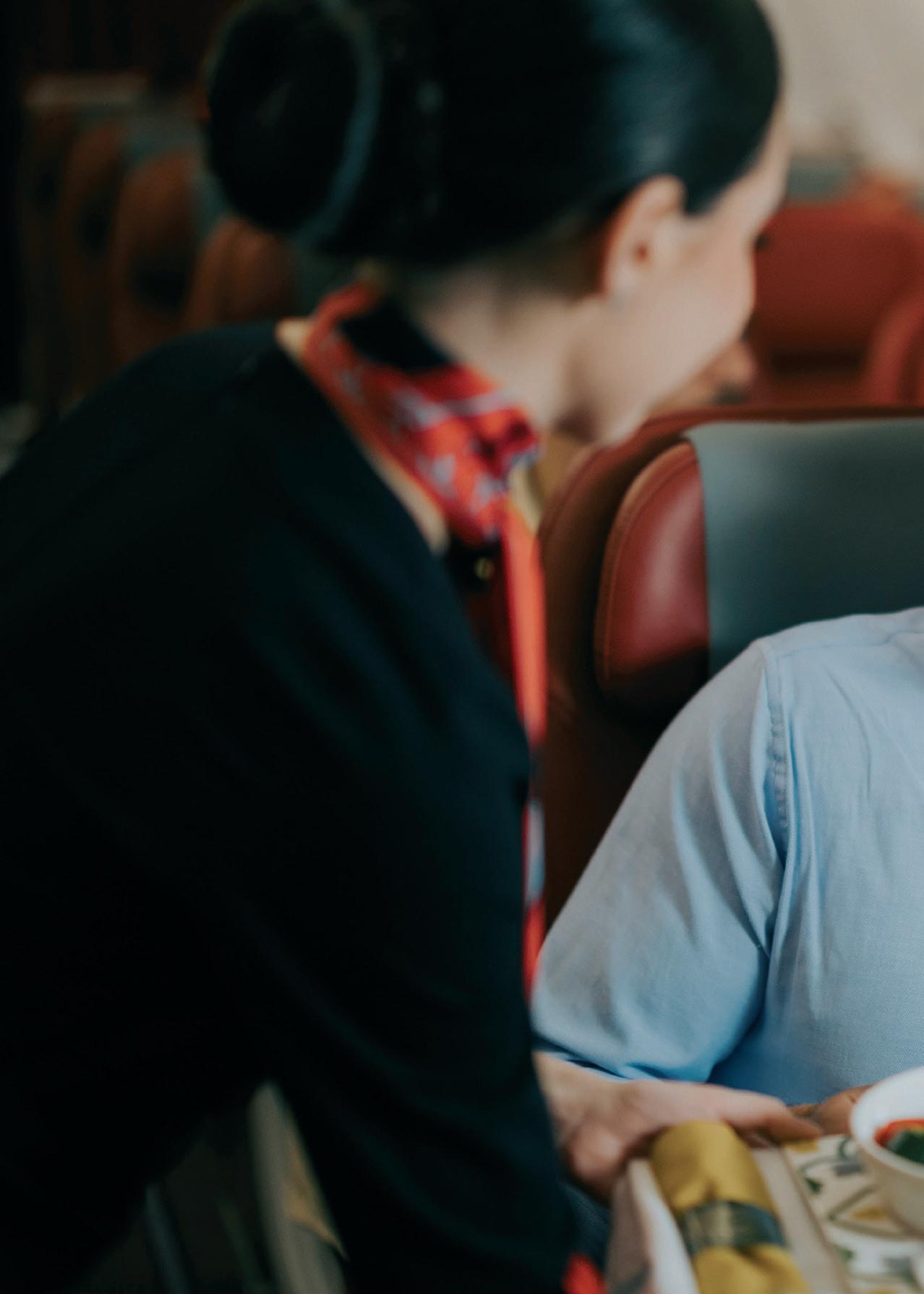


OVER 150 BRANDS under one roof

OPEN EVERY DAY. MONDAY TO SUNDAY 10:00AM – 7.30PM.